
matplotlib.axes¶matplotlib.axes.Axes(fig, rect, axisbg=None, frameon=True, sharex=None, sharey=None, label='', xscale=None, yscale=None, **kwargs)¶The Axes contains most of the figure elements:
Axis, Tick,
Line2D, Text,
Polygon, etc., and sets the
coordinate system.
The Axes instance supports callbacks through a callbacks
attribute which is a CallbackRegistry
instance. The events you can connect to are ‘xlim_changed’ and
‘ylim_changed’ and the callback will be called with func(ax)
where ax is the Axes instance.
acorr(x, **kwargs)¶Plot the autocorrelation of x.
| Parameters: | x : sequence of scalar hold : boolean, optional, default: True detrend : callable, optional, default:
normed : boolean, optional, default: True
usevlines : boolean, optional, default: True
maxlags : integer, optional, default: 10
|
|---|---|
| Returns: | (lags, c, line, b) : where:
|
| Other Parameters: | |
linestyle :
marker : string, optional, default: ‘o’ |
|
Notes
In addition to the above described arguments, this function can take a data keyword argument. If such a data argument is given, the following arguments are replaced by data[<arg>]:
Examples
xcorr is top graph, and
acorr is bottom graph.
(Source code, png)
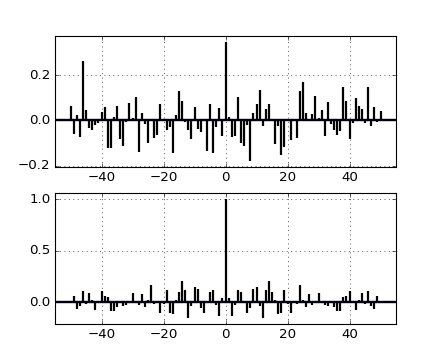
add_artist(a)¶Add any Artist to the axes.
Use add_artist only for artists for which there is no dedicated
“add” method; and if necessary, use a method such as
update_datalim or update_datalim_numerix to manually update the
dataLim if the artist is to be included in autoscaling.
Returns the artist.
add_callback(func)¶Adds a callback function that will be called whenever one of
the Artist‘s properties changes.
Returns an id that is useful for removing the callback with
remove_callback() later.
add_collection(collection, autolim=True)¶Add a Collection instance
to the axes.
Returns the collection.
add_container(container)¶Add a Container instance
to the axes.
Returns the collection.
add_patch(p)¶Add a Patch p to the list of
axes patches; the clipbox will be set to the Axes clipping
box. If the transform is not set, it will be set to
transData.
Returns the patch.
add_table(tab)¶Add a Table instance to the
list of axes tables
Returns the table.
aname = 'Artist'¶angle_spectrum(x, Fs=None, Fc=None, window=None, pad_to=None, sides=None, **kwargs)¶Plot the angle spectrum.
Call signature:
angle_spectrum(x, Fs=2, Fc=0, window=mlab.window_hanning,
pad_to=None, sides='default', **kwargs)
Compute the angle spectrum (wrapped phase spectrum) of x. Data is padded to a length of pad_to and the windowing function window is applied to the signal.
- x: 1-D array or sequence
- Array or sequence containing the data
Keyword arguments:
- Fs: scalar
- The sampling frequency (samples per time unit). It is used to calculate the Fourier frequencies, freqs, in cycles per time unit. The default value is 2.
- window: callable or ndarray
- A function or a vector of length NFFT. To create window vectors see
window_hanning(),window_none(),numpy.blackman(),numpy.hamming(),numpy.bartlett(),scipy.signal(),scipy.signal.get_window(), etc. The default iswindow_hanning(). If a function is passed as the argument, it must take a data segment as an argument and return the windowed version of the segment.- sides: [ ‘default’ | ‘onesided’ | ‘twosided’ ]
- Specifies which sides of the spectrum to return. Default gives the default behavior, which returns one-sided for real data and both for complex data. ‘onesided’ forces the return of a one-sided spectrum, while ‘twosided’ forces two-sided.
The number of points to which the data segment is padded when performing the FFT. While not increasing the actual resolution of the spectrum (the minimum distance between resolvable peaks), this can give more points in the plot, allowing for more detail. This corresponds to the n parameter in the call to fft(). The default is None, which sets pad_to equal to the length of the input signal (i.e. no padding).
Returns the tuple (spectrum, freqs, line):
- spectrum: 1-D array
- The values for the angle spectrum in radians (real valued)
- freqs: 1-D array
- The frequencies corresponding to the elements in spectrum
- line: a
Line2Dinstance- The line created by this function
kwargs control the Line2D properties:
Property Description agg_filterunknown alphafloat (0.0 transparent through 1.0 opaque) animated[True | False] antialiasedor aa[True | False] axesan Axesinstancebottom_marginunknown clip_boxa matplotlib.transforms.Bboxinstanceclip_on[True | False] clip_path[ ( Path,Transform) |Patch| None ]coloror cany matplotlib color containsa callable function dash_capstyle[‘butt’ | ‘round’ | ‘projecting’] dash_joinstyle[‘miter’ | ‘round’ | ‘bevel’] dashessequence of on/off ink in points drawstyle[‘default’ | ‘steps’ | ‘steps-pre’ | ‘steps-mid’ | ‘steps-post’] figurea matplotlib.figure.Figureinstancefillstyle[‘full’ | ‘left’ | ‘right’ | ‘bottom’ | ‘top’ | ‘none’] gidan id string labelstring or anything printable with ‘%s’ conversion. left_marginunknown linestyleor ls[‘solid’ | ‘dashed’, ‘dashdot’, ‘dotted’ | (offset, on-off-dash-seq) | '-'|'--'|'-.'|':'|'None'|' '|'']linewidthor lwfloat value in points marginsunknown markerA valid marker stylemarkeredgecoloror mecany matplotlib color markeredgewidthor mewfloat value in points markerfacecoloror mfcany matplotlib color markerfacecoloraltor mfcaltany matplotlib color markersizeor msfloat markevery[None | int | length-2 tuple of int | slice | list/array of int | float | length-2 tuple of float] path_effectsunknown pickerfloat distance in points or callable pick function fn(artist, event)pickradiusfloat distance in points rasterized[True | False | None] right_marginunknown sketch_paramsunknown snapunknown solid_capstyle[‘butt’ | ‘round’ | ‘projecting’] solid_joinstyle[‘miter’ | ‘round’ | ‘bevel’] top_marginunknown transforma matplotlib.transforms.Transforminstanceurla url string visible[True | False] xdata1D array ydata1D array zorderany number
Example:
(Source code, png)
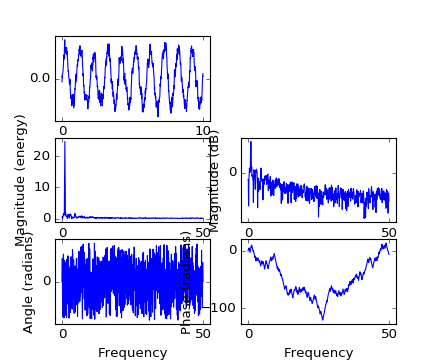
See also
magnitude_spectrum()angle_spectrum() plots the magnitudes of the
corresponding frequencies.phase_spectrum()phase_spectrum() plots the unwrapped version of this
function.specgram()specgram() can plot the angle spectrum of segments
within the signal in a colormap.Notes
In addition to the above described arguments, this function can take a data keyword argument. If such a data argument is given, the following arguments are replaced by data[<arg>]:
annotate(*args, **kwargs)¶Create an annotation: a piece of text referring to a data point.
| Parameters: | s : string
xy : (x, y)
xytext : (x, y) , optional, default: None
xycoords : string, optional, default: “data”
textcoords : string, optional, default: None
arrowprops :
|
|---|---|
| Returns: | a : |
Notes
arrowprops, if not None, is a dictionary of line properties
(see matplotlib.lines.Line2D) for the arrow that connects
annotation to the point.
If the dictionary has a key arrowstyle, a
FancyArrowPatch instance is created with
the given dictionary and is drawn. Otherwise, a
YAArrow patch instance is created and
drawn. Valid keys for YAArrow are:
| Key | Description |
|---|---|
| width | the width of the arrow in points |
| frac | the fraction of the arrow length occupied by the head |
| headwidth | the width of the base of the arrow head in points |
| shrink | oftentimes it is convenient to have the arrowtip
and base a bit away from the text and point being
annotated. If d is the distance between the text and
annotated point, shrink will shorten the arrow so the tip
and base are shink percent of the distance d away from
the endpoints. i.e., shrink=0.05 is 5% |
| ? | any key for matplotlib.patches.polygon |
Valid keys for FancyArrowPatch are:
| Key | Description |
|---|---|
| arrowstyle | the arrow style |
| connectionstyle | the connection style |
| relpos | default is (0.5, 0.5) |
| patchA | default is bounding box of the text |
| patchB | default is None |
| shrinkA | default is 2 points |
| shrinkB | default is 2 points |
| mutation_scale | default is text size (in points) |
| mutation_aspect | default is 1. |
| ? | any key for matplotlib.patches.PathPatch |
xycoords and textcoords are strings that indicate the coordinates of xy and xytext, and may be one of the following values:
| Property | Description |
|---|---|
| ‘figure points’ | points from the lower left corner of the figure |
| ‘figure pixels’ | pixels from the lower left corner of the figure |
| ‘figure fraction’ | 0,0 is lower left of figure and 1,1 is upper right |
| ‘axes points’ | points from lower left corner of axes |
| ‘axes pixels’ | pixels from lower left corner of axes |
| ‘axes fraction’ | 0,0 is lower left of axes and 1,1 is upper right |
| ‘data’ | use the coordinate system of the object being annotated (default) |
| ‘offset points’ | Specify an offset (in points) from the xy value |
| ‘polar’ | you can specify theta, r for the annotation, even in cartesian plots. Note that if you are using a polar axes, you do not need to specify polar for the coordinate system since that is the native “data” coordinate system. |
If a ‘points’ or ‘pixels’ option is specified, values will be added to the bottom-left and if negative, values will be subtracted from the top-right. e.g.:
# 10 points to the right of the left border of the axes and
# 5 points below the top border
xy=(10,-5), xycoords='axes points'
You may use an instance of
Transform or
Artist. See
Annotating Axes for more details.
The annotation_clip attribute controls the visibility of the
annotation when it goes outside the axes area. If True, the
annotation will only be drawn when the xy is inside the
axes. If False, the annotation will always be drawn
regardless of its position. The default is None, which
behave as True only if xycoords is “data”.
Additional kwargs are Text properties:
Property Description agg_filterunknown alphafloat (0.0 transparent through 1.0 opaque) animated[True | False] axesan Axesinstancebackgroundcolorany matplotlib color bboxFancyBboxPatch prop dict bottom_marginunknown clip_boxa matplotlib.transforms.Bboxinstanceclip_on[True | False] clip_path[ ( Path,Transform) |Patch| None ]colorany matplotlib color containsa callable function familyor fontfamily or fontname or name[FONTNAME | ‘serif’ | ‘sans-serif’ | ‘cursive’ | ‘fantasy’ | ‘monospace’ ] figurea matplotlib.figure.Figureinstancefontpropertiesor font_propertiesa matplotlib.font_manager.FontPropertiesinstancegidan id string horizontalalignmentor ha[ ‘center’ | ‘right’ | ‘left’ ] labelstring or anything printable with ‘%s’ conversion. left_marginunknown linespacingfloat (multiple of font size) marginsunknown multialignment[‘left’ | ‘right’ | ‘center’ ] path_effectsunknown picker[None|float|boolean|callable] position(x,y) rasterized[True | False | None] right_marginunknown rotation[ angle in degrees | ‘vertical’ | ‘horizontal’ ] rotation_modeunknown sizeor fontsize[size in points | ‘xx-small’ | ‘x-small’ | ‘small’ | ‘medium’ | ‘large’ | ‘x-large’ | ‘xx-large’ ] sketch_paramsunknown snapunknown stretchor fontstretch[a numeric value in range 0-1000 | ‘ultra-condensed’ | ‘extra-condensed’ | ‘condensed’ | ‘semi-condensed’ | ‘normal’ | ‘semi-expanded’ | ‘expanded’ | ‘extra-expanded’ | ‘ultra-expanded’ ] styleor fontstyle[ ‘normal’ | ‘italic’ | ‘oblique’] textstring or anything printable with ‘%s’ conversion. top_marginunknown transformTransforminstanceurla url string usetexunknown variantor fontvariant[ ‘normal’ | ‘small-caps’ ] verticalalignmentor va or ma[ ‘center’ | ‘top’ | ‘bottom’ | ‘baseline’ ] visible[True | False] weightor fontweight[a numeric value in range 0-1000 | ‘ultralight’ | ‘light’ | ‘normal’ | ‘regular’ | ‘book’ | ‘medium’ | ‘roman’ | ‘semibold’ | ‘demibold’ | ‘demi’ | ‘bold’ | ‘heavy’ | ‘extra bold’ | ‘black’ ] wrapunknown xfloat yfloat zorderany number
Examples
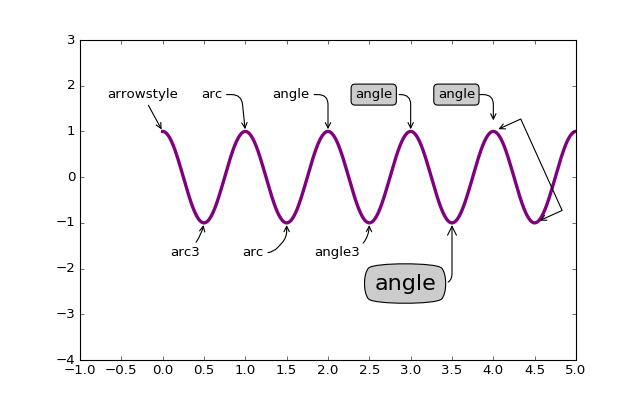
(png)
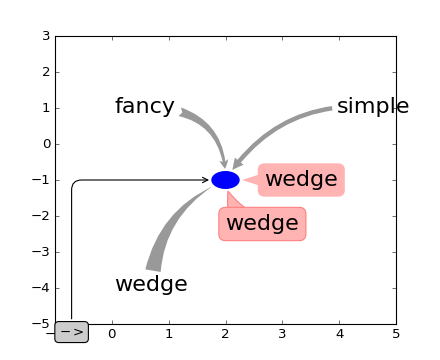
(png)
apply_aspect(position=None)¶Use _aspect() and _adjustable() to modify the
axes box or the view limits.
arrow(x, y, dx, dy, **kwargs)¶Add an arrow to the axes.
Call signature:
arrow(x, y, dx, dy, **kwargs)
Draws arrow on specified axis from (x, y) to (x + dx, y + dy). Uses FancyArrow patch to construct the arrow.
The resulting arrow is affected by the axes aspect ratio and limits.
This may produce an arrow whose head is not square with its stem. To
create an arrow whose head is square with its stem, use
annotate() for example:
ax.annotate("", xy=(0.5, 0.5), xytext=(0, 0),
arrowprops=dict(arrowstyle="->"))
Optional kwargs control the arrow construction and properties:
Other valid kwargs (inherited from Patch) are:
Property Description agg_filterunknown alphafloat or None animated[True | False] antialiasedor aa[True | False] or None for default axesan Axesinstancebottom_marginunknown capstyle[‘butt’ | ‘round’ | ‘projecting’] clip_boxa matplotlib.transforms.Bboxinstanceclip_on[True | False] clip_path[ ( Path,Transform) |Patch| None ]colormatplotlib color spec containsa callable function edgecoloror ecmpl color spec, or None for default, or ‘none’ for no color facecoloror fcmpl color spec, or None for default, or ‘none’ for no color figurea matplotlib.figure.Figureinstancefill[True | False] gidan id string hatch[‘/’ | ‘\’ | ‘|’ | ‘-‘ | ‘+’ | ‘x’ | ‘o’ | ‘O’ | ‘.’ | ‘*’] joinstyle[‘miter’ | ‘round’ | ‘bevel’] labelstring or anything printable with ‘%s’ conversion. left_marginunknown linestyleor ls[‘solid’ | ‘dashed’, ‘dashdot’, ‘dotted’ | (offset, on-off-dash-seq) | '-'|'--'|'-.'|':'|'None'|' '|'']linewidthor lwfloat or None for default marginsunknown path_effectsunknown picker[None|float|boolean|callable] rasterized[True | False | None] right_marginunknown sketch_paramsunknown snapunknown top_marginunknown transformTransforminstanceurla url string visible[True | False] zorderany number
Example:
(Source code, png)
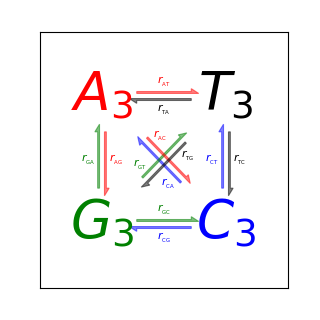
autoscale(enable=True, axis='both', tight=None)¶Autoscale the axis view to the data (toggle).
Convenience method for simple axis view autoscaling. It turns autoscaling on or off, and then, if autoscaling for either axis is on, it performs the autoscaling on the specified axis or axes.
Returns None.
autoscale_view(tight=None, scalex=True, scaley=True)¶Autoscale the view limits using the data limits. You can selectively autoscale only a single axis, e.g., the xaxis by setting scaley to False. The autoscaling preserves any axis direction reversal that has already been done.
The data limits are not updated automatically when artist data are
changed after the artist has been added to an Axes instance. In that
case, use matplotlib.axes.Axes.relim() prior to calling
autoscale_view.
axhline(y=0, xmin=0, xmax=1, **kwargs)¶Add a horizontal line across the axis.
| Parameters: | y : scalar, optional, default: 0
xmin : scalar, optional, default: 0
xmax : scalar, optional, default: 1
|
|---|---|
| Returns: |
See also
axhspanNotes
kwargs are passed to Line2D and can be used
to control the line properties.
Examples
draw a thick red hline at ‘y’ = 0 that spans the xrange:
>>> axhline(linewidth=4, color='r')
draw a default hline at ‘y’ = 1 that spans the xrange:
>>> axhline(y=1)
draw a default hline at ‘y’ = .5 that spans the middle half of the xrange:
>>> axhline(y=.5, xmin=0.25, xmax=0.75)
Valid kwargs are Line2D properties,
with the exception of ‘transform’:
Property Description agg_filterunknown alphafloat (0.0 transparent through 1.0 opaque) animated[True | False] antialiasedor aa[True | False] axesan Axesinstancebottom_marginunknown clip_boxa matplotlib.transforms.Bboxinstanceclip_on[True | False] clip_path[ ( Path,Transform) |Patch| None ]coloror cany matplotlib color containsa callable function dash_capstyle[‘butt’ | ‘round’ | ‘projecting’] dash_joinstyle[‘miter’ | ‘round’ | ‘bevel’] dashessequence of on/off ink in points drawstyle[‘default’ | ‘steps’ | ‘steps-pre’ | ‘steps-mid’ | ‘steps-post’] figurea matplotlib.figure.Figureinstancefillstyle[‘full’ | ‘left’ | ‘right’ | ‘bottom’ | ‘top’ | ‘none’] gidan id string labelstring or anything printable with ‘%s’ conversion. left_marginunknown linestyleor ls[‘solid’ | ‘dashed’, ‘dashdot’, ‘dotted’ | (offset, on-off-dash-seq) | '-'|'--'|'-.'|':'|'None'|' '|'']linewidthor lwfloat value in points marginsunknown markerA valid marker stylemarkeredgecoloror mecany matplotlib color markeredgewidthor mewfloat value in points markerfacecoloror mfcany matplotlib color markerfacecoloraltor mfcaltany matplotlib color markersizeor msfloat markevery[None | int | length-2 tuple of int | slice | list/array of int | float | length-2 tuple of float] path_effectsunknown pickerfloat distance in points or callable pick function fn(artist, event)pickradiusfloat distance in points rasterized[True | False | None] right_marginunknown sketch_paramsunknown snapunknown solid_capstyle[‘butt’ | ‘round’ | ‘projecting’] solid_joinstyle[‘miter’ | ‘round’ | ‘bevel’] top_marginunknown transforma matplotlib.transforms.Transforminstanceurla url string visible[True | False] xdata1D array ydata1D array zorderany number
axhspan(ymin, ymax, xmin=0, xmax=1, **kwargs)¶Add a horizontal span (rectangle) across the axis.
Call signature:
axhspan(ymin, ymax, xmin=0, xmax=1, **kwargs)
y coords are in data units and x coords are in axes (relative 0-1) units.
Draw a horizontal span (rectangle) from ymin to ymax.
With the default values of xmin = 0 and xmax = 1, this
always spans the xrange, regardless of the xlim settings, even
if you change them, e.g., with the set_xlim() command.
That is, the horizontal extent is in axes coords: 0=left,
0.5=middle, 1.0=right but the y location is in data
coordinates.
Return value is a matplotlib.patches.Polygon
instance.
Examples:
draw a gray rectangle from y = 0.25-0.75 that spans the horizontal extent of the axes:
>>> axhspan(0.25, 0.75, facecolor='0.5', alpha=0.5)
Valid kwargs are Polygon properties:
Property Description agg_filterunknown alphafloat or None animated[True | False] antialiasedor aa[True | False] or None for default axesan Axesinstancebottom_marginunknown capstyle[‘butt’ | ‘round’ | ‘projecting’] clip_boxa matplotlib.transforms.Bboxinstanceclip_on[True | False] clip_path[ ( Path,Transform) |Patch| None ]colormatplotlib color spec containsa callable function edgecoloror ecmpl color spec, or None for default, or ‘none’ for no color facecoloror fcmpl color spec, or None for default, or ‘none’ for no color figurea matplotlib.figure.Figureinstancefill[True | False] gidan id string hatch[‘/’ | ‘\’ | ‘|’ | ‘-‘ | ‘+’ | ‘x’ | ‘o’ | ‘O’ | ‘.’ | ‘*’] joinstyle[‘miter’ | ‘round’ | ‘bevel’] labelstring or anything printable with ‘%s’ conversion. left_marginunknown linestyleor ls[‘solid’ | ‘dashed’, ‘dashdot’, ‘dotted’ | (offset, on-off-dash-seq) | '-'|'--'|'-.'|':'|'None'|' '|'']linewidthor lwfloat or None for default marginsunknown path_effectsunknown picker[None|float|boolean|callable] rasterized[True | False | None] right_marginunknown sketch_paramsunknown snapunknown top_marginunknown transformTransforminstanceurla url string visible[True | False] zorderany number
Example:
(Source code, png)
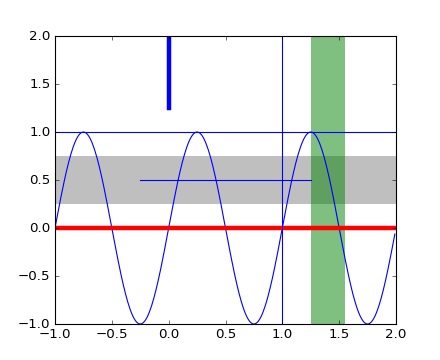
axis(*v, **kwargs)¶Set axis properties.
Valid signatures:
xmin, xmax, ymin, ymax = axis()
xmin, xmax, ymin, ymax = axis(list_arg)
xmin, xmax, ymin, ymax = axis(string_arg)
xmin, xmax, ymin, ymax = axis(**kwargs)
| Parameters: | v : list of float or {‘on’, ‘off’, ‘equal’, ‘tight’, ‘scaled’, ‘normal’, ‘auto’, ‘image’, ‘square’}
emit : bool, optional
xmin, ymin, xmax, ymax : float, optional
|
||||||||||||||||||||
|---|---|---|---|---|---|---|---|---|---|---|---|---|---|---|---|---|---|---|---|---|---|
| Returns: | xmin, xmax, ymin, ymax : float
|
axvline(x=0, ymin=0, ymax=1, **kwargs)¶Add a vertical line across the axes.
| Parameters: | x : scalar, optional, default: 0
ymin : scalar, optional, default: 0
ymax : scalar, optional, default: 1
|
|---|---|
| Returns: |
See also
axhspanExamples
draw a thick red vline at x = 0 that spans the yrange:
>>> axvline(linewidth=4, color='r')
draw a default vline at x = 1 that spans the yrange:
>>> axvline(x=1)
draw a default vline at x = .5 that spans the middle half of the yrange:
>>> axvline(x=.5, ymin=0.25, ymax=0.75)
Valid kwargs are Line2D properties,
with the exception of ‘transform’:
Property Description agg_filterunknown alphafloat (0.0 transparent through 1.0 opaque) animated[True | False] antialiasedor aa[True | False] axesan Axesinstancebottom_marginunknown clip_boxa matplotlib.transforms.Bboxinstanceclip_on[True | False] clip_path[ ( Path,Transform) |Patch| None ]coloror cany matplotlib color containsa callable function dash_capstyle[‘butt’ | ‘round’ | ‘projecting’] dash_joinstyle[‘miter’ | ‘round’ | ‘bevel’] dashessequence of on/off ink in points drawstyle[‘default’ | ‘steps’ | ‘steps-pre’ | ‘steps-mid’ | ‘steps-post’] figurea matplotlib.figure.Figureinstancefillstyle[‘full’ | ‘left’ | ‘right’ | ‘bottom’ | ‘top’ | ‘none’] gidan id string labelstring or anything printable with ‘%s’ conversion. left_marginunknown linestyleor ls[‘solid’ | ‘dashed’, ‘dashdot’, ‘dotted’ | (offset, on-off-dash-seq) | '-'|'--'|'-.'|':'|'None'|' '|'']linewidthor lwfloat value in points marginsunknown markerA valid marker stylemarkeredgecoloror mecany matplotlib color markeredgewidthor mewfloat value in points markerfacecoloror mfcany matplotlib color markerfacecoloraltor mfcaltany matplotlib color markersizeor msfloat markevery[None | int | length-2 tuple of int | slice | list/array of int | float | length-2 tuple of float] path_effectsunknown pickerfloat distance in points or callable pick function fn(artist, event)pickradiusfloat distance in points rasterized[True | False | None] right_marginunknown sketch_paramsunknown snapunknown solid_capstyle[‘butt’ | ‘round’ | ‘projecting’] solid_joinstyle[‘miter’ | ‘round’ | ‘bevel’] top_marginunknown transforma matplotlib.transforms.Transforminstanceurla url string visible[True | False] xdata1D array ydata1D array zorderany number
axvspan(xmin, xmax, ymin=0, ymax=1, **kwargs)¶Add a vertical span (rectangle) across the axes.
Call signature:
axvspan(xmin, xmax, ymin=0, ymax=1, **kwargs)
x coords are in data units and y coords are in axes (relative 0-1) units.
Draw a vertical span (rectangle) from xmin to xmax. With
the default values of ymin = 0 and ymax = 1, this always
spans the yrange, regardless of the ylim settings, even if you
change them, e.g., with the set_ylim() command. That is,
the vertical extent is in axes coords: 0=bottom, 0.5=middle,
1.0=top but the y location is in data coordinates.
Return value is the matplotlib.patches.Polygon
instance.
Examples:
draw a vertical green translucent rectangle from x=1.25 to 1.55 that spans the yrange of the axes:
>>> axvspan(1.25, 1.55, facecolor='g', alpha=0.5)
Valid kwargs are Polygon
properties:
Property Description agg_filterunknown alphafloat or None animated[True | False] antialiasedor aa[True | False] or None for default axesan Axesinstancebottom_marginunknown capstyle[‘butt’ | ‘round’ | ‘projecting’] clip_boxa matplotlib.transforms.Bboxinstanceclip_on[True | False] clip_path[ ( Path,Transform) |Patch| None ]colormatplotlib color spec containsa callable function edgecoloror ecmpl color spec, or None for default, or ‘none’ for no color facecoloror fcmpl color spec, or None for default, or ‘none’ for no color figurea matplotlib.figure.Figureinstancefill[True | False] gidan id string hatch[‘/’ | ‘\’ | ‘|’ | ‘-‘ | ‘+’ | ‘x’ | ‘o’ | ‘O’ | ‘.’ | ‘*’] joinstyle[‘miter’ | ‘round’ | ‘bevel’] labelstring or anything printable with ‘%s’ conversion. left_marginunknown linestyleor ls[‘solid’ | ‘dashed’, ‘dashdot’, ‘dotted’ | (offset, on-off-dash-seq) | '-'|'--'|'-.'|':'|'None'|' '|'']linewidthor lwfloat or None for default marginsunknown path_effectsunknown picker[None|float|boolean|callable] rasterized[True | False | None] right_marginunknown sketch_paramsunknown snapunknown top_marginunknown transformTransforminstanceurla url string visible[True | False] zorderany number
See also
axhspan()bar(left, height, width=0.8, bottom=None, **kwargs)¶Make a bar plot.
Make a bar plot with rectangles bounded by:
left,left+width,bottom,bottom+height- (left, right, bottom and top edges)
| Parameters: | left : sequence of scalars
height : sequence of scalars
width : scalar or array-like, optional
bottom : scalar or array-like, optional
color : scalar or array-like, optional
edgecolor : scalar or array-like, optional
linewidth : scalar or array-like, optional
tick_label : string or array-like, optional
xerr : scalar or array-like, optional
yerr : scalar or array-like, optional
ecolor : scalar or array-like, optional
capsize : scalar, optional
error_kw : dict, optional
align : {‘edge’, ‘center’}, optional
orientation : {‘vertical’, ‘horizontal’}, optional
log : boolean, optional
|
|---|---|
| Returns: | bars : matplotlib.container.BarContainer
|
See also
barhNotes
In addition to the above described arguments, this function can take a data keyword argument. If such a data argument is given, the following arguments are replaced by data[<arg>]:
Examples
Example: A stacked bar chart.
(Source code, png)
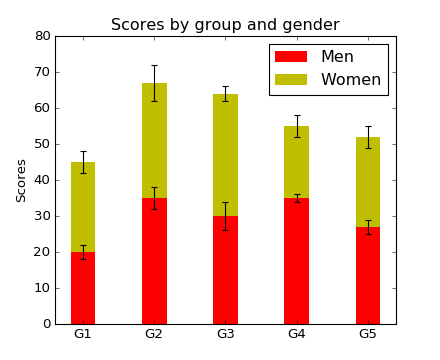
barbs(*args, **kw)¶Plot a 2-D field of barbs.
Call signatures:
barb(U, V, **kw)
barb(U, V, C, **kw)
barb(X, Y, U, V, **kw)
barb(X, Y, U, V, C, **kw)
Arguments:
- X, Y:
- The x and y coordinates of the barb locations (default is head of barb; see pivot kwarg)
- U, V:
- Give the x and y components of the barb shaft
- C:
- An optional array used to map colors to the barbs
All arguments may be 1-D or 2-D arrays or sequences. If X and Y
are absent, they will be generated as a uniform grid. If U and V
are 2-D arrays but X and Y are 1-D, and if len(X) and len(Y)
match the column and row dimensions of U, then X and Y will be
expanded with numpy.meshgrid().
U, V, C may be masked arrays, but masked X, Y are not supported at present.
Keyword arguments:
- length:
- Length of the barb in points; the other parts of the barb are scaled against this. Default is 9
- pivot: [ ‘tip’ | ‘middle’ ]
- The part of the arrow that is at the grid point; the arrow rotates about this point, hence the name pivot. Default is ‘tip’
- barbcolor: [ color | color sequence ]
- Specifies the color all parts of the barb except any flags. This parameter is analagous to the edgecolor parameter for polygons, which can be used instead. However this parameter will override facecolor.
- flagcolor: [ color | color sequence ]
- Specifies the color of any flags on the barb. This parameter is analagous to the facecolor parameter for polygons, which can be used instead. However this parameter will override facecolor. If this is not set (and C has not either) then flagcolor will be set to match barbcolor so that the barb has a uniform color. If C has been set, flagcolor has no effect.
- sizes:
A dictionary of coefficients specifying the ratio of a given feature to the length of the barb. Only those values one wishes to override need to be included. These features include:
- ‘spacing’ - space between features (flags, full/half barbs)
- ‘height’ - height (distance from shaft to top) of a flag or full barb
- ‘width’ - width of a flag, twice the width of a full barb
- ‘emptybarb’ - radius of the circle used for low magnitudes
- fill_empty:
- A flag on whether the empty barbs (circles) that are drawn should be filled with the flag color. If they are not filled, they will be drawn such that no color is applied to the center. Default is False
- rounding:
- A flag to indicate whether the vector magnitude should be rounded when allocating barb components. If True, the magnitude is rounded to the nearest multiple of the half-barb increment. If False, the magnitude is simply truncated to the next lowest multiple. Default is True
- barb_increments:
A dictionary of increments specifying values to associate with different parts of the barb. Only those values one wishes to override need to be included.
- ‘half’ - half barbs (Default is 5)
- ‘full’ - full barbs (Default is 10)
- ‘flag’ - flags (default is 50)
- flip_barb:
- Either a single boolean flag or an array of booleans. Single boolean indicates whether the lines and flags should point opposite to normal for all barbs. An array (which should be the same size as the other data arrays) indicates whether to flip for each individual barb. Normal behavior is for the barbs and lines to point right (comes from wind barbs having these features point towards low pressure in the Northern Hemisphere.) Default is False
Barbs are traditionally used in meteorology as a way to plot the speed and direction of wind observations, but can technically be used to plot any two dimensional vector quantity. As opposed to arrows, which give vector magnitude by the length of the arrow, the barbs give more quantitative information about the vector magnitude by putting slanted lines or a triangle for various increments in magnitude, as show schematically below:
: /\ \
: / \ \
: / \ \ \
: / \ \ \
: ------------------------------
The largest increment is given by a triangle (or “flag”). After those come full lines (barbs). The smallest increment is a half line. There is only, of course, ever at most 1 half line. If the magnitude is small and only needs a single half-line and no full lines or triangles, the half-line is offset from the end of the barb so that it can be easily distinguished from barbs with a single full line. The magnitude for the barb shown above would nominally be 65, using the standard increments of 50, 10, and 5.
linewidths and edgecolors can be used to customize the barb.
Additional PolyCollection keyword
arguments:
Property Description agg_filterunknown alphafloat or None animated[True | False] antialiasedor antialiasedsBoolean or sequence of booleans arrayunknown axesan Axesinstancebottom_marginunknown clima length 2 sequence of floats clip_boxa matplotlib.transforms.Bboxinstanceclip_on[True | False] clip_path[ ( Path,Transform) |Patch| None ]cmapa colormap or registered colormap name colormatplotlib color arg or sequence of rgba tuples containsa callable function edgecoloror edgecolorsmatplotlib color spec or sequence of specs facecoloror facecolorsmatplotlib color spec or sequence of specs figurea matplotlib.figure.Figureinstancegidan id string hatch[ ‘/’ | ‘\’ | ‘|’ | ‘-‘ | ‘+’ | ‘x’ | ‘o’ | ‘O’ | ‘.’ | ‘*’ ] labelstring or anything printable with ‘%s’ conversion. left_marginunknown linestyleor dashes or linestyles[‘solid’ | ‘dashed’, ‘dashdot’, ‘dotted’ | (offset, on-off-dash-seq) | '-'|'--'|'-.'|':'|'None'|' '|'']linewidthor linewidths or lwfloat or sequence of floats marginsunknown normunknown offset_positionunknown offsetsfloat or sequence of floats path_effectsunknown picker[None|float|boolean|callable] pickradiusunknown rasterized[True | False | None] right_marginunknown sketch_paramsunknown snapunknown top_marginunknown transformTransforminstanceurla url string urlsunknown visible[True | False] zorderany number
Example:
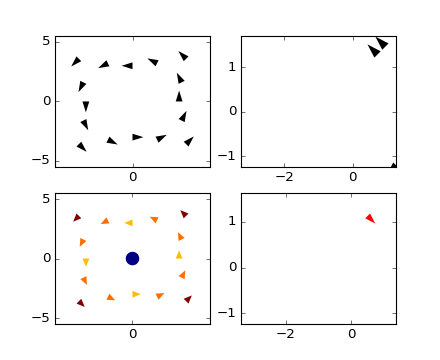
(png)
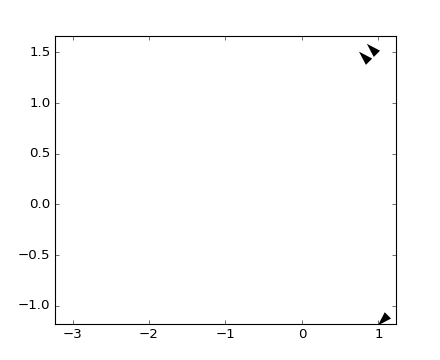
(png)
Notes
In addition to the above described arguments, this function can take a data keyword argument. If such a data argument is given, the following arguments are replaced by data[<arg>]:
barh(bottom, width, height=0.8, left=None, **kwargs)¶Make a horizontal bar plot.
Make a horizontal bar plot with rectangles bounded by:
left,left+width,bottom,bottom+height- (left, right, bottom and top edges)
bottom, width, height, and left can be either scalars
or sequences
| Parameters: | bottom : scalar or array-like
width : scalar or array-like
height : sequence of scalars, optional, default: 0.8
left : sequence of scalars
|
|---|---|
| Returns: |
|
| Other Parameters: | |
color : scalar or array-like, optional
edgecolor : scalar or array-like, optional
linewidth : scalar or array-like, optional, default: None
tick_label : string or array-like, optional, default: None
xerr : scalar or array-like, optional, default: None
yerr : scalar or array-like, optional, default: None
ecolor : scalar or array-like, optional, default: None
capsize : scalar, optional
error_kw :
align : [‘edge’ | ‘center’], optional, default: ‘edge’
log : boolean, optional, default: False
|
|
See also
barNotes
The optional arguments color, edgecolor, linewidth,
xerr, and yerr can be either scalars or sequences of
length equal to the number of bars. This enables you to use
bar as the basis for stacked bar charts, or candlestick plots.
Detail: xerr and yerr are passed directly to
errorbar(), so they can also have shape 2xN for
independent specification of lower and upper errors.
Other optional kwargs:
Property Description agg_filterunknown alphafloat or None animated[True | False] antialiasedor aa[True | False] or None for default axesan Axesinstancebottom_marginunknown capstyle[‘butt’ | ‘round’ | ‘projecting’] clip_boxa matplotlib.transforms.Bboxinstanceclip_on[True | False] clip_path[ ( Path,Transform) |Patch| None ]colormatplotlib color spec containsa callable function edgecoloror ecmpl color spec, or None for default, or ‘none’ for no color facecoloror fcmpl color spec, or None for default, or ‘none’ for no color figurea matplotlib.figure.Figureinstancefill[True | False] gidan id string hatch[‘/’ | ‘\’ | ‘|’ | ‘-‘ | ‘+’ | ‘x’ | ‘o’ | ‘O’ | ‘.’ | ‘*’] joinstyle[‘miter’ | ‘round’ | ‘bevel’] labelstring or anything printable with ‘%s’ conversion. left_marginunknown linestyleor ls[‘solid’ | ‘dashed’, ‘dashdot’, ‘dotted’ | (offset, on-off-dash-seq) | '-'|'--'|'-.'|':'|'None'|' '|'']linewidthor lwfloat or None for default marginsunknown path_effectsunknown picker[None|float|boolean|callable] rasterized[True | False | None] right_marginunknown sketch_paramsunknown snapunknown top_marginunknown transformTransforminstanceurla url string visible[True | False] zorderany number
bottom_margin¶Get whether a margin should be applied to the bottom of the Artist.
boxplot(x, notch=None, sym=None, vert=None, whis=None, positions=None, widths=None, patch_artist=None, bootstrap=None, usermedians=None, conf_intervals=None, meanline=None, showmeans=None, showcaps=None, showbox=None, showfliers=None, boxprops=None, labels=None, flierprops=None, medianprops=None, meanprops=None, capprops=None, whiskerprops=None, manage_xticks=True)¶Make a box and whisker plot.
Call signature:
boxplot(self, x, notch=None, sym=None, vert=None, whis=None,
positions=None, widths=None, patch_artist=False,
bootstrap=None, usermedians=None, conf_intervals=None,
meanline=False, showmeans=False, showcaps=True,
showbox=True, showfliers=True, boxprops=None, labels=None,
flierprops=None, medianprops=None, meanprops=None,
capprops=None, whiskerprops=None, manage_xticks=True):
Make a box and whisker plot for each column of x or each vector in sequence x. The box extends from the lower to upper quartile values of the data, with a line at the median. The whiskers extend from the box to show the range of the data. Flier points are those past the end of the whiskers.
| Parameters: | x : Array or a sequence of vectors.
notch : bool, default = False
sym : str or None, default = None
vert : bool, default = True
whis : float, sequence (default = 1.5) or string
bootstrap : None (default) or integer
usermedians : array-like or None (default)
conf_intervals : array-like or None (default)
positions : array-like, default = [1, 2, ..., n]
widths : array-like, default = 0.5
labels : sequence or None (default)
patch_artist : bool, default = False
showmeans : bool, default = False
showcaps : bool, default = True
showbox : bool, default = True
showfliers : bool, default = True
boxprops : dict or None (default)
whiskerprops : dict or None (default)
capprops : dict or None (default)
flierprops : dict or None (default)
medianprops : dict or None (default)
meanprops : dict or None (default)
meanline : bool, default = False
manage_xticks : bool, default = True
|
|---|---|
| Returns: | result : dict
|
Notes
In addition to the above described arguments, this function can take a data keyword argument. If such a data argument is given, the following arguments are replaced by data[<arg>]:
Examples
(Source code, png)
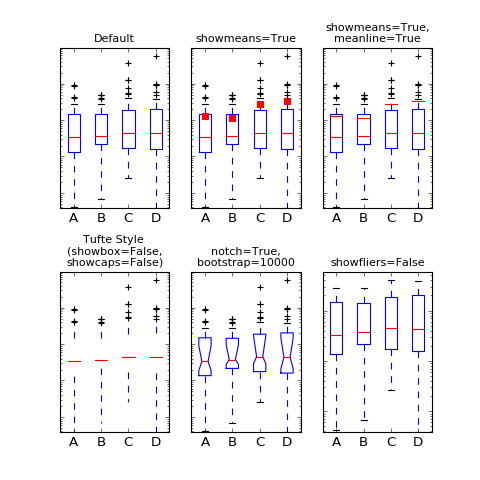
(png)
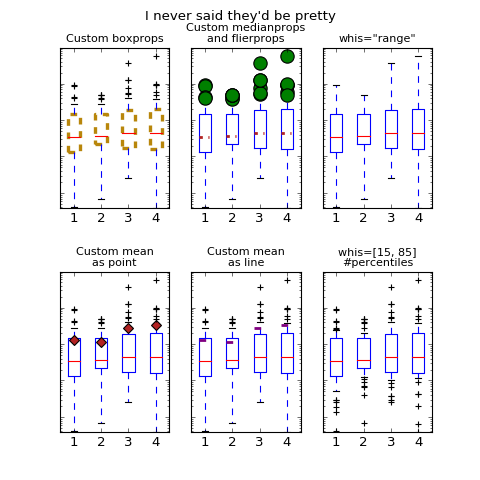
broken_barh(xranges, yrange, **kwargs)¶Plot horizontal bars.
Call signature:
broken_barh(self, xranges, yrange, **kwargs)
A collection of horizontal bars spanning yrange with a sequence of xranges.
Required arguments:
Argument Description xranges sequence of (xmin, xwidth) yrange sequence of (ymin, ywidth)
kwargs are
matplotlib.collections.BrokenBarHCollection
properties:
Property Description agg_filterunknown alphafloat or None animated[True | False] antialiasedor antialiasedsBoolean or sequence of booleans arrayunknown axesan Axesinstancebottom_marginunknown clima length 2 sequence of floats clip_boxa matplotlib.transforms.Bboxinstanceclip_on[True | False] clip_path[ ( Path,Transform) |Patch| None ]cmapa colormap or registered colormap name colormatplotlib color arg or sequence of rgba tuples containsa callable function edgecoloror edgecolorsmatplotlib color spec or sequence of specs facecoloror facecolorsmatplotlib color spec or sequence of specs figurea matplotlib.figure.Figureinstancegidan id string hatch[ ‘/’ | ‘\’ | ‘|’ | ‘-‘ | ‘+’ | ‘x’ | ‘o’ | ‘O’ | ‘.’ | ‘*’ ] labelstring or anything printable with ‘%s’ conversion. left_marginunknown linestyleor dashes or linestyles[‘solid’ | ‘dashed’, ‘dashdot’, ‘dotted’ | (offset, on-off-dash-seq) | '-'|'--'|'-.'|':'|'None'|' '|'']linewidthor linewidths or lwfloat or sequence of floats marginsunknown normunknown offset_positionunknown offsetsfloat or sequence of floats path_effectsunknown picker[None|float|boolean|callable] pickradiusunknown rasterized[True | False | None] right_marginunknown sketch_paramsunknown snapunknown top_marginunknown transformTransforminstanceurla url string urlsunknown visible[True | False] zorderany number
these can either be a single argument, i.e.,:
facecolors = 'black'
or a sequence of arguments for the various bars, i.e.,:
facecolors = ('black', 'red', 'green')
Example:
(Source code, png)
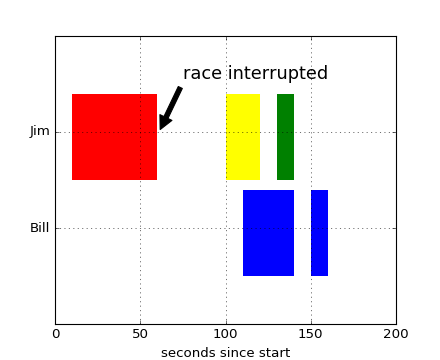
Notes
In addition to the above described arguments, this function can take a data keyword argument. If such a data argument is given, the following arguments are replaced by data[<arg>]:
bxp(bxpstats, positions=None, widths=None, vert=True, patch_artist=False, shownotches=False, showmeans=False, showcaps=True, showbox=True, showfliers=True, boxprops=None, whiskerprops=None, flierprops=None, medianprops=None, capprops=None, meanprops=None, meanline=False, manage_xticks=True)¶Drawing function for box and whisker plots.
Call signature:
bxp(self, bxpstats, positions=None, widths=None, vert=True,
patch_artist=False, shownotches=False, showmeans=False,
showcaps=True, showbox=True, showfliers=True,
boxprops=None, whiskerprops=None, flierprops=None,
medianprops=None, capprops=None, meanprops=None,
meanline=False, manage_xticks=True):
Make a box and whisker plot for each column of x or each vector in sequence x. The box extends from the lower to upper quartile values of the data, with a line at the median. The whiskers extend from the box to show the range of the data. Flier points are those past the end of the whiskers.
| Parameters: | bxpstats : list of dicts
positions : array-like, default = [1, 2, ..., n]
widths : array-like, default = 0.5
vert : bool, default = False
patch_artist : bool, default = False shownotches : bool, default = False
showmeans : bool, default = False
showcaps : bool, default = True
showbox : bool, default = True
showfliers : bool, default = True
boxprops : dict or None (default)
whiskerprops : dict or None (default)
capprops : dict or None (default)
flierprops : dict or None (default)
medianprops : dict or None (default)
meanprops : dict or None (default)
meanline : bool, default = False
manage_xticks : bool, default = True
|
|---|---|
| Returns: | result : dict
|
Examples
(Source code, png)
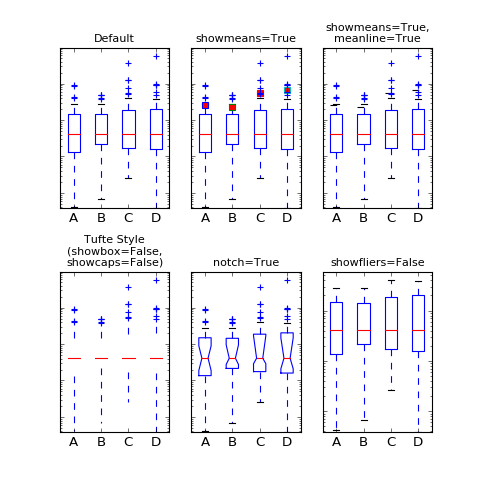
(png)
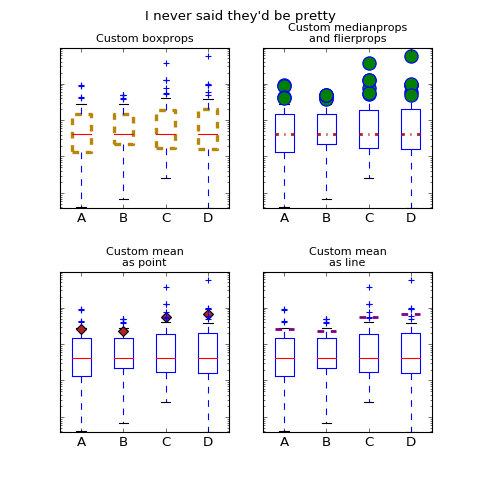
can_pan()¶Return True if this axes supports any pan/zoom button functionality.
can_zoom()¶Return True if this axes supports the zoom box button functionality.
cla()¶Clear the current axes.
clabel(CS, *args, **kwargs)¶Label a contour plot.
Call signature:
clabel(cs, **kwargs)
Adds labels to line contours in cs, where cs is a
ContourSet object returned by
contour.
clabel(cs, v, **kwargs)
only labels contours listed in v.
Optional keyword arguments:
- fontsize:
- size in points or relative size e.g., ‘smaller’, ‘x-large’
- colors:
- if None, the color of each label matches the color of the corresponding contour
- if one string color, e.g., colors = ‘r’ or colors = ‘red’, all labels will be plotted in this color
- if a tuple of matplotlib color args (string, float, rgb, etc), different labels will be plotted in different colors in the order specified
- inline:
- controls whether the underlying contour is removed or not. Default is True.
- inline_spacing:
- space in pixels to leave on each side of label when placing inline. Defaults to 5. This spacing will be exact for labels at locations where the contour is straight, less so for labels on curved contours.
- fmt:
- a format string for the label. Default is ‘%1.3f’ Alternatively, this can be a dictionary matching contour levels with arbitrary strings to use for each contour level (i.e., fmt[level]=string), or it can be any callable, such as a
Formatterinstance, that returns a string when called with a numeric contour level.- manual:
if True, contour labels will be placed manually using mouse clicks. Click the first button near a contour to add a label, click the second button (or potentially both mouse buttons at once) to finish adding labels. The third button can be used to remove the last label added, but only if labels are not inline. Alternatively, the keyboard can be used to select label locations (enter to end label placement, delete or backspace act like the third mouse button, and any other key will select a label location).
manual can be an iterable object of x,y tuples. Contour labels will be created as if mouse is clicked at each x,y positions.
- rightside_up:
- if True (default), label rotations will always be plus or minus 90 degrees from level.
- use_clabeltext:
- if True (default is False), ClabelText class (instead of matplotlib.Text) is used to create labels. ClabelText recalculates rotation angles of texts during the drawing time, therefore this can be used if aspect of the axes changes.
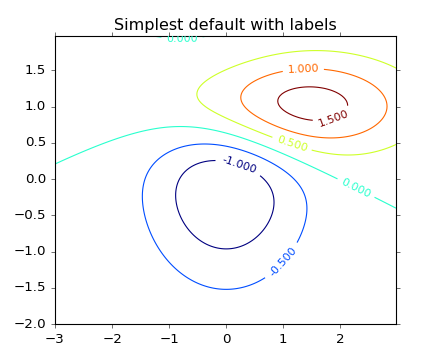
(png)
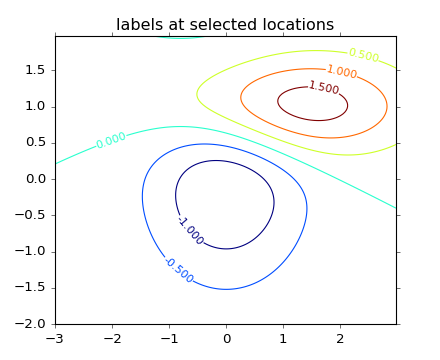
(png)
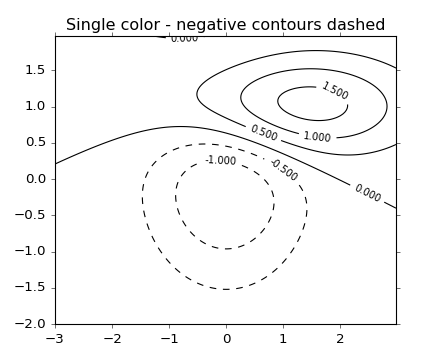
(png)
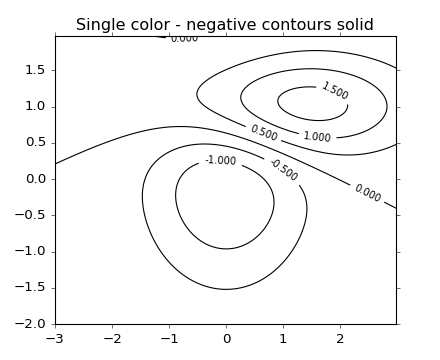
(png)
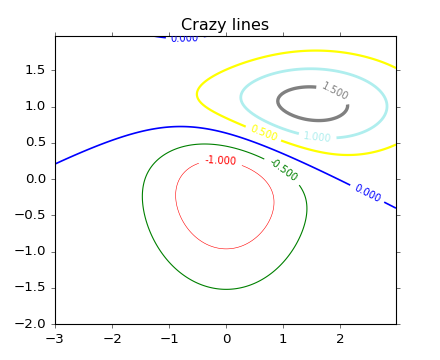
(png)
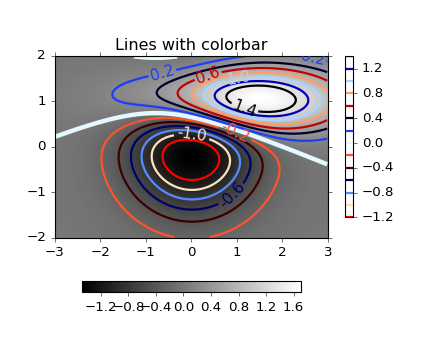
(png)
clear()¶clear the axes
cohere(x, y, NFFT=256, Fs=2, Fc=0, detrend=<function detrend_none>, window=<function window_hanning>, noverlap=0, pad_to=None, sides='default', scale_by_freq=None, **kwargs)¶Plot the coherence between x and y.
Call signature:
cohere(x, y, NFFT=256, Fs=2, Fc=0, detrend = mlab.detrend_none,
window = mlab.window_hanning, noverlap=0, pad_to=None,
sides='default', scale_by_freq=None, **kwargs)
Plot the coherence between x and y. Coherence is the normalized cross spectral density:

Keyword arguments:
- Fs: scalar
- The sampling frequency (samples per time unit). It is used to calculate the Fourier frequencies, freqs, in cycles per time unit. The default value is 2.
- window: callable or ndarray
- A function or a vector of length NFFT. To create window vectors see
window_hanning(),window_none(),numpy.blackman(),numpy.hamming(),numpy.bartlett(),scipy.signal(),scipy.signal.get_window(), etc. The default iswindow_hanning(). If a function is passed as the argument, it must take a data segment as an argument and return the windowed version of the segment.- sides: [ ‘default’ | ‘onesided’ | ‘twosided’ ]
- Specifies which sides of the spectrum to return. Default gives the default behavior, which returns one-sided for real data and both for complex data. ‘onesided’ forces the return of a one-sided spectrum, while ‘twosided’ forces two-sided.
callable
The function applied to each segment before fft-ing,
designed to remove the mean or linear trend. Unlike in
MATLAB, where the detrend parameter is a vector, in
matplotlib is it a function. The pylab
module defines detrend_none(),
detrend_mean(), and
detrend_linear(), but you can use
a custom function as well. You can also use a string to choose
one of the functions. ‘default’, ‘constant’, and ‘mean’ call
detrend_mean(). ‘linear’ calls
detrend_linear(). ‘none’ calls
detrend_none().
Specifies whether the resulting density values should be scaled by the scaling frequency, which gives density in units of Hz^-1. This allows for integration over the returned frequency values. The default is True for MATLAB compatibility.
The return value is a tuple (Cxy, f), where f are the frequencies of the coherence vector.
kwargs are applied to the lines.
References:
- Bendat & Piersol – Random Data: Analysis and Measurement Procedures, John Wiley & Sons (1986)
kwargs control the Line2D
properties of the coherence plot:
Property Description agg_filterunknown alphafloat (0.0 transparent through 1.0 opaque) animated[True | False] antialiasedor aa[True | False] axesan Axesinstancebottom_marginunknown clip_boxa matplotlib.transforms.Bboxinstanceclip_on[True | False] clip_path[ ( Path,Transform) |Patch| None ]coloror cany matplotlib color containsa callable function dash_capstyle[‘butt’ | ‘round’ | ‘projecting’] dash_joinstyle[‘miter’ | ‘round’ | ‘bevel’] dashessequence of on/off ink in points drawstyle[‘default’ | ‘steps’ | ‘steps-pre’ | ‘steps-mid’ | ‘steps-post’] figurea matplotlib.figure.Figureinstancefillstyle[‘full’ | ‘left’ | ‘right’ | ‘bottom’ | ‘top’ | ‘none’] gidan id string labelstring or anything printable with ‘%s’ conversion. left_marginunknown linestyleor ls[‘solid’ | ‘dashed’, ‘dashdot’, ‘dotted’ | (offset, on-off-dash-seq) | '-'|'--'|'-.'|':'|'None'|' '|'']linewidthor lwfloat value in points marginsunknown markerA valid marker stylemarkeredgecoloror mecany matplotlib color markeredgewidthor mewfloat value in points markerfacecoloror mfcany matplotlib color markerfacecoloraltor mfcaltany matplotlib color markersizeor msfloat markevery[None | int | length-2 tuple of int | slice | list/array of int | float | length-2 tuple of float] path_effectsunknown pickerfloat distance in points or callable pick function fn(artist, event)pickradiusfloat distance in points rasterized[True | False | None] right_marginunknown sketch_paramsunknown snapunknown solid_capstyle[‘butt’ | ‘round’ | ‘projecting’] solid_joinstyle[‘miter’ | ‘round’ | ‘bevel’] top_marginunknown transforma matplotlib.transforms.Transforminstanceurla url string visible[True | False] xdata1D array ydata1D array zorderany number
Example:
(Source code, png)
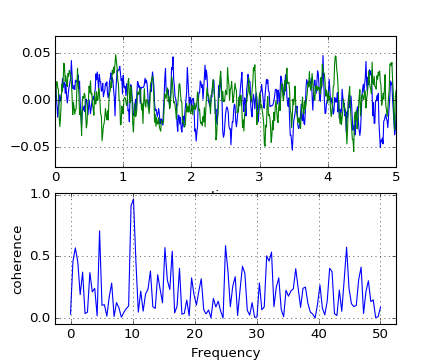
Notes
In addition to the above described arguments, this function can take a data keyword argument. If such a data argument is given, the following arguments are replaced by data[<arg>]:
contains(mouseevent)¶Test whether the mouse event occured in the axes.
Returns True / False, {}
contains_point(point)¶Returns True if the point (tuple of x,y) is inside the axes (the area defined by the its patch). A pixel coordinate is required.
contour(*args, **kwargs)¶Plot contours.
contour() and
contourf() draw contour lines and
filled contours, respectively. Except as noted, function
signatures and return values are the same for both versions.
contourf() differs from the MATLAB
version in that it does not draw the polygon edges.
To draw edges, add line contours with
calls to contour().
Call signatures:
contour(Z)
make a contour plot of an array Z. The level values are chosen automatically.
contour(X,Y,Z)
X, Y specify the (x, y) coordinates of the surface
contour(Z,N)
contour(X,Y,Z,N)
contour up to N automatically-chosen levels.
contour(Z,V)
contour(X,Y,Z,V)
draw contour lines at the values specified in sequence V, which must be in increasing order.
contourf(..., V)
fill the len(V)-1 regions between the values in V,
which must be in increasing order.
contour(Z, **kwargs)
Use keyword args to control colors, linewidth, origin, cmap ... see below for more details.
X and Y must both be 2-D with the same shape as Z, or they
must both be 1-D such that len(X) is the number of columns in
Z and len(Y) is the number of rows in Z.
C = contour(...) returns a
QuadContourSet object.
Optional keyword arguments:
- corner_mask: [ True | False | ‘legacy’ ]
Enable/disable corner masking, which only has an effect if Z is a masked array. If False, any quad touching a masked point is masked out. If True, only the triangular corners of quads nearest those points are always masked out, other triangular corners comprising three unmasked points are contoured as usual. If ‘legacy’, the old contouring algorithm is used, which is equivalent to False and is deprecated, only remaining whilst the new algorithm is tested fully.
If not specified, the default is taken from rcParams[‘contour.corner_mask’], which is True unless it has been modified.
- colors: [ None | string | (mpl_colors) ]
If None, the colormap specified by cmap will be used.
If a string, like ‘r’ or ‘red’, all levels will be plotted in this color.
If a tuple of matplotlib color args (string, float, rgb, etc), different levels will be plotted in different colors in the order specified.
- alpha: float
- The alpha blending value
- cmap: [ None | Colormap ]
- A cm
Colormapinstance or None. If cmap is None and colors is None, a default Colormap is used.- norm: [ None | Normalize ]
- A
matplotlib.colors.Normalizeinstance for scaling data values to colors. If norm is None and colors is None, the default linear scaling is used.- vmin, vmax: [ None | scalar ]
- If not None, either or both of these values will be supplied to the
matplotlib.colors.Normalizeinstance, overriding the default color scaling based on levels.- levels: [level0, level1, ..., leveln]
- A list of floating point numbers indicating the level curves to draw, in increasing order; e.g., to draw just the zero contour pass
levels=[0]- origin: [ None | ‘upper’ | ‘lower’ | ‘image’ ]
If None, the first value of Z will correspond to the lower left corner, location (0,0). If ‘image’, the rc value for
image.originwill be used.This keyword is not active if X and Y are specified in the call to contour.
extent: [ None | (x0,x1,y0,y1) ]
If origin is not None, then extent is interpreted as in
matplotlib.pyplot.imshow(): it gives the outer pixel boundaries. In this case, the position of Z[0,0] is the center of the pixel, not a corner. If origin is None, then (x0, y0) is the position of Z[0,0], and (x1, y1) is the position of Z[-1,-1].This keyword is not active if X and Y are specified in the call to contour.
- locator: [ None | ticker.Locator subclass ]
- If locator is None, the default
MaxNLocatoris used. The locator is used to determine the contour levels if they are not given explicitly via the V argument.- extend: [ ‘neither’ | ‘both’ | ‘min’ | ‘max’ ]
- Unless this is ‘neither’, contour levels are automatically added to one or both ends of the range so that all data are included. These added ranges are then mapped to the special colormap values which default to the ends of the colormap range, but can be set via
matplotlib.colors.Colormap.set_under()andmatplotlib.colors.Colormap.set_over()methods.- xunits, yunits: [ None | registered units ]
- Override axis units by specifying an instance of a
matplotlib.units.ConversionInterface.- antialiased: [ True | False ]
- enable antialiasing, overriding the defaults. For filled contours, the default is True. For line contours, it is taken from rcParams[‘lines.antialiased’].
- nchunk: [ 0 | integer ]
- If 0, no subdivision of the domain. Specify a positive integer to divide the domain into subdomains of nchunk by nchunk quads. Chunking reduces the maximum length of polygons generated by the contouring algorithm which reduces the rendering workload passed on to the backend and also requires slightly less RAM. It can however introduce rendering artifacts at chunk boundaries depending on the backend, the antialiased flag and value of alpha.
contour-only keyword arguments:
- linewidths: [ None | number | tuple of numbers ]
If linewidths is None, the default width in
lines.linewidthinmatplotlibrcis used.If a number, all levels will be plotted with this linewidth.
If a tuple, different levels will be plotted with different linewidths in the order specified.
- linestyles: [ None | ‘solid’ | ‘dashed’ | ‘dashdot’ | ‘dotted’ ]
If linestyles is None, the default is ‘solid’ unless the lines are monochrome. In that case, negative contours will take their linestyle from the
matplotlibrccontour.negative_linestylesetting.linestyles can also be an iterable of the above strings specifying a set of linestyles to be used. If this iterable is shorter than the number of contour levels it will be repeated as necessary.
contourf-only keyword arguments:
- hatches:
- A list of cross hatch patterns to use on the filled areas. If None, no hatching will be added to the contour. Hatching is supported in the PostScript, PDF, SVG and Agg backends only.
Note: contourf fills intervals that are closed at the top; that is, for boundaries z1 and z2, the filled region is:
z1 < z <= z2
There is one exception: if the lowest boundary coincides with the minimum value of the z array, then that minimum value will be included in the lowest interval.
Examples:

(png)

(png)

(png)

(png)

(png)

(png)
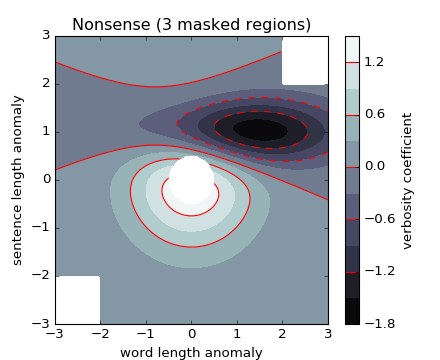
(png)
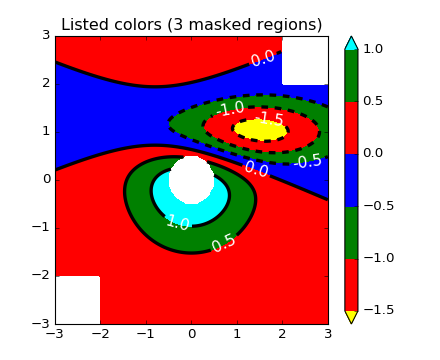
(png)
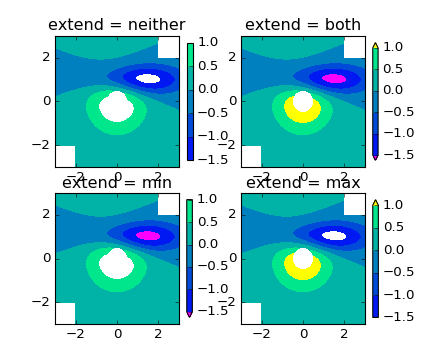
(png)
(Source code, png)
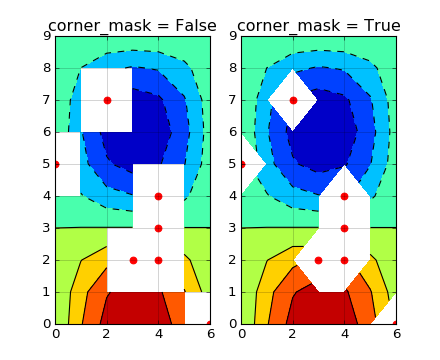
contourf(*args, **kwargs)¶Plot contours.
contour() and
contourf() draw contour lines and
filled contours, respectively. Except as noted, function
signatures and return values are the same for both versions.
contourf() differs from the MATLAB
version in that it does not draw the polygon edges.
To draw edges, add line contours with
calls to contour().
Call signatures:
contour(Z)
make a contour plot of an array Z. The level values are chosen automatically.
contour(X,Y,Z)
X, Y specify the (x, y) coordinates of the surface
contour(Z,N)
contour(X,Y,Z,N)
contour up to N automatically-chosen levels.
contour(Z,V)
contour(X,Y,Z,V)
draw contour lines at the values specified in sequence V, which must be in increasing order.
contourf(..., V)
fill the len(V)-1 regions between the values in V,
which must be in increasing order.
contour(Z, **kwargs)
Use keyword args to control colors, linewidth, origin, cmap ... see below for more details.
X and Y must both be 2-D with the same shape as Z, or they
must both be 1-D such that len(X) is the number of columns in
Z and len(Y) is the number of rows in Z.
C = contour(...) returns a
QuadContourSet object.
Optional keyword arguments:
- corner_mask: [ True | False | ‘legacy’ ]
Enable/disable corner masking, which only has an effect if Z is a masked array. If False, any quad touching a masked point is masked out. If True, only the triangular corners of quads nearest those points are always masked out, other triangular corners comprising three unmasked points are contoured as usual. If ‘legacy’, the old contouring algorithm is used, which is equivalent to False and is deprecated, only remaining whilst the new algorithm is tested fully.
If not specified, the default is taken from rcParams[‘contour.corner_mask’], which is True unless it has been modified.
- colors: [ None | string | (mpl_colors) ]
If None, the colormap specified by cmap will be used.
If a string, like ‘r’ or ‘red’, all levels will be plotted in this color.
If a tuple of matplotlib color args (string, float, rgb, etc), different levels will be plotted in different colors in the order specified.
- alpha: float
- The alpha blending value
- cmap: [ None | Colormap ]
- A cm
Colormapinstance or None. If cmap is None and colors is None, a default Colormap is used.- norm: [ None | Normalize ]
- A
matplotlib.colors.Normalizeinstance for scaling data values to colors. If norm is None and colors is None, the default linear scaling is used.- vmin, vmax: [ None | scalar ]
- If not None, either or both of these values will be supplied to the
matplotlib.colors.Normalizeinstance, overriding the default color scaling based on levels.- levels: [level0, level1, ..., leveln]
- A list of floating point numbers indicating the level curves to draw, in increasing order; e.g., to draw just the zero contour pass
levels=[0]- origin: [ None | ‘upper’ | ‘lower’ | ‘image’ ]
If None, the first value of Z will correspond to the lower left corner, location (0,0). If ‘image’, the rc value for
image.originwill be used.This keyword is not active if X and Y are specified in the call to contour.
extent: [ None | (x0,x1,y0,y1) ]
If origin is not None, then extent is interpreted as in
matplotlib.pyplot.imshow(): it gives the outer pixel boundaries. In this case, the position of Z[0,0] is the center of the pixel, not a corner. If origin is None, then (x0, y0) is the position of Z[0,0], and (x1, y1) is the position of Z[-1,-1].This keyword is not active if X and Y are specified in the call to contour.
- locator: [ None | ticker.Locator subclass ]
- If locator is None, the default
MaxNLocatoris used. The locator is used to determine the contour levels if they are not given explicitly via the V argument.- extend: [ ‘neither’ | ‘both’ | ‘min’ | ‘max’ ]
- Unless this is ‘neither’, contour levels are automatically added to one or both ends of the range so that all data are included. These added ranges are then mapped to the special colormap values which default to the ends of the colormap range, but can be set via
matplotlib.colors.Colormap.set_under()andmatplotlib.colors.Colormap.set_over()methods.- xunits, yunits: [ None | registered units ]
- Override axis units by specifying an instance of a
matplotlib.units.ConversionInterface.- antialiased: [ True | False ]
- enable antialiasing, overriding the defaults. For filled contours, the default is True. For line contours, it is taken from rcParams[‘lines.antialiased’].
- nchunk: [ 0 | integer ]
- If 0, no subdivision of the domain. Specify a positive integer to divide the domain into subdomains of nchunk by nchunk quads. Chunking reduces the maximum length of polygons generated by the contouring algorithm which reduces the rendering workload passed on to the backend and also requires slightly less RAM. It can however introduce rendering artifacts at chunk boundaries depending on the backend, the antialiased flag and value of alpha.
contour-only keyword arguments:
- linewidths: [ None | number | tuple of numbers ]
If linewidths is None, the default width in
lines.linewidthinmatplotlibrcis used.If a number, all levels will be plotted with this linewidth.
If a tuple, different levels will be plotted with different linewidths in the order specified.
- linestyles: [ None | ‘solid’ | ‘dashed’ | ‘dashdot’ | ‘dotted’ ]
If linestyles is None, the default is ‘solid’ unless the lines are monochrome. In that case, negative contours will take their linestyle from the
matplotlibrccontour.negative_linestylesetting.linestyles can also be an iterable of the above strings specifying a set of linestyles to be used. If this iterable is shorter than the number of contour levels it will be repeated as necessary.
contourf-only keyword arguments:
- hatches:
- A list of cross hatch patterns to use on the filled areas. If None, no hatching will be added to the contour. Hatching is supported in the PostScript, PDF, SVG and Agg backends only.
Note: contourf fills intervals that are closed at the top; that is, for boundaries z1 and z2, the filled region is:
z1 < z <= z2
There is one exception: if the lowest boundary coincides with the minimum value of the z array, then that minimum value will be included in the lowest interval.
Examples:

(png)

(png)

(png)

(png)

(png)

(png)

(png)

(png)

(png)
(Source code, png)

convert_xunits(x)¶For artists in an axes, if the xaxis has units support, convert x using xaxis unit type
convert_yunits(y)¶For artists in an axes, if the yaxis has units support, convert y using yaxis unit type
csd(x, y, NFFT=None, Fs=None, Fc=None, detrend=None, window=None, noverlap=None, pad_to=None, sides=None, scale_by_freq=None, return_line=None, **kwargs)¶Plot the cross-spectral density.
Call signature:
csd(x, y, NFFT=256, Fs=2, Fc=0, detrend=mlab.detrend_none,
window=mlab.window_hanning, noverlap=0, pad_to=None,
sides='default', scale_by_freq=None, return_line=None, **kwargs)
The cross spectral density  by Welch’s average
periodogram method. The vectors x and y are divided into
NFFT length segments. Each segment is detrended by function
detrend and windowed by function window. noverlap gives
the length of the overlap between segments. The product of
the direct FFTs of x and y are averaged over each segment
to compute
by Welch’s average
periodogram method. The vectors x and y are divided into
NFFT length segments. Each segment is detrended by function
detrend and windowed by function window. noverlap gives
the length of the overlap between segments. The product of
the direct FFTs of x and y are averaged over each segment
to compute  , with a scaling to correct for power
loss due to windowing.
, with a scaling to correct for power
loss due to windowing.
If len(x) < NFFT or len(y) < NFFT, they will be zero padded to NFFT.
- x, y: 1-D arrays or sequences
- Arrays or sequences containing the data
Keyword arguments:
- Fs: scalar
- The sampling frequency (samples per time unit). It is used to calculate the Fourier frequencies, freqs, in cycles per time unit. The default value is 2.
- window: callable or ndarray
- A function or a vector of length NFFT. To create window vectors see
window_hanning(),window_none(),numpy.blackman(),numpy.hamming(),numpy.bartlett(),scipy.signal(),scipy.signal.get_window(), etc. The default iswindow_hanning(). If a function is passed as the argument, it must take a data segment as an argument and return the windowed version of the segment.- sides: [ ‘default’ | ‘onesided’ | ‘twosided’ ]
- Specifies which sides of the spectrum to return. Default gives the default behavior, which returns one-sided for real data and both for complex data. ‘onesided’ forces the return of a one-sided spectrum, while ‘twosided’ forces two-sided.
callable
The function applied to each segment before fft-ing,
designed to remove the mean or linear trend. Unlike in
MATLAB, where the detrend parameter is a vector, in
matplotlib is it a function. The pylab
module defines detrend_none(),
detrend_mean(), and
detrend_linear(), but you can use
a custom function as well. You can also use a string to choose
one of the functions. ‘default’, ‘constant’, and ‘mean’ call
detrend_mean(). ‘linear’ calls
detrend_linear(). ‘none’ calls
detrend_none().
Specifies whether the resulting density values should be scaled by the scaling frequency, which gives density in units of Hz^-1. This allows for integration over the returned frequency values. The default is True for MATLAB compatibility.
If return_line is False, returns the tuple (Pxy, freqs). If return_line is True, returns the tuple (Pxy, freqs. line):
- Pxy: 1-D array
- The values for the cross spectrum
P_{xy}before scaling (complex valued)- freqs: 1-D array
- The frequencies corresponding to the elements in Pxy
- line: a
Line2Dinstance- The line created by this function. Only returend if return_line is True.
For plotting, the power is plotted as
 for decibels, though
for decibels, though P_{xy} itself
is returned.
kwargs control the Line2D properties:
Property Description agg_filterunknown alphafloat (0.0 transparent through 1.0 opaque) animated[True | False] antialiasedor aa[True | False] axesan Axesinstancebottom_marginunknown clip_boxa matplotlib.transforms.Bboxinstanceclip_on[True | False] clip_path[ ( Path,Transform) |Patch| None ]coloror cany matplotlib color containsa callable function dash_capstyle[‘butt’ | ‘round’ | ‘projecting’] dash_joinstyle[‘miter’ | ‘round’ | ‘bevel’] dashessequence of on/off ink in points drawstyle[‘default’ | ‘steps’ | ‘steps-pre’ | ‘steps-mid’ | ‘steps-post’] figurea matplotlib.figure.Figureinstancefillstyle[‘full’ | ‘left’ | ‘right’ | ‘bottom’ | ‘top’ | ‘none’] gidan id string labelstring or anything printable with ‘%s’ conversion. left_marginunknown linestyleor ls[‘solid’ | ‘dashed’, ‘dashdot’, ‘dotted’ | (offset, on-off-dash-seq) | '-'|'--'|'-.'|':'|'None'|' '|'']linewidthor lwfloat value in points marginsunknown markerA valid marker stylemarkeredgecoloror mecany matplotlib color markeredgewidthor mewfloat value in points markerfacecoloror mfcany matplotlib color markerfacecoloraltor mfcaltany matplotlib color markersizeor msfloat markevery[None | int | length-2 tuple of int | slice | list/array of int | float | length-2 tuple of float] path_effectsunknown pickerfloat distance in points or callable pick function fn(artist, event)pickradiusfloat distance in points rasterized[True | False | None] right_marginunknown sketch_paramsunknown snapunknown solid_capstyle[‘butt’ | ‘round’ | ‘projecting’] solid_joinstyle[‘miter’ | ‘round’ | ‘bevel’] top_marginunknown transforma matplotlib.transforms.Transforminstanceurla url string visible[True | False] xdata1D array ydata1D array zorderany number
Example:
(Source code, png)
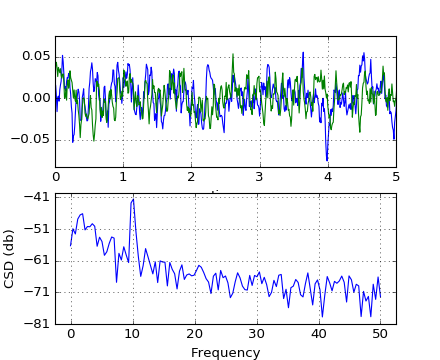
See also
psd()psd() is the equivalent to setting y=x.Notes
In addition to the above described arguments, this function can take a data keyword argument. If such a data argument is given, the following arguments are replaced by data[<arg>]:
drag_pan(button, key, x, y)¶Called when the mouse moves during a pan operation.
button is the mouse button number:
key is a “shift” key
x, y are the mouse coordinates in display coords.
Note
Intended to be overridden by new projection types.
draw(artist, renderer, *args, **kwargs)¶Draw everything (plot lines, axes, labels)
draw_artist(a)¶This method can only be used after an initial draw which caches the renderer. It is used to efficiently update Axes data (axis ticks, labels, etc are not updated)
end_pan()¶Called when a pan operation completes (when the mouse button is up.)
Note
Intended to be overridden by new projection types.
errorbar(x, y, yerr=None, xerr=None, fmt='', ecolor=None, elinewidth=None, capsize=None, barsabove=False, lolims=False, uplims=False, xlolims=False, xuplims=False, errorevery=1, capthick=None, **kwargs)¶Plot an errorbar graph.
Call signature:
errorbar(x, y, yerr=None, xerr=None,
fmt='', ecolor=None, elinewidth=None, capsize=None,
barsabove=False, lolims=False, uplims=False,
xlolims=False, xuplims=False, errorevery=1,
capthick=None)
Plot x versus y with error deltas in yerr and xerr. Vertical errorbars are plotted if yerr is not None. Horizontal errorbars are plotted if xerr is not None.
x, y, xerr, and yerr can all be scalars, which plots a single error bar at x, y.
Optional keyword arguments:
- xerr/yerr: [ scalar | N, Nx1, or 2xN array-like ]
If a scalar number, len(N) array-like object, or an Nx1 array-like object, errorbars are drawn at +/-value relative to the data.
If a sequence of shape 2xN, errorbars are drawn at -row1 and +row2 relative to the data.
- fmt: [ ‘’ | ‘none’ | plot format string ]
- The plot format symbol. If fmt is ‘none’ (case-insensitive), only the errorbars are plotted. This is used for adding errorbars to a bar plot, for example. Default is ‘’, an empty plot format string; properties are then identical to the defaults for
plot().- ecolor: [ None | mpl color ]
- A matplotlib color arg which gives the color the errorbar lines; if None, use the color of the line connecting the markers.
- elinewidth: scalar
- The linewidth of the errorbar lines. If None, use the linewidth.
- capsize: scalar
- The length of the error bar caps in points; if None, it will take the value from
errorbar.capsizercParam.- capthick: scalar
- An alias kwarg to markeredgewidth (a.k.a. - mew). This setting is a more sensible name for the property that controls the thickness of the error bar cap in points. For backwards compatibility, if mew or markeredgewidth are given, then they will over-ride capthick. This may change in future releases.
- barsabove: [ True | False ]
- if True, will plot the errorbars above the plot symbols. Default is below.
- lolims / uplims / xlolims / xuplims: [ False | True ]
- These arguments can be used to indicate that a value gives only upper/lower limits. In that case a caret symbol is used to indicate this. lims-arguments may be of the same type as xerr and yerr. To use limits with inverted axes,
set_xlim()orset_ylim()must be called beforeerrorbar().- errorevery: positive integer
- subsamples the errorbars. e.g., if errorevery=5, errorbars for every 5-th datapoint will be plotted. The data plot itself still shows all data points.
All other keyword arguments are passed on to the plot command for the markers. For example, this code makes big red squares with thick green edges:
x,y,yerr = rand(3,10)
errorbar(x, y, yerr, marker='s',
mfc='red', mec='green', ms=20, mew=4)
where mfc, mec, ms and mew are aliases for the longer property names, markerfacecolor, markeredgecolor, markersize and markeredgewith.
valid kwargs for the marker properties are
Property Description agg_filterunknown alphafloat (0.0 transparent through 1.0 opaque) animated[True | False] antialiasedor aa[True | False] axesan Axesinstancebottom_marginunknown clip_boxa matplotlib.transforms.Bboxinstanceclip_on[True | False] clip_path[ ( Path,Transform) |Patch| None ]coloror cany matplotlib color containsa callable function dash_capstyle[‘butt’ | ‘round’ | ‘projecting’] dash_joinstyle[‘miter’ | ‘round’ | ‘bevel’] dashessequence of on/off ink in points drawstyle[‘default’ | ‘steps’ | ‘steps-pre’ | ‘steps-mid’ | ‘steps-post’] figurea matplotlib.figure.Figureinstancefillstyle[‘full’ | ‘left’ | ‘right’ | ‘bottom’ | ‘top’ | ‘none’] gidan id string labelstring or anything printable with ‘%s’ conversion. left_marginunknown linestyleor ls[‘solid’ | ‘dashed’, ‘dashdot’, ‘dotted’ | (offset, on-off-dash-seq) | '-'|'--'|'-.'|':'|'None'|' '|'']linewidthor lwfloat value in points marginsunknown markerA valid marker stylemarkeredgecoloror mecany matplotlib color markeredgewidthor mewfloat value in points markerfacecoloror mfcany matplotlib color markerfacecoloraltor mfcaltany matplotlib color markersizeor msfloat markevery[None | int | length-2 tuple of int | slice | list/array of int | float | length-2 tuple of float] path_effectsunknown pickerfloat distance in points or callable pick function fn(artist, event)pickradiusfloat distance in points rasterized[True | False | None] right_marginunknown sketch_paramsunknown snapunknown solid_capstyle[‘butt’ | ‘round’ | ‘projecting’] solid_joinstyle[‘miter’ | ‘round’ | ‘bevel’] top_marginunknown transforma matplotlib.transforms.Transforminstanceurla url string visible[True | False] xdata1D array ydata1D array zorderany number
Returns (plotline, caplines, barlinecols):
- plotline:
Line2Dinstance- x, y plot markers and/or line
- caplines: list of error bar cap
Line2Dinstances- barlinecols: list of
LineCollectioninstances for the horizontal and vertical error ranges.
Example:
(Source code, png)
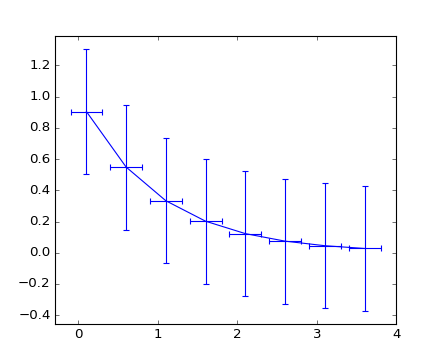
Notes
In addition to the above described arguments, this function can take a data keyword argument. If such a data argument is given, the following arguments are replaced by data[<arg>]:
eventplot(positions, orientation='horizontal', lineoffsets=1, linelengths=1, linewidths=None, colors=None, linestyles='solid', **kwargs)¶Plot identical parallel lines at specific positions.
Call signature:
eventplot(positions, orientation='horizontal', lineoffsets=0,
linelengths=1, linewidths=None, color =None,
linestyles='solid'
Plot parallel lines at the given positions. positions should be a 1D or 2D array-like object, with each row corresponding to a row or column of lines.
This type of plot is commonly used in neuroscience for representing neural events, where it is commonly called a spike raster, dot raster, or raster plot.
However, it is useful in any situation where you wish to show the timing or position of multiple sets of discrete events, such as the arrival times of people to a business on each day of the month or the date of hurricanes each year of the last century.
For linelengths, linewidths, colors, and linestyles, if only a single value is given, that value is applied to all lines. If an array-like is given, it must have the same length as positions, and each value will be applied to the corresponding row or column in positions.
Returns a list of matplotlib.collections.EventCollection
objects that were added.
kwargs are LineCollection properties:
Property Description agg_filterunknown alphafloat or None animated[True | False] antialiasedor antialiasedsBoolean or sequence of booleans arrayunknown axesan Axesinstancebottom_marginunknown clima length 2 sequence of floats clip_boxa matplotlib.transforms.Bboxinstanceclip_on[True | False] clip_path[ ( Path,Transform) |Patch| None ]cmapa colormap or registered colormap name colormatplotlib color arg or sequence of rgba tuples containsa callable function edgecoloror edgecolorsmatplotlib color spec or sequence of specs facecoloror facecolorsmatplotlib color spec or sequence of specs figurea matplotlib.figure.Figureinstancegidan id string hatch[ ‘/’ | ‘\’ | ‘|’ | ‘-‘ | ‘+’ | ‘x’ | ‘o’ | ‘O’ | ‘.’ | ‘*’ ] labelstring or anything printable with ‘%s’ conversion. left_marginunknown linestyleor dashes or linestyles[‘solid’ | ‘dashed’, ‘dashdot’, ‘dotted’ | (offset, on-off-dash-seq) | '-'|'--'|'-.'|':'|'None'|' '|'']linewidthor linewidths or lwfloat or sequence of floats marginsunknown normunknown offset_positionunknown offsetsfloat or sequence of floats path_effectsunknown pathsunknown picker[None|float|boolean|callable] pickradiusunknown rasterized[True | False | None] right_marginunknown segmentsunknown sketch_paramsunknown snapunknown top_marginunknown transformTransforminstanceurla url string urlsunknown vertsunknown visible[True | False] zorderany number
Example:
(Source code, png)
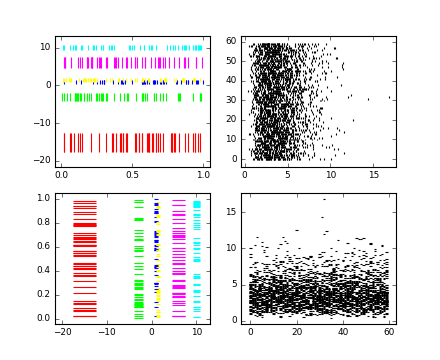
Notes
In addition to the above described arguments, this function can take a data keyword argument. If such a data argument is given, the following arguments are replaced by data[<arg>]:
fill(*args, **kwargs)¶Plot filled polygons.
Call signature:
fill(*args, **kwargs)
args is a variable length argument, allowing for multiple
x, y pairs with an optional color format string; see
plot() for details on the argument
parsing. For example, to plot a polygon with vertices at x,
y in blue.:
ax.fill(x,y, 'b' )
An arbitrary number of x, y, color groups can be specified:
ax.fill(x1, y1, 'g', x2, y2, 'r')
Return value is a list of Patch
instances that were added.
The same color strings that plot()
supports are supported by the fill format string.
If you would like to fill below a curve, e.g., shade a region
between 0 and y along x, use fill_between()
The closed kwarg will close the polygon when True (default).
kwargs control the Polygon properties:
Property Description agg_filterunknown alphafloat or None animated[True | False] antialiasedor aa[True | False] or None for default axesan Axesinstancebottom_marginunknown capstyle[‘butt’ | ‘round’ | ‘projecting’] clip_boxa matplotlib.transforms.Bboxinstanceclip_on[True | False] clip_path[ ( Path,Transform) |Patch| None ]colormatplotlib color spec containsa callable function edgecoloror ecmpl color spec, or None for default, or ‘none’ for no color facecoloror fcmpl color spec, or None for default, or ‘none’ for no color figurea matplotlib.figure.Figureinstancefill[True | False] gidan id string hatch[‘/’ | ‘\’ | ‘|’ | ‘-‘ | ‘+’ | ‘x’ | ‘o’ | ‘O’ | ‘.’ | ‘*’] joinstyle[‘miter’ | ‘round’ | ‘bevel’] labelstring or anything printable with ‘%s’ conversion. left_marginunknown linestyleor ls[‘solid’ | ‘dashed’, ‘dashdot’, ‘dotted’ | (offset, on-off-dash-seq) | '-'|'--'|'-.'|':'|'None'|' '|'']linewidthor lwfloat or None for default marginsunknown path_effectsunknown picker[None|float|boolean|callable] rasterized[True | False | None] right_marginunknown sketch_paramsunknown snapunknown top_marginunknown transformTransforminstanceurla url string visible[True | False] zorderany number
Example:
(Source code, png)
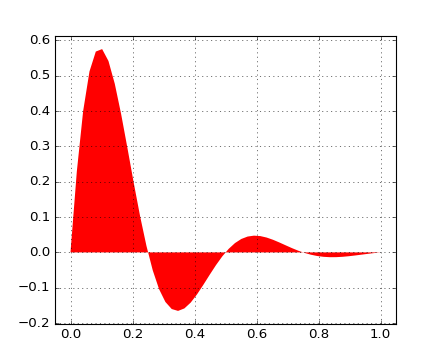
Notes
In addition to the above described arguments, this function can take a data keyword argument. If such a data argument is given, the following arguments are replaced by data[<arg>]:
fill_between(x, y1, y2=0, where=None, interpolate=False, step=None, **kwargs)¶Make filled polygons between two curves.
Create a PolyCollection
filling the regions between y1 and y2 where
where==True
| Parameters: | x : array
y1 : array
y2 : array
where : array, optional
interpolate : bool, optional
step : {‘pre’, ‘post’, ‘mid’}, optional
|
|---|
Notes
In addition to the above described arguments, this function can take a data keyword argument. If such a data argument is given, the following arguments are replaced by data[<arg>]:
Examples
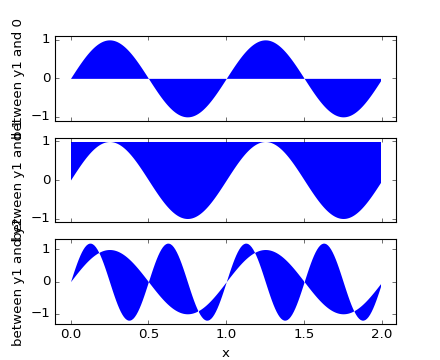
(png)
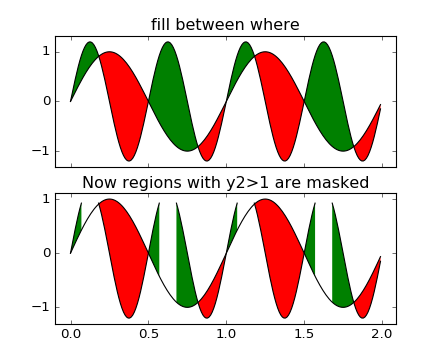
(png)
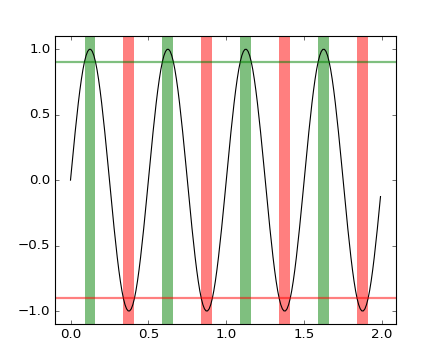
(png)
fill_betweenx(y, x1, x2=0, where=None, step=None, **kwargs)¶Make filled polygons between two horizontal curves.
Call signature:
fill_betweenx(y, x1, x2=0, where=None, **kwargs)
Create a PolyCollection
filling the regions between x1 and x2 where
where==True
| Parameters: | y : array
x1 : array
x2 : array, optional
where : array, optional
step : {‘pre’, ‘post’, ‘mid’}, optional
|
|---|
Notes
In addition to the above described arguments, this function can take a data keyword argument. If such a data argument is given, the following arguments are replaced by data[<arg>]:
Examples
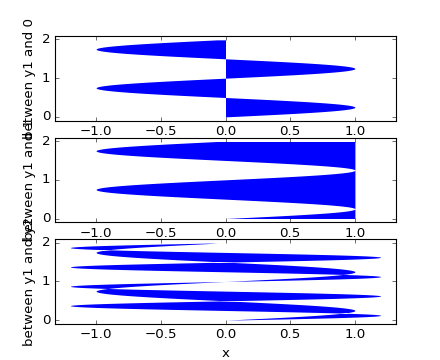
(png)
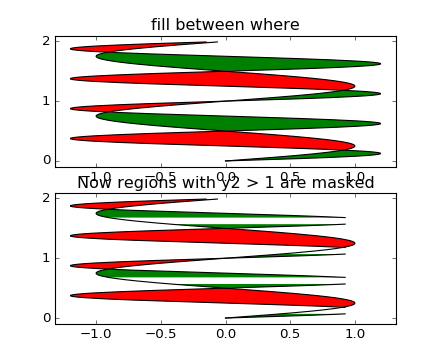
(png)
findobj(match=None, include_self=True)¶Find artist objects.
Recursively find all Artist instances
contained in self.
match can be
- None: return all objects contained in artist.
- function with signature
boolean = match(artist)used to filter matches- class instance: e.g., Line2D. Only return artists of class type.
If include_self is True (default), include self in the list to be checked for a match.
format_coord(x, y)¶Return a format string formatting the x, y coord
format_cursor_data(data)¶Return cursor data string formatted.
format_xdata(x)¶Return x string formatted. This function will use the attribute self.fmt_xdata if it is callable, else will fall back on the xaxis major formatter
format_ydata(y)¶Return y string formatted. This function will use the
fmt_ydata attribute if it is callable, else will fall
back on the yaxis major formatter
get_adjustable()¶get_agg_filter()¶return filter function to be used for agg filter
get_alpha()¶Return the alpha value used for blending - not supported on all backends
get_anchor()¶get_animated()¶Return the artist’s animated state
get_aspect()¶get_autoscale_on()¶Get whether autoscaling is applied for both axes on plot commands
get_autoscalex_on()¶Get whether autoscaling for the x-axis is applied on plot commands
get_autoscaley_on()¶Get whether autoscaling for the y-axis is applied on plot commands
get_axes()¶Return the Axes instance the artist
resides in, or None.
This has been deprecated in mpl 1.5, please use the axes property. Will be removed in 1.7 or 2.0.
get_axes_locator()¶return axes_locator
get_axis_bgcolor()¶Deprecated since version 2.0: The get_axis_bgcolor function was deprecated in version 2.0. Use get_facecolor instead.
Return the axis background color
get_axisbelow()¶Get whether axis below is true or not
get_bottom_margin()¶Get whether a margin should be applied to the bottom of the Artist.
get_children()¶return a list of child artists
get_clip_box()¶Return artist clipbox
get_clip_on()¶Return whether artist uses clipping
get_clip_path()¶Return artist clip path
get_contains()¶Return the _contains test used by the artist, or None for default.
get_cursor_data(event)¶Get the cursor data for a given event.
get_cursor_props()¶Return the cursor propertiess as a (linewidth, color) tuple, where linewidth is a float and color is an RGBA tuple
get_data_ratio()¶Returns the aspect ratio of the raw data.
This method is intended to be overridden by new projection types.
get_data_ratio_log()¶Returns the aspect ratio of the raw data in log scale. Will be used when both axis scales are in log.
get_default_bbox_extra_artists()¶get_facecolor()¶get_fc()¶get_frame_on()¶Get whether the axes rectangle patch is drawn
get_gid()¶Returns the group id
get_images()¶return a list of Axes images contained by the Axes
get_label()¶Get the label used for this artist in the legend.
get_left_margin()¶Get whether a margin should be applied to the left of the Artist.
get_legend()¶Return the legend.Legend instance, or None if no legend is defined
get_legend_handles_labels(legend_handler_map=None)¶Return handles and labels for legend
ax.legend() is equivalent to
h, l = ax.get_legend_handles_labels()
ax.legend(h, l)
get_lines()¶Return a list of lines contained by the Axes
get_margins()¶Returns a dictionary describing whether a margin should be applied on each of the sides (top, bottom, left and right).
Get whether the axes responds to navigation commands
Get the navigation toolbar button status: ‘PAN’, ‘ZOOM’, or None
get_path_effects()¶get_picker()¶Return the picker object used by this artist
get_position(original=False)¶Return the a copy of the axes rectangle as a Bbox
get_rasterization_zorder()¶Get zorder value below which artists will be rasterized
get_rasterized()¶return True if the artist is to be rasterized
get_renderer_cache()¶get_right_margin()¶Get whether a margin should be applied to the right of the Artist.
Return a copy of the shared axes Grouper object for x axes
Return a copy of the shared axes Grouper object for y axes
get_sketch_params()¶Returns the sketch parameters for the artist.
| Returns: | sketch_params : tuple or A 3-tuple with the following elements:
May return |
|---|
get_snap()¶Returns the snap setting which may be:
- True: snap vertices to the nearest pixel center
- False: leave vertices as-is
- None: (auto) If the path contains only rectilinear line segments, round to the nearest pixel center
Only supported by the Agg and MacOSX backends.
get_tightbbox(renderer, call_axes_locator=True)¶Return the tight bounding box of the axes. The dimension of the Bbox in canvas coordinate.
If call_axes_locator is False, it does not call the
_axes_locator attribute, which is necessary to get the correct
bounding box. call_axes_locator==False can be used if the
caller is only intereted in the relative size of the tightbbox
compared to the axes bbox.
get_title(loc='center')¶Get an axes title.
Get one of the three available axes titles. The available titles are positioned above the axes in the center, flush with the left edge, and flush with the right edge.
| Parameters: | loc : {‘center’, ‘left’, ‘right’}, str, optional
|
|---|---|
| Returns: | title: str
|
get_top_margin()¶Get whether a margin should be applied to the top of the Artist.
get_transformed_clip_path_and_affine()¶Return the clip path with the non-affine part of its transformation applied, and the remaining affine part of its transformation.
get_url()¶Returns the url
get_visible()¶Return the artist’s visiblity
get_window_extent(*args, **kwargs)¶get the axes bounding box in display space; args and kwargs are empty
get_xaxis()¶Return the XAxis instance
get_xaxis_text1_transform(pad_points)¶Get the transformation used for drawing x-axis labels, which will add the given amount of padding (in points) between the axes and the label. The x-direction is in data coordinates and the y-direction is in axis coordinates. Returns a 3-tuple of the form:
(transform, valign, halign)
where valign and halign are requested alignments for the text.
Note
This transformation is primarily used by the
Axis class, and is meant to be
overridden by new kinds of projections that may need to
place axis elements in different locations.
get_xaxis_text2_transform(pad_points)¶Get the transformation used for drawing the secondary x-axis labels, which will add the given amount of padding (in points) between the axes and the label. The x-direction is in data coordinates and the y-direction is in axis coordinates. Returns a 3-tuple of the form:
(transform, valign, halign)
where valign and halign are requested alignments for the text.
Note
This transformation is primarily used by the
Axis class, and is meant to be
overridden by new kinds of projections that may need to
place axis elements in different locations.
get_xaxis_transform(which='grid')¶Get the transformation used for drawing x-axis labels, ticks and gridlines. The x-direction is in data coordinates and the y-direction is in axis coordinates.
Note
This transformation is primarily used by the
Axis class, and is meant to be
overridden by new kinds of projections that may need to
place axis elements in different locations.
get_xbound()¶Returns the x-axis numerical bounds where:
lowerBound < upperBound
get_xgridlines()¶Get the x grid lines as a list of Line2D instances
get_xlabel()¶Get the xlabel text string.
get_xlim()¶Get the x-axis range [left, right]
get_xminorticklabels()¶Get the x minor tick labels as a list of
matplotlib.text.Text instances.
get_xscale()¶Return the xaxis scale string: linear, log, logit, symlog
get_xticklabels(minor=False, which=None)¶Get the x tick labels as a list of Text
instances.
| Parameters: | minor : bool
which : None, (‘minor’, ‘major’, ‘both’)
|
|---|---|
| Returns: | ret : list
|
get_xticklines()¶Get the xtick lines as a list of Line2D instances
get_xticks(minor=False)¶Return the x ticks as a list of locations
get_yaxis()¶Return the YAxis instance
get_yaxis_text1_transform(pad_points)¶Get the transformation used for drawing y-axis labels, which will add the given amount of padding (in points) between the axes and the label. The x-direction is in axis coordinates and the y-direction is in data coordinates. Returns a 3-tuple of the form:
(transform, valign, halign)
where valign and halign are requested alignments for the text.
Note
This transformation is primarily used by the
Axis class, and is meant to be
overridden by new kinds of projections that may need to
place axis elements in different locations.
get_yaxis_text2_transform(pad_points)¶Get the transformation used for drawing the secondary y-axis labels, which will add the given amount of padding (in points) between the axes and the label. The x-direction is in axis coordinates and the y-direction is in data coordinates. Returns a 3-tuple of the form:
(transform, valign, halign)
where valign and halign are requested alignments for the text.
Note
This transformation is primarily used by the
Axis class, and is meant to be
overridden by new kinds of projections that may need to
place axis elements in different locations.
get_yaxis_transform(which='grid')¶Get the transformation used for drawing y-axis labels, ticks and gridlines. The x-direction is in axis coordinates and the y-direction is in data coordinates.
Note
This transformation is primarily used by the
Axis class, and is meant to be
overridden by new kinds of projections that may need to
place axis elements in different locations.
get_ybound()¶Return y-axis numerical bounds in the form of
lowerBound < upperBound
get_ygridlines()¶Get the y grid lines as a list of Line2D instances
get_ylabel()¶Get the ylabel text string.
get_ylim()¶Get the y-axis range [bottom, top]
get_yscale()¶Return the yaxis scale string: linear, log, logit, symlog
get_yticklabels(minor=False, which=None)¶Get the x tick labels as a list of Text
instances.
| Parameters: | minor : bool
which : None, (‘minor’, ‘major’, ‘both’)
|
|---|---|
| Returns: | ret : list
|
get_yticklines()¶Get the ytick lines as a list of Line2D instances
get_yticks(minor=False)¶Return the y ticks as a list of locations
get_zorder()¶Return the Artist‘s zorder.
grid(b=None, which='major', axis='both', **kwargs)¶Turn the axes grids on or off.
Call signature:
grid(self, b=None, which='major', axis='both', **kwargs)
Set the axes grids on or off; b is a boolean. (For MATLAB compatibility, b may also be a string, ‘on’ or ‘off’.)
If b is None and len(kwargs)==0, toggle the grid state. If
kwargs are supplied, it is assumed that you want a grid and b
is thus set to True.
which can be ‘major’ (default), ‘minor’, or ‘both’ to control whether major tick grids, minor tick grids, or both are affected.
axis can be ‘both’ (default), ‘x’, or ‘y’ to control which set of gridlines are drawn.
kwargs are used to set the grid line properties, e.g.,:
ax.grid(color='r', linestyle='-', linewidth=2)
Valid Line2D kwargs are
Property Description agg_filterunknown alphafloat (0.0 transparent through 1.0 opaque) animated[True | False] antialiasedor aa[True | False] axesan Axesinstancebottom_marginunknown clip_boxa matplotlib.transforms.Bboxinstanceclip_on[True | False] clip_path[ ( Path,Transform) |Patch| None ]coloror cany matplotlib color containsa callable function dash_capstyle[‘butt’ | ‘round’ | ‘projecting’] dash_joinstyle[‘miter’ | ‘round’ | ‘bevel’] dashessequence of on/off ink in points drawstyle[‘default’ | ‘steps’ | ‘steps-pre’ | ‘steps-mid’ | ‘steps-post’] figurea matplotlib.figure.Figureinstancefillstyle[‘full’ | ‘left’ | ‘right’ | ‘bottom’ | ‘top’ | ‘none’] gidan id string labelstring or anything printable with ‘%s’ conversion. left_marginunknown linestyleor ls[‘solid’ | ‘dashed’, ‘dashdot’, ‘dotted’ | (offset, on-off-dash-seq) | '-'|'--'|'-.'|':'|'None'|' '|'']linewidthor lwfloat value in points marginsunknown markerA valid marker stylemarkeredgecoloror mecany matplotlib color markeredgewidthor mewfloat value in points markerfacecoloror mfcany matplotlib color markerfacecoloraltor mfcaltany matplotlib color markersizeor msfloat markevery[None | int | length-2 tuple of int | slice | list/array of int | float | length-2 tuple of float] path_effectsunknown pickerfloat distance in points or callable pick function fn(artist, event)pickradiusfloat distance in points rasterized[True | False | None] right_marginunknown sketch_paramsunknown snapunknown solid_capstyle[‘butt’ | ‘round’ | ‘projecting’] solid_joinstyle[‘miter’ | ‘round’ | ‘bevel’] top_marginunknown transforma matplotlib.transforms.Transforminstanceurla url string visible[True | False] xdata1D array ydata1D array zorderany number
has_data()¶Return True if any artists have been added to axes.
This should not be used to determine whether the dataLim need to be updated, and may not actually be useful for anything.
have_units()¶Return True if units are set on the x or y axes
hexbin(x, y, C=None, gridsize=100, bins=None, xscale='linear', yscale='linear', extent=None, cmap=None, norm=None, vmin=None, vmax=None, alpha=None, linewidths=None, edgecolors='none', reduce_C_function=<function mean>, mincnt=None, marginals=False, **kwargs)¶Make a hexagonal binning plot.
Call signature:
hexbin(x, y, C = None, gridsize = 100, bins = None,
xscale = 'linear', yscale = 'linear',
cmap=None, norm=None, vmin=None, vmax=None,
alpha=None, linewidths=None, edgecolors='none'
reduce_C_function = np.mean, mincnt=None, marginals=True
**kwargs)
Make a hexagonal binning plot of x versus y, where x, y are 1-D sequences of the same length, N. If C is None (the default), this is a histogram of the number of occurences of the observations at (x[i],y[i]).
If C is specified, it specifies values at the coordinate (x[i],y[i]). These values are accumulated for each hexagonal bin and then reduced according to reduce_C_function, which defaults to numpy’s mean function (np.mean). (If C is specified, it must also be a 1-D sequence of the same length as x and y.)
x, y and/or C may be masked arrays, in which case only unmasked points will be plotted.
Optional keyword arguments:
If None, no binning is applied; the color of each hexagon directly corresponds to its count value.
If ‘log’, use a logarithmic scale for the color
map. Internally,  is used to
determine the hexagon color.
is used to
determine the hexagon color.
If an integer, divide the counts in the specified number of bins, and color the hexagons accordingly.
If a sequence of values, the values of the lower bound of the bins to be used.
Other keyword arguments controlling color mapping and normalization arguments:
matplotlib.colors.Colormap instance. If None,
defaults to rc image.cmap.matplotlib.colors.Normalize instance is used to
scale luminance data to 0,1.RegularPolyCollection.Other keyword arguments controlling the Collection properties:
'none' | mpl color | color sequence ]If 'none', draws the edges in the same color as the fill color.
This is the default, as it avoids unsightly unpainted pixels
between the hexagons.
If None, draws the outlines in the default color.
If a matplotlib color arg or sequence of rgba tuples, draws the outlines in the specified color.
Here are the standard descriptions of all the
Collection kwargs:
Property Description agg_filterunknown alphafloat or None animated[True | False] antialiasedor antialiasedsBoolean or sequence of booleans arrayunknown axesan Axesinstancebottom_marginunknown clima length 2 sequence of floats clip_boxa matplotlib.transforms.Bboxinstanceclip_on[True | False] clip_path[ ( Path,Transform) |Patch| None ]cmapa colormap or registered colormap name colormatplotlib color arg or sequence of rgba tuples containsa callable function edgecoloror edgecolorsmatplotlib color spec or sequence of specs facecoloror facecolorsmatplotlib color spec or sequence of specs figurea matplotlib.figure.Figureinstancegidan id string hatch[ ‘/’ | ‘\’ | ‘|’ | ‘-‘ | ‘+’ | ‘x’ | ‘o’ | ‘O’ | ‘.’ | ‘*’ ] labelstring or anything printable with ‘%s’ conversion. left_marginunknown linestyleor dashes or linestyles[‘solid’ | ‘dashed’, ‘dashdot’, ‘dotted’ | (offset, on-off-dash-seq) | '-'|'--'|'-.'|':'|'None'|' '|'']linewidthor linewidths or lwfloat or sequence of floats marginsunknown normunknown offset_positionunknown offsetsfloat or sequence of floats path_effectsunknown picker[None|float|boolean|callable] pickradiusunknown rasterized[True | False | None] right_marginunknown sketch_paramsunknown snapunknown top_marginunknown transformTransforminstanceurla url string urlsunknown visible[True | False] zorderany number
The return value is a
PolyCollection instance; use
get_array() on
this PolyCollection to get
the counts in each hexagon. If marginals is True, horizontal
bar and vertical bar (both PolyCollections) will be attached
to the return collection as attributes hbar and vbar.
Example:
(Source code, png)
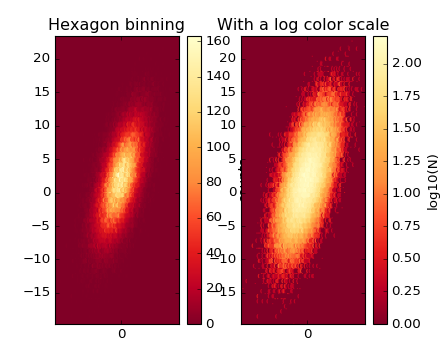
Notes
In addition to the above described arguments, this function can take a data keyword argument. If such a data argument is given, the following arguments are replaced by data[<arg>]:
hist(x, bins=None, range=None, normed=False, weights=None, cumulative=False, bottom=None, histtype='bar', align='mid', orientation='vertical', rwidth=None, log=False, color=None, label=None, stacked=False, **kwargs)¶Plot a histogram.
Compute and draw the histogram of x. The return value is a tuple (n, bins, patches) or ([n0, n1, ...], bins, [patches0, patches1,...]) if the input contains multiple data.
Multiple data can be provided via x as a list of datasets of potentially different length ([x0, x1, ...]), or as a 2-D ndarray in which each column is a dataset. Note that the ndarray form is transposed relative to the list form.
Masked arrays are not supported at present.
| Parameters: | x : (n,) array or sequence of (n,) arrays
bins : integer or array_like or ‘auto’, optional
range : tuple or None, optional
normed : boolean, optional
weights : (n, ) array_like or None, optional
cumulative : boolean, optional
bottom : array_like, scalar, or None
histtype : {‘bar’, ‘barstacked’, ‘step’, ‘stepfilled’}, optional
align : {‘left’, ‘mid’, ‘right’}, optional
orientation : {‘horizontal’, ‘vertical’}, optional
rwidth : scalar or None, optional
log : boolean, optional
color : color or array_like of colors or None, optional
label : string or None, optional
stacked : boolean, optional
|
|---|---|
| Returns: | n : array or list of arrays
bins : array
patches : list or list of lists
|
| Other Parameters: | |
kwargs : |
|
See also
hist2dNotes
In addition to the above described arguments, this function can take a data keyword argument. If such a data argument is given, the following arguments are replaced by data[<arg>]:
Examples
(Source code, png)
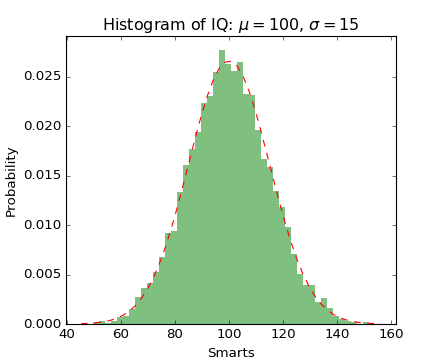
hist2d(x, y, bins=10, range=None, normed=False, weights=None, cmin=None, cmax=None, **kwargs)¶Make a 2D histogram plot.
| Parameters: | x, y: array_like, shape (n, )
bins: [None | int | [int, int] | array_like | [array, array]]
range : array_like shape(2, 2), optional, default: None
normed : boolean, optional, default: False
weights : array_like, shape (n, ), optional, default: None
cmin : scalar, optional, default: None
cmax : scalar, optional, default: None
|
|---|---|
| Returns: | The return value is |
| Other Parameters: | |
kwargs : |
|
See also
histNotes
In addition to the above described arguments, this function can take a data keyword argument. If such a data argument is given, the following arguments are replaced by data[<arg>]:
Examples
(Source code, png)
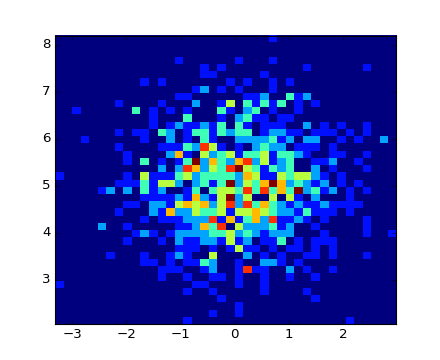
hitlist(event)¶List the children of the artist which contain the mouse event event.
hlines(y, xmin, xmax, colors='k', linestyles='solid', label='', **kwargs)¶Plot horizontal lines at each y from xmin to xmax.
| Parameters: | y : scalar or sequence of scalar
xmin, xmax : scalar or 1D array_like
colors : array_like of colors, optional, default: ‘k’ linestyles : [‘solid’ | ‘dashed’ | ‘dashdot’ | ‘dotted’], optional label : string, optional, default: ‘’ |
|---|---|
| Returns: | lines : |
| Other Parameters: | |
kwargs : |
|
See also
vlinesNotes
In addition to the above described arguments, this function can take a data keyword argument. If such a data argument is given, the following arguments are replaced by data[<arg>]:
Examples
(Source code, png)
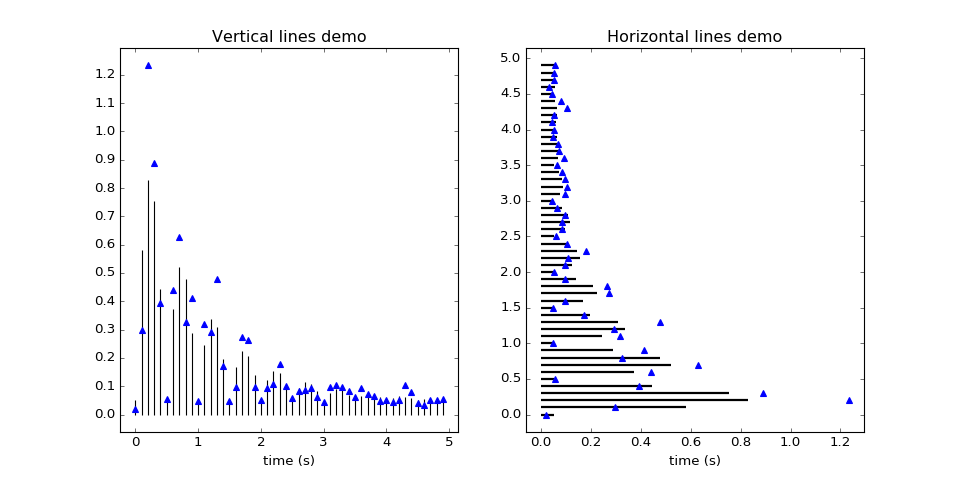
hold(b=None)¶Call signature:
hold(b=None)
Set the hold state. If hold is None (default), toggle the hold state. Else set the hold state to boolean value b.
Examples:
# toggle hold
hold()
# turn hold on
hold(True)
# turn hold off
hold(False)
When hold is True, subsequent plot commands will be added to the current axes. When hold is False, the current axes and figure will be cleared on the next plot command
imshow(X, cmap=None, norm=None, aspect=None, interpolation=None, alpha=None, vmin=None, vmax=None, origin=None, extent=None, shape=None, filternorm=1, filterrad=4.0, imlim=None, resample=None, url=None, **kwargs)¶Display an image on the axes.
| Parameters: | X : array_like, shape (n, m) or (n, m, 3) or (n, m, 4)
cmap :
aspect : [‘auto’ | ‘equal’ | scalar], optional, default: None
interpolation : string, optional, default: None
norm :
vmin, vmax : scalar, optional, default: None
alpha : scalar, optional, default: None
origin : [‘upper’ | ‘lower’], optional, default: None
extent : scalars (left, right, bottom, top), optional, default: None
shape : scalars (columns, rows), optional, default: None
filternorm : scalar, optional, default: 1
filterrad : scalar, optional, default: 4.0
|
|---|---|
| Returns: | image : |
| Other Parameters: | |
kwargs : |
|
See also
matshowNotes
In addition to the above described arguments, this function can take a data keyword argument. If such a data argument is given, the following arguments are replaced by data[<arg>]:
Examples
(Source code, png)
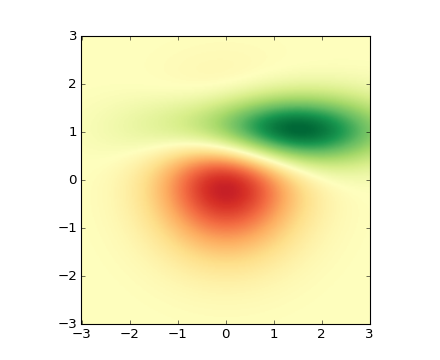
in_axes(mouseevent)¶Return True if the given mouseevent (in display coords) is in the Axes
invert_xaxis()¶Invert the x-axis.
invert_yaxis()¶Invert the y-axis.
is_transform_set()¶Returns True if Artist has a transform explicitly
set.
ishold()¶return the HOLD status of the axes
left_margin¶Get whether a margin should be applied to the left of the Artist.
legend(*args, **kwargs)¶Places a legend on the axes.
To make a legend for lines which already exist on the axes (via plot for instance), simply call this function with an iterable of strings, one for each legend item. For example:
ax.plot([1, 2, 3])
ax.legend(['A simple line'])
However, in order to keep the “label” and the legend element
instance together, it is preferable to specify the label either at
artist creation, or by calling the
set_label() method on the artist:
line, = ax.plot([1, 2, 3], label='Inline label')
# Overwrite the label by calling the method.
line.set_label('Label via method')
ax.legend()
Specific lines can be excluded from the automatic legend element
selection by defining a label starting with an underscore.
This is default for all artists, so calling legend() without
any arguments and without setting the labels manually will result in
no legend being drawn.
For full control of which artists have a legend entry, it is possible to pass an iterable of legend artists followed by an iterable of legend labels respectively:
legend((line1, line2, line3), ('label1', 'label2', 'label3'))
| Parameters: | loc : int or string or pair of floats, default: ‘upper right’
bbox_to_anchor :
ncol : integer
prop : None or
fontsize : int or float or {‘xx-small’, ‘x-small’, ‘small’, ‘medium’, ‘large’, ‘x-large’, ‘xx-large’}
numpoints : None or int
scatterpoints : None or int
scatteryoffsets : iterable of floats
markerscale : None or int or float
*markerfirst*: [ *True* | *False* ]
frameon : None or bool
fancybox : None or bool
shadow : None or bool
framealpha : None or float
mode : {“expand”, None}
bbox_transform : None or
title : str or None
borderpad : float or None
labelspacing : float or None
handlelength : float or None
handletextpad : float or None
borderaxespad : float or None
columnspacing : float or None
handler_map : dict or None
|
|---|
Notes
Not all kinds of artist are supported by the legend command. See Legend guide for details.
Examples
(Source code, png)
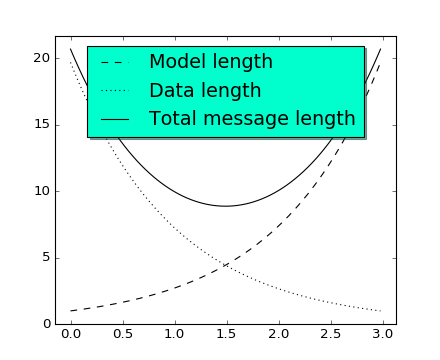
locator_params(axis='both', tight=None, **kwargs)¶Control behavior of tick locators.
Keyword arguments:
autoscale_view().
Default is None, for no change.Remaining keyword arguments are passed to directly to the
set_params() method.
Typically one might want to reduce the maximum number of ticks and use tight bounds when plotting small subplots, for example:
ax.locator_params(tight=True, nbins=4)
Because the locator is involved in autoscaling,
autoscale_view() is called automatically after
the parameters are changed.
This presently works only for the
MaxNLocator used
by default on linear axes, but it may be generalized.
loglog(*args, **kwargs)¶Make a plot with log scaling on both the x and y axis.
Call signature:
loglog(*args, **kwargs)
loglog() supports all the keyword
arguments of plot() and
matplotlib.axes.Axes.set_xscale() /
matplotlib.axes.Axes.set_yscale().
Notable keyword arguments:
- basex/basey: scalar > 1
- Base of the x/y logarithm
- subsx/subsy: [ None | sequence ]
- The location of the minor x/y ticks; None defaults to autosubs, which depend on the number of decades in the plot; see
matplotlib.axes.Axes.set_xscale()/matplotlib.axes.Axes.set_yscale()for details- nonposx/nonposy: [‘mask’ | ‘clip’ ]
- Non-positive values in x or y can be masked as invalid, or clipped to a very small positive number
The remaining valid kwargs are
Line2D properties:
Property Description agg_filterunknown alphafloat (0.0 transparent through 1.0 opaque) animated[True | False] antialiasedor aa[True | False] axesan Axesinstancebottom_marginunknown clip_boxa matplotlib.transforms.Bboxinstanceclip_on[True | False] clip_path[ ( Path,Transform) |Patch| None ]coloror cany matplotlib color containsa callable function dash_capstyle[‘butt’ | ‘round’ | ‘projecting’] dash_joinstyle[‘miter’ | ‘round’ | ‘bevel’] dashessequence of on/off ink in points drawstyle[‘default’ | ‘steps’ | ‘steps-pre’ | ‘steps-mid’ | ‘steps-post’] figurea matplotlib.figure.Figureinstancefillstyle[‘full’ | ‘left’ | ‘right’ | ‘bottom’ | ‘top’ | ‘none’] gidan id string labelstring or anything printable with ‘%s’ conversion. left_marginunknown linestyleor ls[‘solid’ | ‘dashed’, ‘dashdot’, ‘dotted’ | (offset, on-off-dash-seq) | '-'|'--'|'-.'|':'|'None'|' '|'']linewidthor lwfloat value in points marginsunknown markerA valid marker stylemarkeredgecoloror mecany matplotlib color markeredgewidthor mewfloat value in points markerfacecoloror mfcany matplotlib color markerfacecoloraltor mfcaltany matplotlib color markersizeor msfloat markevery[None | int | length-2 tuple of int | slice | list/array of int | float | length-2 tuple of float] path_effectsunknown pickerfloat distance in points or callable pick function fn(artist, event)pickradiusfloat distance in points rasterized[True | False | None] right_marginunknown sketch_paramsunknown snapunknown solid_capstyle[‘butt’ | ‘round’ | ‘projecting’] solid_joinstyle[‘miter’ | ‘round’ | ‘bevel’] top_marginunknown transforma matplotlib.transforms.Transforminstanceurla url string visible[True | False] xdata1D array ydata1D array zorderany number
Example:
(Source code, png)
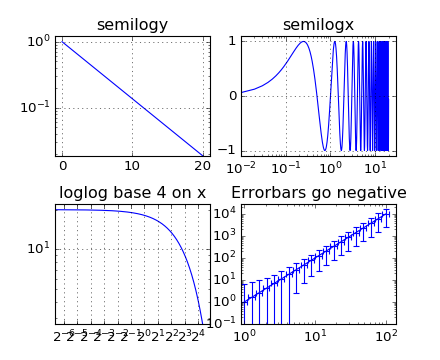
magnitude_spectrum(x, Fs=None, Fc=None, window=None, pad_to=None, sides=None, scale=None, **kwargs)¶Plot the magnitude spectrum.
Call signature:
magnitude_spectrum(x, Fs=2, Fc=0, window=mlab.window_hanning,
pad_to=None, sides='default', **kwargs)
Compute the magnitude spectrum of x. Data is padded to a length of pad_to and the windowing function window is applied to the signal.
- x: 1-D array or sequence
- Array or sequence containing the data
Keyword arguments:
- Fs: scalar
- The sampling frequency (samples per time unit). It is used to calculate the Fourier frequencies, freqs, in cycles per time unit. The default value is 2.
- window: callable or ndarray
- A function or a vector of length NFFT. To create window vectors see
window_hanning(),window_none(),numpy.blackman(),numpy.hamming(),numpy.bartlett(),scipy.signal(),scipy.signal.get_window(), etc. The default iswindow_hanning(). If a function is passed as the argument, it must take a data segment as an argument and return the windowed version of the segment.- sides: [ ‘default’ | ‘onesided’ | ‘twosided’ ]
- Specifies which sides of the spectrum to return. Default gives the default behavior, which returns one-sided for real data and both for complex data. ‘onesided’ forces the return of a one-sided spectrum, while ‘twosided’ forces two-sided.
The number of points to which the data segment is padded when performing the FFT. While not increasing the actual resolution of the spectrum (the minimum distance between resolvable peaks), this can give more points in the plot, allowing for more detail. This corresponds to the n parameter in the call to fft(). The default is None, which sets pad_to equal to the length of the input signal (i.e. no padding).
Returns the tuple (spectrum, freqs, line):
- spectrum: 1-D array
- The values for the magnitude spectrum before scaling (real valued)
- freqs: 1-D array
- The frequencies corresponding to the elements in spectrum
- line: a
Line2Dinstance- The line created by this function
kwargs control the Line2D properties:
Property Description agg_filterunknown alphafloat (0.0 transparent through 1.0 opaque) animated[True | False] antialiasedor aa[True | False] axesan Axesinstancebottom_marginunknown clip_boxa matplotlib.transforms.Bboxinstanceclip_on[True | False] clip_path[ ( Path,Transform) |Patch| None ]coloror cany matplotlib color containsa callable function dash_capstyle[‘butt’ | ‘round’ | ‘projecting’] dash_joinstyle[‘miter’ | ‘round’ | ‘bevel’] dashessequence of on/off ink in points drawstyle[‘default’ | ‘steps’ | ‘steps-pre’ | ‘steps-mid’ | ‘steps-post’] figurea matplotlib.figure.Figureinstancefillstyle[‘full’ | ‘left’ | ‘right’ | ‘bottom’ | ‘top’ | ‘none’] gidan id string labelstring or anything printable with ‘%s’ conversion. left_marginunknown linestyleor ls[‘solid’ | ‘dashed’, ‘dashdot’, ‘dotted’ | (offset, on-off-dash-seq) | '-'|'--'|'-.'|':'|'None'|' '|'']linewidthor lwfloat value in points marginsunknown markerA valid marker stylemarkeredgecoloror mecany matplotlib color markeredgewidthor mewfloat value in points markerfacecoloror mfcany matplotlib color markerfacecoloraltor mfcaltany matplotlib color markersizeor msfloat markevery[None | int | length-2 tuple of int | slice | list/array of int | float | length-2 tuple of float] path_effectsunknown pickerfloat distance in points or callable pick function fn(artist, event)pickradiusfloat distance in points rasterized[True | False | None] right_marginunknown sketch_paramsunknown snapunknown solid_capstyle[‘butt’ | ‘round’ | ‘projecting’] solid_joinstyle[‘miter’ | ‘round’ | ‘bevel’] top_marginunknown transforma matplotlib.transforms.Transforminstanceurla url string visible[True | False] xdata1D array ydata1D array zorderany number
Example:
(Source code, png)

See also
psd()psd() plots the power spectral density.`.angle_spectrum()angle_spectrum() plots the angles of the corresponding
frequencies.phase_spectrum()phase_spectrum() plots the phase (unwrapped angle) of the
corresponding frequencies.specgram()specgram() can plot the magnitude spectrum of segments
within the signal in a colormap.Notes
In addition to the above described arguments, this function can take a data keyword argument. If such a data argument is given, the following arguments are replaced by data[<arg>]:
margins(*args, **kw)¶Set or retrieve autoscaling margins.
signatures:
margins()
returns xmargin, ymargin
margins(margin)
margins(xmargin, ymargin)
margins(x=xmargin, y=ymargin)
margins(..., tight=False)
All three forms above set the xmargin and ymargin parameters.
All keyword parameters are optional. A single argument
specifies both xmargin and ymargin. The tight parameter
is passed to autoscale_view(), which is executed after
a margin is changed; the default here is True, on the
assumption that when margins are specified, no additional
padding to match tick marks is usually desired. Setting
tight to None will preserve the previous setting.
Specifying any margin changes only the autoscaling; for example, if xmargin is not None, then xmargin times the X data interval will be added to each end of that interval before it is used in autoscaling.
matshow(Z, **kwargs)¶Plot a matrix or array as an image.
The matrix will be shown the way it would be printed, with the first row at the top. Row and column numbering is zero-based.
| Parameters: | Z : array_like shape (n, m)
|
|---|---|
| Returns: | image : |
| Other Parameters: | |
kwargs :
|
|
See also
imshowExamples
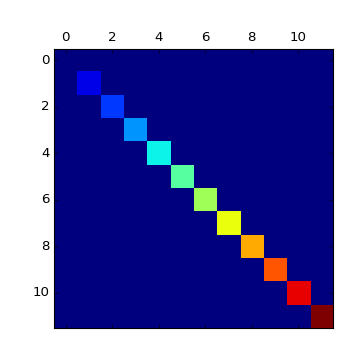
(png)
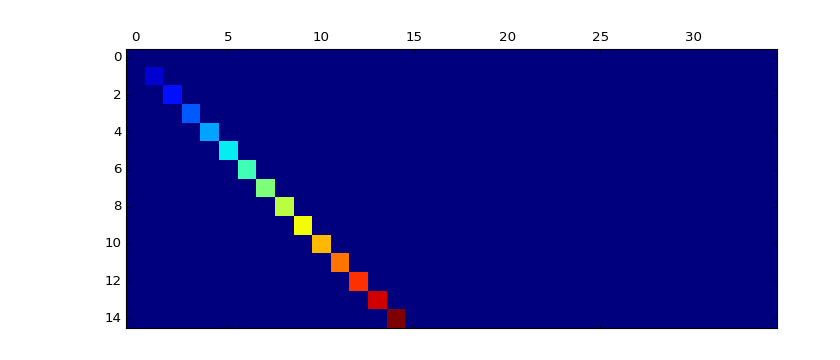
(png)
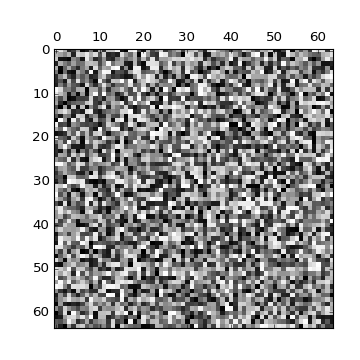
(png)
minorticks_off()¶Remove minor ticks from the axes.
minorticks_on()¶Add autoscaling minor ticks to the axes.
mouseover¶name = 'rectilinear'¶pchanged()¶Fire an event when property changed, calling all of the registered callbacks.
pcolor(*args, **kwargs)¶Create a pseudocolor plot of a 2-D array.
Note
pcolor can be very slow for large arrays; consider
using the similar but much faster
pcolormesh() instead.
Call signatures:
pcolor(C, **kwargs)
pcolor(X, Y, C, **kwargs)
C is the array of color values.
X and Y, if given, specify the (x, y) coordinates of the colored quadrilaterals; the quadrilateral for C[i,j] has corners at:
(X[i, j], Y[i, j]),
(X[i, j+1], Y[i, j+1]),
(X[i+1, j], Y[i+1, j]),
(X[i+1, j+1], Y[i+1, j+1]).
Ideally the dimensions of X and Y should be one greater than those of C; if the dimensions are the same, then the last row and column of C will be ignored.
Note that the column index corresponds to the x-coordinate, and the row index corresponds to y; for details, see the Grid Orientation section below.
If either or both of X and Y are 1-D arrays or column vectors, they will be expanded as needed into the appropriate 2-D arrays, making a rectangular grid.
X, Y and C may be masked arrays. If either C[i, j], or one of the vertices surrounding C[i,j] (X or Y at [i, j], [i+1, j], [i, j+1],[i+1, j+1]) is masked, nothing is plotted.
Keyword arguments:
- cmap: [ None | Colormap ]
- A
matplotlib.colors.Colormapinstance. If None, use rc settings.- norm: [ None | Normalize ]
- An
matplotlib.colors.Normalizeinstance is used to scale luminance data to 0,1. If None, defaults tonormalize().- vmin/vmax: [ None | scalar ]
- vmin and vmax are used in conjunction with norm to normalize luminance data. If either is None, it is autoscaled to the respective min or max of the color array C. If not None, vmin or vmax passed in here override any pre-existing values supplied in the norm instance.
- shading: [ ‘flat’ | ‘faceted’ ]
If ‘faceted’, a black grid is drawn around each rectangle; if ‘flat’, edges are not drawn. Default is ‘flat’, contrary to MATLAB.
- This kwarg is deprecated; please use ‘edgecolors’ instead:
- shading=’flat’ – edgecolors=’none’
- shading=’faceted – edgecolors=’k’
- edgecolors: [ None |
'none'| color | color sequence]If None, the rc setting is used by default.
If
'none', edges will not be visible.An mpl color or sequence of colors will set the edge color
- alpha:
0 <= scalar <= 1or None- the alpha blending value
- snap: bool
- Whether to snap the mesh to pixel boundaries.
Return value is a matplotlib.collections.Collection
instance.
The grid orientation follows the MATLAB convention: an array C with shape (nrows, ncolumns) is plotted with the column number as X and the row number as Y, increasing up; hence it is plotted the way the array would be printed, except that the Y axis is reversed. That is, C is taken as C*(*y, x).
Similarly for meshgrid():
x = np.arange(5)
y = np.arange(3)
X, Y = np.meshgrid(x, y)
is equivalent to:
X = array([[0, 1, 2, 3, 4],
[0, 1, 2, 3, 4],
[0, 1, 2, 3, 4]])
Y = array([[0, 0, 0, 0, 0],
[1, 1, 1, 1, 1],
[2, 2, 2, 2, 2]])
so if you have:
C = rand(len(x), len(y))
then you need to transpose C:
pcolor(X, Y, C.T)
or:
pcolor(C.T)
MATLAB pcolor() always discards the last row and column
of C, but matplotlib displays the last row and column if X and
Y are not specified, or if X and Y have one more row and
column than C.
kwargs can be used to control the
PolyCollection properties:
Property Description agg_filterunknown alphafloat or None animated[True | False] antialiasedor antialiasedsBoolean or sequence of booleans arrayunknown axesan Axesinstancebottom_marginunknown clima length 2 sequence of floats clip_boxa matplotlib.transforms.Bboxinstanceclip_on[True | False] clip_path[ ( Path,Transform) |Patch| None ]cmapa colormap or registered colormap name colormatplotlib color arg or sequence of rgba tuples containsa callable function edgecoloror edgecolorsmatplotlib color spec or sequence of specs facecoloror facecolorsmatplotlib color spec or sequence of specs figurea matplotlib.figure.Figureinstancegidan id string hatch[ ‘/’ | ‘\’ | ‘|’ | ‘-‘ | ‘+’ | ‘x’ | ‘o’ | ‘O’ | ‘.’ | ‘*’ ] labelstring or anything printable with ‘%s’ conversion. left_marginunknown linestyleor dashes or linestyles[‘solid’ | ‘dashed’, ‘dashdot’, ‘dotted’ | (offset, on-off-dash-seq) | '-'|'--'|'-.'|':'|'None'|' '|'']linewidthor linewidths or lwfloat or sequence of floats marginsunknown normunknown offset_positionunknown offsetsfloat or sequence of floats path_effectsunknown picker[None|float|boolean|callable] pickradiusunknown rasterized[True | False | None] right_marginunknown sketch_paramsunknown snapunknown top_marginunknown transformTransforminstanceurla url string urlsunknown visible[True | False] zorderany number
Note
The default antialiaseds is False if the default edgecolors*=”none” is used. This eliminates artificial lines at patch boundaries, and works regardless of the value of alpha. If *edgecolors is not “none”, then the default antialiaseds is taken from rcParams[‘patch.antialiased’], which defaults to True. Stroking the edges may be preferred if alpha is 1, but will cause artifacts otherwise.
See also
pcolormesh()Notes
In addition to the above described arguments, this function can take a data keyword argument. If such a data argument is given, the following arguments are replaced by data[<arg>]:
pcolorfast(*args, **kwargs)¶pseudocolor plot of a 2-D array
Experimental; this is a pcolor-type method that provides the fastest possible rendering with the Agg backend, and that can handle any quadrilateral grid. It supports only flat shading (no outlines), it lacks support for log scaling of the axes, and it does not have a pyplot wrapper.
Call signatures:
ax.pcolorfast(C, **kwargs)
ax.pcolorfast(xr, yr, C, **kwargs)
ax.pcolorfast(x, y, C, **kwargs)
ax.pcolorfast(X, Y, C, **kwargs)
C is the 2D array of color values corresponding to quadrilateral cells. Let (nr, nc) be its shape. C may be a masked array.
ax.pcolorfast(C, **kwargs) is equivalent to
ax.pcolorfast([0,nc], [0,nr], C, **kwargs)
xr, yr specify the ranges of x and y corresponding to the rectangular region bounding C. If:
xr = [x0, x1]
and:
yr = [y0,y1]
then x goes from x0 to x1 as the second index of C goes from 0 to nc, etc. (x0, y0) is the outermost corner of cell (0,0), and (x1, y1) is the outermost corner of cell (nr-1, nc-1). All cells are rectangles of the same size. This is the fastest version.
x, y are 1D arrays of length nc +1 and nr +1, respectively, giving the x and y boundaries of the cells. Hence the cells are rectangular but the grid may be nonuniform. The speed is intermediate. (The grid is checked, and if found to be uniform the fast version is used.)
X and Y are 2D arrays with shape (nr +1, nc +1) that specify the (x,y) coordinates of the corners of the colored quadrilaterals; the quadrilateral for C[i,j] has corners at (X[i,j],Y[i,j]), (X[i,j+1],Y[i,j+1]), (X[i+1,j],Y[i+1,j]), (X[i+1,j+1],Y[i+1,j+1]). The cells need not be rectangular. This is the most general, but the slowest to render. It may produce faster and more compact output using ps, pdf, and svg backends, however.
Note that the column index corresponds to the x-coordinate, and the row index corresponds to y; for details, see the “Grid Orientation” section below.
Optional keyword arguments:
- cmap: [ None | Colormap ]
- A
matplotlib.colors.Colormapinstance from cm. If None, use rc settings.- norm: [ None | Normalize ]
- A
matplotlib.colors.Normalizeinstance is used to scale luminance data to 0,1. If None, defaults to normalize()- vmin/vmax: [ None | scalar ]
- vmin and vmax are used in conjunction with norm to normalize luminance data. If either are None, the min and max of the color array C is used. If you pass a norm instance, vmin and vmax will be None.
- alpha:
0 <= scalar <= 1or None- the alpha blending value
Return value is an image if a regular or rectangular grid
is specified, and a QuadMesh
collection in the general quadrilateral case.
Notes
In addition to the above described arguments, this function can take a data keyword argument. If such a data argument is given, the following arguments are replaced by data[<arg>]:
pcolormesh(*args, **kwargs)¶Plot a quadrilateral mesh.
Call signatures:
pcolormesh(C)
pcolormesh(X, Y, C)
pcolormesh(C, **kwargs)
Create a pseudocolor plot of a 2-D array.
pcolormesh is similar to pcolor(),
but uses a different mechanism and returns a different
object; pcolor returns a
PolyCollection but pcolormesh
returns a
QuadMesh. It is much faster,
so it is almost always preferred for large arrays.
C may be a masked array, but X and Y may not. Masked
array support is implemented via cmap and norm; in
contrast, pcolor() simply does not
draw quadrilaterals with masked colors or vertices.
Keyword arguments:
- cmap: [ None | Colormap ]
- A
matplotlib.colors.Colormapinstance. If None, use rc settings.- norm: [ None | Normalize ]
- A
matplotlib.colors.Normalizeinstance is used to scale luminance data to 0,1. If None, defaults tonormalize().- vmin/vmax: [ None | scalar ]
- vmin and vmax are used in conjunction with norm to normalize luminance data. If either is None, it is autoscaled to the respective min or max of the color array C. If not None, vmin or vmax passed in here override any pre-existing values supplied in the norm instance.
- shading: [ ‘flat’ | ‘gouraud’ ]
- ‘flat’ indicates a solid color for each quad. When ‘gouraud’, each quad will be Gouraud shaded. When gouraud shading, edgecolors is ignored.
- edgecolors: [None |
'None'|'face'| color |If None, the rc setting is used by default.
If
'None', edges will not be visible.If
'face', edges will have the same color as the faces.An mpl color or sequence of colors will set the edge color
- alpha:
0 <= scalar <= 1or None- the alpha blending value
Return value is a matplotlib.collections.QuadMesh
object.
kwargs can be used to control the
matplotlib.collections.QuadMesh properties:
Property Description agg_filterunknown alphafloat or None animated[True | False] antialiasedor antialiasedsBoolean or sequence of booleans arrayunknown axesan Axesinstancebottom_marginunknown clima length 2 sequence of floats clip_boxa matplotlib.transforms.Bboxinstanceclip_on[True | False] clip_path[ ( Path,Transform) |Patch| None ]cmapa colormap or registered colormap name colormatplotlib color arg or sequence of rgba tuples containsa callable function edgecoloror edgecolorsmatplotlib color spec or sequence of specs facecoloror facecolorsmatplotlib color spec or sequence of specs figurea matplotlib.figure.Figureinstancegidan id string hatch[ ‘/’ | ‘\’ | ‘|’ | ‘-‘ | ‘+’ | ‘x’ | ‘o’ | ‘O’ | ‘.’ | ‘*’ ] labelstring or anything printable with ‘%s’ conversion. left_marginunknown linestyleor dashes or linestyles[‘solid’ | ‘dashed’, ‘dashdot’, ‘dotted’ | (offset, on-off-dash-seq) | '-'|'--'|'-.'|':'|'None'|' '|'']linewidthor linewidths or lwfloat or sequence of floats marginsunknown normunknown offset_positionunknown offsetsfloat or sequence of floats path_effectsunknown picker[None|float|boolean|callable] pickradiusunknown rasterized[True | False | None] right_marginunknown sketch_paramsunknown snapunknown top_marginunknown transformTransforminstanceurla url string urlsunknown visible[True | False] zorderany number
See also
pcolor()Notes
In addition to the above described arguments, this function can take a data keyword argument. If such a data argument is given, the following arguments are replaced by data[<arg>]:
phase_spectrum(x, Fs=None, Fc=None, window=None, pad_to=None, sides=None, **kwargs)¶Plot the phase spectrum.
Call signature:
phase_spectrum(x, Fs=2, Fc=0, window=mlab.window_hanning,
pad_to=None, sides='default', **kwargs)
Compute the phase spectrum (unwrapped angle spectrum) of x. Data is padded to a length of pad_to and the windowing function window is applied to the signal.
- x: 1-D array or sequence
- Array or sequence containing the data
Keyword arguments:
- Fs: scalar
- The sampling frequency (samples per time unit). It is used to calculate the Fourier frequencies, freqs, in cycles per time unit. The default value is 2.
- window: callable or ndarray
- A function or a vector of length NFFT. To create window vectors see
window_hanning(),window_none(),numpy.blackman(),numpy.hamming(),numpy.bartlett(),scipy.signal(),scipy.signal.get_window(), etc. The default iswindow_hanning(). If a function is passed as the argument, it must take a data segment as an argument and return the windowed version of the segment.- sides: [ ‘default’ | ‘onesided’ | ‘twosided’ ]
- Specifies which sides of the spectrum to return. Default gives the default behavior, which returns one-sided for real data and both for complex data. ‘onesided’ forces the return of a one-sided spectrum, while ‘twosided’ forces two-sided.
The number of points to which the data segment is padded when performing the FFT. While not increasing the actual resolution of the spectrum (the minimum distance between resolvable peaks), this can give more points in the plot, allowing for more detail. This corresponds to the n parameter in the call to fft(). The default is None, which sets pad_to equal to the length of the input signal (i.e. no padding).
Returns the tuple (spectrum, freqs, line):
- spectrum: 1-D array
- The values for the phase spectrum in radians (real valued)
- freqs: 1-D array
- The frequencies corresponding to the elements in spectrum
- line: a
Line2Dinstance- The line created by this function
kwargs control the Line2D properties:
Property Description agg_filterunknown alphafloat (0.0 transparent through 1.0 opaque) animated[True | False] antialiasedor aa[True | False] axesan Axesinstancebottom_marginunknown clip_boxa matplotlib.transforms.Bboxinstanceclip_on[True | False] clip_path[ ( Path,Transform) |Patch| None ]coloror cany matplotlib color containsa callable function dash_capstyle[‘butt’ | ‘round’ | ‘projecting’] dash_joinstyle[‘miter’ | ‘round’ | ‘bevel’] dashessequence of on/off ink in points drawstyle[‘default’ | ‘steps’ | ‘steps-pre’ | ‘steps-mid’ | ‘steps-post’] figurea matplotlib.figure.Figureinstancefillstyle[‘full’ | ‘left’ | ‘right’ | ‘bottom’ | ‘top’ | ‘none’] gidan id string labelstring or anything printable with ‘%s’ conversion. left_marginunknown linestyleor ls[‘solid’ | ‘dashed’, ‘dashdot’, ‘dotted’ | (offset, on-off-dash-seq) | '-'|'--'|'-.'|':'|'None'|' '|'']linewidthor lwfloat value in points marginsunknown markerA valid marker stylemarkeredgecoloror mecany matplotlib color markeredgewidthor mewfloat value in points markerfacecoloror mfcany matplotlib color markerfacecoloraltor mfcaltany matplotlib color markersizeor msfloat markevery[None | int | length-2 tuple of int | slice | list/array of int | float | length-2 tuple of float] path_effectsunknown pickerfloat distance in points or callable pick function fn(artist, event)pickradiusfloat distance in points rasterized[True | False | None] right_marginunknown sketch_paramsunknown snapunknown solid_capstyle[‘butt’ | ‘round’ | ‘projecting’] solid_joinstyle[‘miter’ | ‘round’ | ‘bevel’] top_marginunknown transforma matplotlib.transforms.Transforminstanceurla url string visible[True | False] xdata1D array ydata1D array zorderany number
Example:
(Source code, png)

See also
magnitude_spectrum()magnitude_spectrum() plots the magnitudes of the
corresponding frequencies.angle_spectrum()angle_spectrum() plots the wrapped version of this
function.specgram()specgram() can plot the phase spectrum of segments
within the signal in a colormap.Notes
In addition to the above described arguments, this function can take a data keyword argument. If such a data argument is given, the following arguments are replaced by data[<arg>]:
pick(*args)¶Call signature:
pick(mouseevent)
each child artist will fire a pick event if mouseevent is over the artist and the artist has picker set
pickable()¶Return True if Artist is pickable.
pie(x, explode=None, labels=None, colors=None, autopct=None, pctdistance=0.6, shadow=False, labeldistance=1.1, startangle=None, radius=None, counterclock=True, wedgeprops=None, textprops=None, center=(0, 0), frame=False)¶Plot a pie chart.
Call signature:
pie(x, explode=None, labels=None,
colors=('b', 'g', 'r', 'c', 'm', 'y', 'k', 'w'),
autopct=None, pctdistance=0.6, shadow=False,
labeldistance=1.1, startangle=None, radius=None,
counterclock=True, wedgeprops=None, textprops=None,
center = (0, 0), frame = False )
Make a pie chart of array x. The fractional area of each wedge is given by x/sum(x). If sum(x) <= 1, then the values of x give the fractional area directly and the array will not be normalized. The wedges are plotted counterclockwise, by default starting from the x-axis.
Keyword arguments:
- explode: [ None | len(x) sequence ]
- If not None, is a
len(x)array which specifies the fraction of the radius with which to offset each wedge.- colors: [ None | color sequence ]
- A sequence of matplotlib color args through which the pie chart will cycle.
- labels: [ None | len(x) sequence of strings ]
- A sequence of strings providing the labels for each wedge
- autopct: [ None | format string | format function ]
- If not None, is a string or function used to label the wedges with their numeric value. The label will be placed inside the wedge. If it is a format string, the label will be
fmt%pct. If it is a function, it will be called.- pctdistance: scalar
- The ratio between the center of each pie slice and the start of the text generated by autopct. Ignored if autopct is None; default is 0.6.
- labeldistance: scalar
- The radial distance at which the pie labels are drawn
- shadow: [ False | True ]
- Draw a shadow beneath the pie.
- startangle: [ None | Offset angle ]
- If not None, rotates the start of the pie chart by angle degrees counterclockwise from the x-axis.
radius: [ None | scalar ] The radius of the pie, if radius is None it will be set to 1.
- counterclock: [ False | True ]
- Specify fractions direction, clockwise or counterclockwise.
- wedgeprops: [ None | dict of key value pairs ]
- Dict of arguments passed to the wedge objects making the pie. For example, you can pass in wedgeprops = { ‘linewidth’ : 3 } to set the width of the wedge border lines equal to 3. For more details, look at the doc/arguments of the wedge object. By default
clip_on=False.- textprops: [ None | dict of key value pairs ]
- Dict of arguments to pass to the text objects.
center: [ (0,0) | sequence of 2 scalars ] Center position of the chart.
- frame: [ False | True ]
- Plot axes frame with the chart.
The pie chart will probably look best if the figure and axes are square, or the Axes aspect is equal. e.g.:
figure(figsize=(8,8))
ax = axes([0.1, 0.1, 0.8, 0.8])
or:
axes(aspect=1)
If autopct is None, return the tuple (patches, texts):
- patches is a sequence of
matplotlib.patches.Wedgeinstances- texts is a list of the label
matplotlib.text.Textinstances.
If autopct is not None, return the tuple (patches,
texts, autotexts), where patches and texts are as
above, and autotexts is a list of
Text instances for the numeric
labels.
Notes
In addition to the above described arguments, this function can take a data keyword argument. If such a data argument is given, the following arguments are replaced by data[<arg>]:
plot(*args, **kwargs)¶Plot lines and/or markers to the
Axes. args is a variable length
argument, allowing for multiple x, y pairs with an
optional format string. For example, each of the following is
legal:
plot(x, y) # plot x and y using default line style and color
plot(x, y, 'bo') # plot x and y using blue circle markers
plot(y) # plot y using x as index array 0..N-1
plot(y, 'r+') # ditto, but with red plusses
If x and/or y is 2-dimensional, then the corresponding columns will be plotted.
If used with labeled data, make sure that the color spec is not
included as an element in data, as otherwise the last case
plot("v","r", data={"v":..., "r":...)
can be interpreted as the first case which would do plot(v, r)
using the default line style and color.
If not used with labeled data (i.e., without a data argument), an arbitrary number of x, y, fmt groups can be specified, as in:
a.plot(x1, y1, 'g^', x2, y2, 'g-')
Return value is a list of lines that were added.
By default, each line is assigned a different style specified by a ‘style cycle’. To change this behavior, you can edit the axes.prop_cycle rcParam.
The following format string characters are accepted to control the line style or marker:
| character | description |
|---|---|
'-' |
solid line style |
'--' |
dashed line style |
'-.' |
dash-dot line style |
':' |
dotted line style |
'.' |
point marker |
',' |
pixel marker |
'o' |
circle marker |
'v' |
triangle_down marker |
'^' |
triangle_up marker |
'<' |
triangle_left marker |
'>' |
triangle_right marker |
'1' |
tri_down marker |
'2' |
tri_up marker |
'3' |
tri_left marker |
'4' |
tri_right marker |
's' |
square marker |
'p' |
pentagon marker |
'*' |
star marker |
'h' |
hexagon1 marker |
'H' |
hexagon2 marker |
'+' |
plus marker |
'x' |
x marker |
'D' |
diamond marker |
'd' |
thin_diamond marker |
'|' |
vline marker |
'_' |
hline marker |
The following color abbreviations are supported:
| character | color |
|---|---|
| ‘b’ | blue |
| ‘g’ | green |
| ‘r’ | red |
| ‘c’ | cyan |
| ‘m’ | magenta |
| ‘y’ | yellow |
| ‘k’ | black |
| ‘w’ | white |
In addition, you can specify colors in many weird and
wonderful ways, including full names ('green'), hex
strings ('#008000'), RGB or RGBA tuples ((0,1,0,1)) or
grayscale intensities as a string ('0.8'). Of these, the
string specifications can be used in place of a fmt group,
but the tuple forms can be used only as kwargs.
Line styles and colors are combined in a single format string, as in
'bo' for blue circles.
The kwargs can be used to set line properties (any property that has
a set_* method). You can use this to set a line label (for auto
legends), linewidth, anitialising, marker face color, etc. Here is an
example:
plot([1,2,3], [1,2,3], 'go-', label='line 1', linewidth=2)
plot([1,2,3], [1,4,9], 'rs', label='line 2')
axis([0, 4, 0, 10])
legend()
If you make multiple lines with one plot command, the kwargs apply to all those lines, e.g.:
plot(x1, y1, x2, y2, antialiased=False)
Neither line will be antialiased.
You do not need to use format strings, which are just abbreviations. All of the line properties can be controlled by keyword arguments. For example, you can set the color, marker, linestyle, and markercolor with:
plot(x, y, color='green', linestyle='dashed', marker='o',
markerfacecolor='blue', markersize=12).
See Line2D for details.
The kwargs are Line2D properties:
Property Description agg_filterunknown alphafloat (0.0 transparent through 1.0 opaque) animated[True | False] antialiasedor aa[True | False] axesan Axesinstancebottom_marginunknown clip_boxa matplotlib.transforms.Bboxinstanceclip_on[True | False] clip_path[ ( Path,Transform) |Patch| None ]coloror cany matplotlib color containsa callable function dash_capstyle[‘butt’ | ‘round’ | ‘projecting’] dash_joinstyle[‘miter’ | ‘round’ | ‘bevel’] dashessequence of on/off ink in points drawstyle[‘default’ | ‘steps’ | ‘steps-pre’ | ‘steps-mid’ | ‘steps-post’] figurea matplotlib.figure.Figureinstancefillstyle[‘full’ | ‘left’ | ‘right’ | ‘bottom’ | ‘top’ | ‘none’] gidan id string labelstring or anything printable with ‘%s’ conversion. left_marginunknown linestyleor ls[‘solid’ | ‘dashed’, ‘dashdot’, ‘dotted’ | (offset, on-off-dash-seq) | '-'|'--'|'-.'|':'|'None'|' '|'']linewidthor lwfloat value in points marginsunknown markerA valid marker stylemarkeredgecoloror mecany matplotlib color markeredgewidthor mewfloat value in points markerfacecoloror mfcany matplotlib color markerfacecoloraltor mfcaltany matplotlib color markersizeor msfloat markevery[None | int | length-2 tuple of int | slice | list/array of int | float | length-2 tuple of float] path_effectsunknown pickerfloat distance in points or callable pick function fn(artist, event)pickradiusfloat distance in points rasterized[True | False | None] right_marginunknown sketch_paramsunknown snapunknown solid_capstyle[‘butt’ | ‘round’ | ‘projecting’] solid_joinstyle[‘miter’ | ‘round’ | ‘bevel’] top_marginunknown transforma matplotlib.transforms.Transforminstanceurla url string visible[True | False] xdata1D array ydata1D array zorderany number
kwargs scalex and scaley, if defined, are passed on to
autoscale_view() to determine
whether the x and y axes are autoscaled; the default is
True.
Notes
In addition to the above described arguments, this function can take a data keyword argument. If such a data argument is given, the following arguments are replaced by data[<arg>]:
plot_date(x, y, fmt='o', tz=None, xdate=True, ydate=False, **kwargs)¶Plot with data with dates.
Call signature:
plot_date(x, y, fmt='bo', tz=None, xdate=True,
ydate=False, **kwargs)
Similar to the plot() command, except
the x or y (or both) data is considered to be dates, and the
axis is labeled accordingly.
x and/or y can be a sequence of dates represented as float days since 0001-01-01 UTC.
Keyword arguments:
- fmt: string
- The plot format string.
- tz: [ None | timezone string |
tzinfoinstance]- The time zone to use in labeling dates. If None, defaults to rc value.
- xdate: [ True | False ]
- If True, the x-axis will be labeled with dates.
- ydate: [ False | True ]
- If True, the y-axis will be labeled with dates.
Note if you are using custom date tickers and formatters, it
may be necessary to set the formatters/locators after the call
to plot_date() since plot_date() will set the
default tick locator to
matplotlib.dates.AutoDateLocator (if the tick
locator is not already set to a
matplotlib.dates.DateLocator instance) and the
default tick formatter to
matplotlib.dates.AutoDateFormatter (if the tick
formatter is not already set to a
matplotlib.dates.DateFormatter instance).
Valid kwargs are Line2D properties:
Property Description agg_filterunknown alphafloat (0.0 transparent through 1.0 opaque) animated[True | False] antialiasedor aa[True | False] axesan Axesinstancebottom_marginunknown clip_boxa matplotlib.transforms.Bboxinstanceclip_on[True | False] clip_path[ ( Path,Transform) |Patch| None ]coloror cany matplotlib color containsa callable function dash_capstyle[‘butt’ | ‘round’ | ‘projecting’] dash_joinstyle[‘miter’ | ‘round’ | ‘bevel’] dashessequence of on/off ink in points drawstyle[‘default’ | ‘steps’ | ‘steps-pre’ | ‘steps-mid’ | ‘steps-post’] figurea matplotlib.figure.Figureinstancefillstyle[‘full’ | ‘left’ | ‘right’ | ‘bottom’ | ‘top’ | ‘none’] gidan id string labelstring or anything printable with ‘%s’ conversion. left_marginunknown linestyleor ls[‘solid’ | ‘dashed’, ‘dashdot’, ‘dotted’ | (offset, on-off-dash-seq) | '-'|'--'|'-.'|':'|'None'|' '|'']linewidthor lwfloat value in points marginsunknown markerA valid marker stylemarkeredgecoloror mecany matplotlib color markeredgewidthor mewfloat value in points markerfacecoloror mfcany matplotlib color markerfacecoloraltor mfcaltany matplotlib color markersizeor msfloat markevery[None | int | length-2 tuple of int | slice | list/array of int | float | length-2 tuple of float] path_effectsunknown pickerfloat distance in points or callable pick function fn(artist, event)pickradiusfloat distance in points rasterized[True | False | None] right_marginunknown sketch_paramsunknown snapunknown solid_capstyle[‘butt’ | ‘round’ | ‘projecting’] solid_joinstyle[‘miter’ | ‘round’ | ‘bevel’] top_marginunknown transforma matplotlib.transforms.Transforminstanceurla url string visible[True | False] xdata1D array ydata1D array zorderany number
See also
dates for helper functions
date2num(),
num2date() and
drange() for help on creating the required
floating point dates.
Notes
In addition to the above described arguments, this function can take a data keyword argument. If such a data argument is given, the following arguments are replaced by data[<arg>]:
properties()¶return a dictionary mapping property name -> value for all Artist props
psd(x, NFFT=None, Fs=None, Fc=None, detrend=None, window=None, noverlap=None, pad_to=None, sides=None, scale_by_freq=None, return_line=None, **kwargs)¶Plot the power spectral density.
Call signature:
psd(x, NFFT=256, Fs=2, Fc=0, detrend=mlab.detrend_none,
window=mlab.window_hanning, noverlap=0, pad_to=None,
sides='default', scale_by_freq=None, return_line=None, **kwargs)
The power spectral density  by Welch’s average
periodogram method. The vector x is divided into NFFT length
segments. Each segment is detrended by function detrend and
windowed by function window. noverlap gives the length of
the overlap between segments. The
by Welch’s average
periodogram method. The vector x is divided into NFFT length
segments. Each segment is detrended by function detrend and
windowed by function window. noverlap gives the length of
the overlap between segments. The  of each segment
of each segment  are averaged to compute
are averaged to compute  ,
with a scaling to correct for power loss due to windowing.
,
with a scaling to correct for power loss due to windowing.
If len(x) < NFFT, it will be zero padded to NFFT.
- x: 1-D array or sequence
- Array or sequence containing the data
Keyword arguments:
- Fs: scalar
- The sampling frequency (samples per time unit). It is used to calculate the Fourier frequencies, freqs, in cycles per time unit. The default value is 2.
- window: callable or ndarray
- A function or a vector of length NFFT. To create window vectors see
window_hanning(),window_none(),numpy.blackman(),numpy.hamming(),numpy.bartlett(),scipy.signal(),scipy.signal.get_window(), etc. The default iswindow_hanning(). If a function is passed as the argument, it must take a data segment as an argument and return the windowed version of the segment.- sides: [ ‘default’ | ‘onesided’ | ‘twosided’ ]
- Specifies which sides of the spectrum to return. Default gives the default behavior, which returns one-sided for real data and both for complex data. ‘onesided’ forces the return of a one-sided spectrum, while ‘twosided’ forces two-sided.
callable
The function applied to each segment before fft-ing,
designed to remove the mean or linear trend. Unlike in
MATLAB, where the detrend parameter is a vector, in
matplotlib is it a function. The pylab
module defines detrend_none(),
detrend_mean(), and
detrend_linear(), but you can use
a custom function as well. You can also use a string to choose
one of the functions. ‘default’, ‘constant’, and ‘mean’ call
detrend_mean(). ‘linear’ calls
detrend_linear(). ‘none’ calls
detrend_none().
Specifies whether the resulting density values should be scaled by the scaling frequency, which gives density in units of Hz^-1. This allows for integration over the returned frequency values. The default is True for MATLAB compatibility.
If return_line is False, returns the tuple (Pxx, freqs). If return_line is True, returns the tuple (Pxx, freqs. line):
- Pxx: 1-D array
- The values for the power spectrum
P_{xx}before scaling (real valued)- freqs: 1-D array
- The frequencies corresponding to the elements in Pxx
- line: a
Line2Dinstance- The line created by this function. Only returend if return_line is True.
For plotting, the power is plotted as
 for decibels, though Pxx itself
is returned.
for decibels, though Pxx itself
is returned.
kwargs control the Line2D properties:
Property Description agg_filterunknown alphafloat (0.0 transparent through 1.0 opaque) animated[True | False] antialiasedor aa[True | False] axesan Axesinstancebottom_marginunknown clip_boxa matplotlib.transforms.Bboxinstanceclip_on[True | False] clip_path[ ( Path,Transform) |Patch| None ]coloror cany matplotlib color containsa callable function dash_capstyle[‘butt’ | ‘round’ | ‘projecting’] dash_joinstyle[‘miter’ | ‘round’ | ‘bevel’] dashessequence of on/off ink in points drawstyle[‘default’ | ‘steps’ | ‘steps-pre’ | ‘steps-mid’ | ‘steps-post’] figurea matplotlib.figure.Figureinstancefillstyle[‘full’ | ‘left’ | ‘right’ | ‘bottom’ | ‘top’ | ‘none’] gidan id string labelstring or anything printable with ‘%s’ conversion. left_marginunknown linestyleor ls[‘solid’ | ‘dashed’, ‘dashdot’, ‘dotted’ | (offset, on-off-dash-seq) | '-'|'--'|'-.'|':'|'None'|' '|'']linewidthor lwfloat value in points marginsunknown markerA valid marker stylemarkeredgecoloror mecany matplotlib color markeredgewidthor mewfloat value in points markerfacecoloror mfcany matplotlib color markerfacecoloraltor mfcaltany matplotlib color markersizeor msfloat markevery[None | int | length-2 tuple of int | slice | list/array of int | float | length-2 tuple of float] path_effectsunknown pickerfloat distance in points or callable pick function fn(artist, event)pickradiusfloat distance in points rasterized[True | False | None] right_marginunknown sketch_paramsunknown snapunknown solid_capstyle[‘butt’ | ‘round’ | ‘projecting’] solid_joinstyle[‘miter’ | ‘round’ | ‘bevel’] top_marginunknown transforma matplotlib.transforms.Transforminstanceurla url string visible[True | False] xdata1D array ydata1D array zorderany number
Example:
(Source code, png)
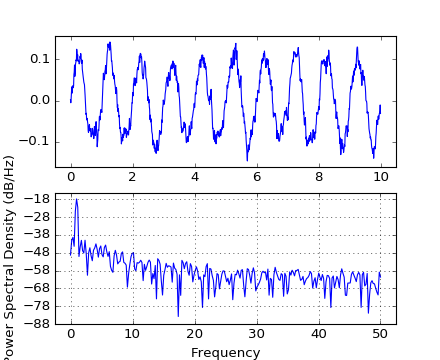
See also
specgram()specgram() differs in the default overlap; in not
returning the mean of the segment periodograms; in returning
the times of the segments; and in plotting a colormap instead
of a line.magnitude_spectrum()magnitude_spectrum() plots the magnitude spectrum.csd()csd() plots the spectral density between two signals.Notes
In addition to the above described arguments, this function can take a data keyword argument. If such a data argument is given, the following arguments are replaced by data[<arg>]:
quiver(*args, **kw)¶Plot a 2-D field of arrows.
call signatures:
quiver(U, V, **kw)
quiver(U, V, C, **kw)
quiver(X, Y, U, V, **kw)
quiver(X, Y, U, V, C, **kw)
Arguments:
- X, Y:
- The x and y coordinates of the arrow locations (default is tail of arrow; see pivot kwarg)
- U, V:
- Give the x and y components of the arrow vectors
- C:
- An optional array used to map colors to the arrows
All arguments may be 1-D or 2-D arrays or sequences. If X and Y
are absent, they will be generated as a uniform grid. If U and V
are 2-D arrays but X and Y are 1-D, and if len(X) and len(Y)
match the column and row dimensions of U, then X and Y will be
expanded with numpy.meshgrid().
U, V, C may be masked arrays, but masked X, Y are not supported at present.
Keyword arguments:
- units: [ ‘width’ | ‘height’ | ‘dots’ | ‘inches’ | ‘x’ | ‘y’ | ‘xy’ ]
Arrow units; the arrow dimensions except for length are in multiples of this unit.
- ‘width’ or ‘height’: the width or height of the axes
- ‘dots’ or ‘inches’: pixels or inches, based on the figure dpi
- ‘x’, ‘y’, or ‘xy’: X, Y, or sqrt(X^2+Y^2) data units
The arrows scale differently depending on the units. For ‘x’ or ‘y’, the arrows get larger as one zooms in; for other units, the arrow size is independent of the zoom state. For ‘width or ‘height’, the arrow size increases with the width and height of the axes, respectively, when the window is resized; for ‘dots’ or ‘inches’, resizing does not change the arrows.
- angles: [ ‘uv’ | ‘xy’ | array ]
- With the default ‘uv’, the arrow axis aspect ratio is 1, so that if U*==*V the orientation of the arrow on the plot is 45 degrees CCW from the horizontal axis (positive to the right). With ‘xy’, the arrow points from (x,y) to (x+u, y+v). Use this for plotting a gradient field, for example. Alternatively, arbitrary angles may be specified as an array of values in degrees, CCW from the horizontal axis. Note: inverting a data axis will correspondingly invert the arrows only with
angles='xy'.- scale: [ None | float ]
- Data units per arrow length unit, e.g., m/s per plot width; a smaller scale parameter makes the arrow longer. If None, a simple autoscaling algorithm is used, based on the average vector length and the number of vectors. The arrow length unit is given by the scale_units parameter
- scale_units: None, or any of the units options.
For example, if scale_units is ‘inches’, scale is 2.0, and
(u,v) = (1,0), then the vector will be 0.5 inches long. If scale_units is ‘width’, then the vector will be half the width of the axes.If scale_units is ‘x’ then the vector will be 0.5 x-axis units. To plot vectors in the x-y plane, with u and v having the same units as x and y, use “angles=’xy’, scale_units=’xy’, scale=1”.
- width:
- Shaft width in arrow units; default depends on choice of units, above, and number of vectors; a typical starting value is about 0.005 times the width of the plot.
- headwidth: scalar
- Head width as multiple of shaft width, default is 3
- headlength: scalar
- Head length as multiple of shaft width, default is 5
- headaxislength: scalar
- Head length at shaft intersection, default is 4.5
- minshaft: scalar
- Length below which arrow scales, in units of head length. Do not set this to less than 1, or small arrows will look terrible! Default is 1
- minlength: scalar
- Minimum length as a multiple of shaft width; if an arrow length is less than this, plot a dot (hexagon) of this diameter instead. Default is 1.
- pivot: [ ‘tail’ | ‘mid’ | ‘middle’ | ‘tip’ ]
- The part of the arrow that is at the grid point; the arrow rotates about this point, hence the name pivot.
- color: [ color | color sequence ]
- This is a synonym for the
PolyCollectionfacecolor kwarg. If C has been set, color has no effect.
The defaults give a slightly swept-back arrow; to make the head a triangle, make headaxislength the same as headlength. To make the arrow more pointed, reduce headwidth or increase headlength and headaxislength. To make the head smaller relative to the shaft, scale down all the head parameters. You will probably do best to leave minshaft alone.
linewidths and edgecolors can be used to customize the arrow
outlines. Additional PolyCollection
keyword arguments:
Property Description agg_filterunknown alphafloat or None animated[True | False] antialiasedor antialiasedsBoolean or sequence of booleans arrayunknown axesan Axesinstancebottom_marginunknown clima length 2 sequence of floats clip_boxa matplotlib.transforms.Bboxinstanceclip_on[True | False] clip_path[ ( Path,Transform) |Patch| None ]cmapa colormap or registered colormap name colormatplotlib color arg or sequence of rgba tuples containsa callable function edgecoloror edgecolorsmatplotlib color spec or sequence of specs facecoloror facecolorsmatplotlib color spec or sequence of specs figurea matplotlib.figure.Figureinstancegidan id string hatch[ ‘/’ | ‘\’ | ‘|’ | ‘-‘ | ‘+’ | ‘x’ | ‘o’ | ‘O’ | ‘.’ | ‘*’ ] labelstring or anything printable with ‘%s’ conversion. left_marginunknown linestyleor dashes or linestyles[‘solid’ | ‘dashed’, ‘dashdot’, ‘dotted’ | (offset, on-off-dash-seq) | '-'|'--'|'-.'|':'|'None'|' '|'']linewidthor linewidths or lwfloat or sequence of floats marginsunknown normunknown offset_positionunknown offsetsfloat or sequence of floats path_effectsunknown picker[None|float|boolean|callable] pickradiusunknown rasterized[True | False | None] right_marginunknown sketch_paramsunknown snapunknown top_marginunknown transformTransforminstanceurla url string urlsunknown visible[True | False] zorderany number
quiverkey(*args, **kw)¶Add a key to a quiver plot.
Call signature:
quiverkey(Q, X, Y, U, label, **kw)
Arguments:
- Q:
- The Quiver instance returned by a call to quiver.
- X, Y:
- The location of the key; additional explanation follows.
- U:
- The length of the key
- label:
- A string with the length and units of the key
Keyword arguments:
- coordinates = [ ‘axes’ | ‘figure’ | ‘data’ | ‘inches’ ]
- Coordinate system and units for X, Y: ‘axes’ and ‘figure’ are normalized coordinate systems with 0,0 in the lower left and 1,1 in the upper right; ‘data’ are the axes data coordinates (used for the locations of the vectors in the quiver plot itself); ‘inches’ is position in the figure in inches, with 0,0 at the lower left corner.
- color:
- overrides face and edge colors from Q.
- labelpos = [ ‘N’ | ‘S’ | ‘E’ | ‘W’ ]
- Position the label above, below, to the right, to the left of the arrow, respectively.
- labelsep:
- Distance in inches between the arrow and the label. Default is 0.1
- labelcolor:
- defaults to default
Textcolor.- fontproperties:
- A dictionary with keyword arguments accepted by the
FontPropertiesinitializer: family, style, variant, size, weight
Any additional keyword arguments are used to override vector properties taken from Q.
The positioning of the key depends on X, Y, coordinates, and labelpos. If labelpos is ‘N’ or ‘S’, X, Y give the position of the middle of the key arrow. If labelpos is ‘E’, X, Y positions the head, and if labelpos is ‘W’, X, Y positions the tail; in either of these two cases, X, Y is somewhere in the middle of the arrow+label key object.
redraw_in_frame()¶This method can only be used after an initial draw which caches the renderer. It is used to efficiently update Axes data (axis ticks, labels, etc are not updated)
relim(visible_only=False)¶Recompute the data limits based on current artists. If you want to
exclude invisible artists from the calculation, set
visible_only=True
At present, Collection
instances are not supported.
remove()¶Remove the artist from the figure if possible. The effect
will not be visible until the figure is redrawn, e.g., with
matplotlib.axes.Axes.draw_idle(). Call
matplotlib.axes.Axes.relim() to update the axes limits
if desired.
Note: relim() will not see
collections even if the collection was added to axes with
autolim = True.
Note: there is no support for removing the artist’s legend entry.
remove_callback(oid)¶Remove a callback based on its id.
See also
add_callback()reset_position()¶Make the original position the active position
right_margin¶Get whether a margin should be applied to the right of the Artist.
scatter(x, y, s=20, c=None, marker='o', cmap=None, norm=None, vmin=None, vmax=None, alpha=None, linewidths=None, verts=None, edgecolors=None, **kwargs)¶Make a scatter plot of x vs y, where x and y are sequence like objects of the same lengths.
| Parameters: | x, y : array_like, shape (n, )
s : scalar or array_like, shape (n, ), optional, default: 20
c : color or sequence of color, optional, default
marker :
cmap :
norm :
vmin, vmax : scalar, optional, default: None
alpha : scalar, optional, default: None
linewidths : scalar or array_like, optional, default: None
edgecolors : color or sequence of color, optional, default: None
|
|---|---|
| Returns: | paths : |
| Other Parameters: | |
kwargs : |
|
Notes
In addition to the above described arguments, this function can take a data keyword argument. If such a data argument is given, the following arguments are replaced by data[<arg>]:
Examples
(Source code, png)
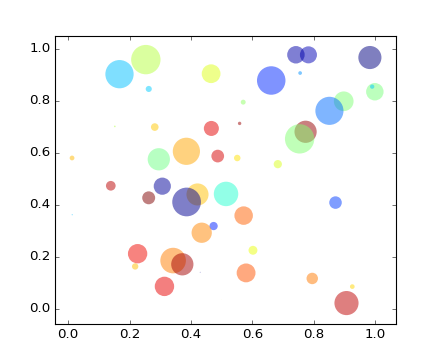
semilogx(*args, **kwargs)¶Make a plot with log scaling on the x axis.
Call signature:
semilogx(*args, **kwargs)
semilogx() supports all the keyword arguments of
plot() and
matplotlib.axes.Axes.set_xscale().
Notable keyword arguments:
- basex: scalar > 1
- Base of the x logarithm
- subsx: [ None | sequence ]
- The location of the minor xticks; None defaults to autosubs, which depend on the number of decades in the plot; see
set_xscale()for details.- nonposx: [ ‘mask’ | ‘clip’ ]
- Non-positive values in x can be masked as invalid, or clipped to a very small positive number
The remaining valid kwargs are
Line2D properties:
Property Description agg_filterunknown alphafloat (0.0 transparent through 1.0 opaque) animated[True | False] antialiasedor aa[True | False] axesan Axesinstancebottom_marginunknown clip_boxa matplotlib.transforms.Bboxinstanceclip_on[True | False] clip_path[ ( Path,Transform) |Patch| None ]coloror cany matplotlib color containsa callable function dash_capstyle[‘butt’ | ‘round’ | ‘projecting’] dash_joinstyle[‘miter’ | ‘round’ | ‘bevel’] dashessequence of on/off ink in points drawstyle[‘default’ | ‘steps’ | ‘steps-pre’ | ‘steps-mid’ | ‘steps-post’] figurea matplotlib.figure.Figureinstancefillstyle[‘full’ | ‘left’ | ‘right’ | ‘bottom’ | ‘top’ | ‘none’] gidan id string labelstring or anything printable with ‘%s’ conversion. left_marginunknown linestyleor ls[‘solid’ | ‘dashed’, ‘dashdot’, ‘dotted’ | (offset, on-off-dash-seq) | '-'|'--'|'-.'|':'|'None'|' '|'']linewidthor lwfloat value in points marginsunknown markerA valid marker stylemarkeredgecoloror mecany matplotlib color markeredgewidthor mewfloat value in points markerfacecoloror mfcany matplotlib color markerfacecoloraltor mfcaltany matplotlib color markersizeor msfloat markevery[None | int | length-2 tuple of int | slice | list/array of int | float | length-2 tuple of float] path_effectsunknown pickerfloat distance in points or callable pick function fn(artist, event)pickradiusfloat distance in points rasterized[True | False | None] right_marginunknown sketch_paramsunknown snapunknown solid_capstyle[‘butt’ | ‘round’ | ‘projecting’] solid_joinstyle[‘miter’ | ‘round’ | ‘bevel’] top_marginunknown transforma matplotlib.transforms.Transforminstanceurla url string visible[True | False] xdata1D array ydata1D array zorderany number
See also
loglog()semilogy(*args, **kwargs)¶Make a plot with log scaling on the y axis.
call signature:
semilogy(*args, **kwargs)
semilogy() supports all the keyword arguments of
plot() and
matplotlib.axes.Axes.set_yscale().
Notable keyword arguments:
- basey: scalar > 1
- Base of the y logarithm
- subsy: [ None | sequence ]
- The location of the minor yticks; None defaults to autosubs, which depend on the number of decades in the plot; see
set_yscale()for details.- nonposy: [ ‘mask’ | ‘clip’ ]
- Non-positive values in y can be masked as invalid, or clipped to a very small positive number
The remaining valid kwargs are
Line2D properties:
Property Description agg_filterunknown alphafloat (0.0 transparent through 1.0 opaque) animated[True | False] antialiasedor aa[True | False] axesan Axesinstancebottom_marginunknown clip_boxa matplotlib.transforms.Bboxinstanceclip_on[True | False] clip_path[ ( Path,Transform) |Patch| None ]coloror cany matplotlib color containsa callable function dash_capstyle[‘butt’ | ‘round’ | ‘projecting’] dash_joinstyle[‘miter’ | ‘round’ | ‘bevel’] dashessequence of on/off ink in points drawstyle[‘default’ | ‘steps’ | ‘steps-pre’ | ‘steps-mid’ | ‘steps-post’] figurea matplotlib.figure.Figureinstancefillstyle[‘full’ | ‘left’ | ‘right’ | ‘bottom’ | ‘top’ | ‘none’] gidan id string labelstring or anything printable with ‘%s’ conversion. left_marginunknown linestyleor ls[‘solid’ | ‘dashed’, ‘dashdot’, ‘dotted’ | (offset, on-off-dash-seq) | '-'|'--'|'-.'|':'|'None'|' '|'']linewidthor lwfloat value in points marginsunknown markerA valid marker stylemarkeredgecoloror mecany matplotlib color markeredgewidthor mewfloat value in points markerfacecoloror mfcany matplotlib color markerfacecoloraltor mfcaltany matplotlib color markersizeor msfloat markevery[None | int | length-2 tuple of int | slice | list/array of int | float | length-2 tuple of float] path_effectsunknown pickerfloat distance in points or callable pick function fn(artist, event)pickradiusfloat distance in points rasterized[True | False | None] right_marginunknown sketch_paramsunknown snapunknown solid_capstyle[‘butt’ | ‘round’ | ‘projecting’] solid_joinstyle[‘miter’ | ‘round’ | ‘bevel’] top_marginunknown transforma matplotlib.transforms.Transforminstanceurla url string visible[True | False] xdata1D array ydata1D array zorderany number
See also
loglog()set(**kwargs)¶A property batch setter. Pass kwargs to set properties.
set_adjustable(adjustable)¶ACCEPTS: [ ‘box’ | ‘datalim’ | ‘box-forced’]
set_agg_filter(filter_func)¶set agg_filter fuction.
set_alpha(alpha)¶Set the alpha value used for blending - not supported on all backends.
ACCEPTS: float (0.0 transparent through 1.0 opaque)
set_anchor(anchor)¶anchor
value description ‘C’ Center ‘SW’ bottom left ‘S’ bottom ‘SE’ bottom right ‘E’ right ‘NE’ top right ‘N’ top ‘NW’ top left ‘W’ left
set_animated(b)¶Set the artist’s animation state.
ACCEPTS: [True | False]
set_aspect(aspect, adjustable=None, anchor=None)¶aspect
value description ‘auto’ automatic; fill position rectangle with data ‘normal’ same as ‘auto’; deprecated ‘equal’ same scaling from data to plot units for x and y num a circle will be stretched such that the height is num times the width. aspect=1 is the same as aspect=’equal’.
adjustable
value description ‘box’ change physical size of axes ‘datalim’ change xlim or ylim ‘box-forced’ same as ‘box’, but axes can be shared
‘box’ does not allow axes sharing, as this can cause unintended side effect. For cases when sharing axes is fine, use ‘box-forced’.
anchor
value description ‘C’ centered ‘SW’ lower left corner ‘S’ middle of bottom edge ‘SE’ lower right corner etc.
Deprecated since version 1.2: the option ‘normal’ for aspect is deprecated. Use ‘auto’ instead.
set_autoscale_on(b)¶Set whether autoscaling is applied on plot commands
accepts: [ True | False ]
set_autoscalex_on(b)¶Set whether autoscaling for the x-axis is applied on plot commands
accepts: [ True | False ]
set_autoscaley_on(b)¶Set whether autoscaling for the y-axis is applied on plot commands
accepts: [ True | False ]
set_axes(axes)¶Set the Axes instance in which the
artist resides, if any.
This has been deprecated in mpl 1.5, please use the axes property. Will be removed in 1.7 or 2.0.
ACCEPTS: an Axes instance
set_axes_locator(locator)¶set axes_locator
set_axis_bgcolor(color)¶Deprecated since version 2.0: The set_axis_bgcolor function was deprecated in version 2.0. Use set_facecolor instead.
set the axes background color
ACCEPTS: any matplotlib color - see
colors()
set_axis_off()¶turn off the axis
set_axis_on()¶turn on the axis
set_axisbelow(b)¶Set whether the axis ticks and gridlines are above or below most artists
ACCEPTS: [ True | False ]
set_bottom_margin(margin)¶Set whether a margin should be applied to the bottom of the Artist.
set_clip_box(clipbox)¶Set the artist’s clip Bbox.
ACCEPTS: a matplotlib.transforms.Bbox instance
set_clip_on(b)¶Set whether artist uses clipping.
When False artists will be visible out side of the axes which can lead to unexpected results.
ACCEPTS: [True | False]
set_clip_path(path, transform=None)¶Set the artist’s clip path, which may be:
For efficiency, if the path happens to be an axis-aligned rectangle, this method will set the clipping box to the corresponding rectangle and set the clipping path to None.
set_color_cycle(clist)¶Set the color cycle for any future plot commands on this Axes.
clist is a list of mpl color specifiers.
Deprecated since version 1.5.
set_contains(picker)¶Replace the contains test used by this artist. The new picker should be a callable function which determines whether the artist is hit by the mouse event:
hit, props = picker(artist, mouseevent)
If the mouse event is over the artist, return hit = True and props is a dictionary of properties you want returned with the contains test.
ACCEPTS: a callable function
set_cursor_props(*args)¶Set the cursor property as:
ax.set_cursor_props(linewidth, color)
or:
ax.set_cursor_props((linewidth, color))
ACCEPTS: a (float, color) tuple
set_facecolor(color)¶set_fc(color)¶set_frame_on(b)¶Set whether the axes rectangle patch is drawn
ACCEPTS: [ True | False ]
set_gid(gid)¶Sets the (group) id for the artist
ACCEPTS: an id string
set_label(s)¶Set the label to s for auto legend.
ACCEPTS: string or anything printable with ‘%s’ conversion.
set_left_margin(margin)¶Set whether a margin should be applied to the left of the Artist.
set_margins(margins)¶Set the dictionary describing whether a margin should be applied on
each of the sides (top, bottom, left and right). Missing keys are
assumed to be True. If True or False are passed in, all
sides are set to that value.
Set whether the axes responds to navigation toolbar commands
ACCEPTS: [ True | False ]
Set the navigation toolbar button status;
Warning
this is not a user-API function.
set_path_effects(path_effects)¶set path_effects, which should be a list of instances of matplotlib.patheffect._Base class or its derivatives.
set_picker(picker)¶Set the epsilon for picking used by this artist
picker can be one of the following:
None: picking is disabled for this artist (default)
A boolean: if True then picking will be enabled and the artist will fire a pick event if the mouse event is over the artist
A float: if picker is a number it is interpreted as an epsilon tolerance in points and the artist will fire off an event if it’s data is within epsilon of the mouse event. For some artists like lines and patch collections, the artist may provide additional data to the pick event that is generated, e.g., the indices of the data within epsilon of the pick event
A function: if picker is callable, it is a user supplied function which determines whether the artist is hit by the mouse event:
hit, props = picker(artist, mouseevent)to determine the hit test. if the mouse event is over the artist, return hit=True and props is a dictionary of properties you want added to the PickEvent attributes.
ACCEPTS: [None|float|boolean|callable]
set_position(pos, which='both')¶Set the axes position with:
pos = [left, bottom, width, height]
in relative 0,1 coords, or pos can be a
Bbox
There are two position variables: one which is ultimately
used, but which may be modified by apply_aspect(), and a
second which is the starting point for apply_aspect().
which
value description ‘active’ to change the first ‘original’ to change the second ‘both’ to change both
set_prop_cycle(*args, **kwargs)¶Set the property cycle for any future plot commands on this Axes.
set_prop_cycle(arg) set_prop_cycle(label, itr) set_prop_cycle(label1=itr1[, label2=itr2[, ...]])
Form 1 simply sets given Cycler object.
Form 2 creates and sets a Cycler from a label and an iterable.
Form 3 composes and sets a Cycler as an inner product of the
pairs of keyword arguments. In other words, all of the
iterables are cycled simultaneously, as if through zip().
| Parameters: | arg : Cycler
label : str
itr : iterable
|
|---|
set_rasterization_zorder(z)¶Set zorder value below which artists will be rasterized. Set
to None to disable rasterizing of artists below a particular
zorder.
set_rasterized(rasterized)¶Force rasterized (bitmap) drawing in vector backend output.
Defaults to None, which implies the backend’s default behavior
ACCEPTS: [True | False | None]
set_right_margin(margin)¶Set whether a margin should be applied to the right of the Artist.
set_sketch_params(scale=None, length=None, randomness=None)¶Sets the sketch parameters.
| Parameters: | scale : float, optional
length : float, optional
randomness : float, optional
|
|---|
set_snap(snap)¶Sets the snap setting which may be:
- True: snap vertices to the nearest pixel center
- False: leave vertices as-is
- None: (auto) If the path contains only rectilinear line segments, round to the nearest pixel center
Only supported by the Agg and MacOSX backends.
set_title(label, fontdict=None, loc='center', **kwargs)¶Set a title for the axes.
Set one of the three available axes titles. The available titles are positioned above the axes in the center, flush with the left edge, and flush with the right edge.
| Parameters: | label : str
fontdict : dict
loc : {‘center’, ‘left’, ‘right’}, str, optional
|
|---|---|
| Returns: | text :
|
| Other Parameters: | |
kwargs : text properties
|
|
set_top_margin(margin)¶Set whether a margin should be applied to the top of the Artist.
set_url(url)¶Sets the url for the artist
ACCEPTS: a url string
set_visible(b)¶Set the artist’s visiblity.
ACCEPTS: [True | False]
set_xbound(lower=None, upper=None)¶Set the lower and upper numerical bounds of the x-axis. This method will honor axes inversion regardless of parameter order. It will not change the _autoscaleXon attribute.
set_xlabel(xlabel, fontdict=None, labelpad=None, **kwargs)¶Set the label for the xaxis.
| Parameters: | xlabel : string
labelpad : scalar, optional, default: None
|
|---|---|
| Other Parameters: | |
kwargs : |
|
See also
textset_xlim(left=None, right=None, emit=True, auto=False, **kw)¶Call signature:
set_xlim(self, *args, **kwargs):
Set the data limits for the xaxis
Examples:
set_xlim((left, right))
set_xlim(left, right)
set_xlim(left=1) # right unchanged
set_xlim(right=1) # left unchanged
Keyword arguments:
- left: scalar
- The left xlim; xmin, the previous name, may still be used
- right: scalar
- The right xlim; xmax, the previous name, may still be used
- emit: [ True | False ]
- Notify observers of limit change
- auto: [ True | False | None ]
- Turn x autoscaling on (True), off (False; default), or leave unchanged (None)
Note, the left (formerly xmin) value may be greater than the right (formerly xmax). For example, suppose x is years before present. Then one might use:
set_ylim(5000, 0)
so 5000 years ago is on the left of the plot and the present is on the right.
Returns the current xlimits as a length 2 tuple
ACCEPTS: length 2 sequence of floats
set_xmargin(m)¶Set padding of X data limits prior to autoscaling.
m times the data interval will be added to each end of that interval before it is used in autoscaling.
accepts: float in range 0 to 1
set_xscale(value, **kwargs)¶Call signature:
set_xscale(value)
Set the scaling of the x-axis: ‘linear’ | ‘log’ | ‘logit’ | ‘symlog’
ACCEPTS: [‘linear’ | ‘log’ | ‘logit’ | ‘symlog’]
‘linear’
‘log’
- basex/basey:
- The base of the logarithm
- nonposx/nonposy: [‘mask’ | ‘clip’ ]
- non-positive values in x or y can be masked as invalid, or clipped to a very small positive number
- subsx/subsy:
Where to place the subticks between each major tick. Should be a sequence of integers. For example, in a log10 scale:
[2, 3, 4, 5, 6, 7, 8, 9]will place 8 logarithmically spaced minor ticks between each major tick.
‘logit’
- nonpos: [‘mask’ | ‘clip’ ]
- values beyond ]0, 1[ can be masked as invalid, or clipped to a number very close to 0 or 1
‘symlog’
- basex/basey:
- The base of the logarithm
- linthreshx/linthreshy:
- The range (-x, x) within which the plot is linear (to avoid having the plot go to infinity around zero).
- subsx/subsy:
Where to place the subticks between each major tick. Should be a sequence of integers. For example, in a log10 scale:
[2, 3, 4, 5, 6, 7, 8, 9]will place 8 logarithmically spaced minor ticks between each major tick.
- linscalex/linscaley:
- This allows the linear range (-linthresh to linthresh) to be stretched relative to the logarithmic range. Its value is the number of decades to use for each half of the linear range. For example, when linscale == 1.0 (the default), the space used for the positive and negative halves of the linear range will be equal to one decade in the logarithmic range.
set_xticklabels(labels, fontdict=None, minor=False, **kwargs)¶Call signature:
set_xticklabels(labels, fontdict=None, minor=False, **kwargs)
Set the xtick labels with list of strings labels. Return a list of axis text instances.
kwargs set the Text properties.
Valid properties are
Property Description agg_filterunknown alphafloat (0.0 transparent through 1.0 opaque) animated[True | False] axesan Axesinstancebackgroundcolorany matplotlib color bboxFancyBboxPatch prop dict bottom_marginunknown clip_boxa matplotlib.transforms.Bboxinstanceclip_on[True | False] clip_path[ ( Path,Transform) |Patch| None ]colorany matplotlib color containsa callable function familyor fontfamily or fontname or name[FONTNAME | ‘serif’ | ‘sans-serif’ | ‘cursive’ | ‘fantasy’ | ‘monospace’ ] figurea matplotlib.figure.Figureinstancefontpropertiesor font_propertiesa matplotlib.font_manager.FontPropertiesinstancegidan id string horizontalalignmentor ha[ ‘center’ | ‘right’ | ‘left’ ] labelstring or anything printable with ‘%s’ conversion. left_marginunknown linespacingfloat (multiple of font size) marginsunknown multialignment[‘left’ | ‘right’ | ‘center’ ] path_effectsunknown picker[None|float|boolean|callable] position(x,y) rasterized[True | False | None] right_marginunknown rotation[ angle in degrees | ‘vertical’ | ‘horizontal’ ] rotation_modeunknown sizeor fontsize[size in points | ‘xx-small’ | ‘x-small’ | ‘small’ | ‘medium’ | ‘large’ | ‘x-large’ | ‘xx-large’ ] sketch_paramsunknown snapunknown stretchor fontstretch[a numeric value in range 0-1000 | ‘ultra-condensed’ | ‘extra-condensed’ | ‘condensed’ | ‘semi-condensed’ | ‘normal’ | ‘semi-expanded’ | ‘expanded’ | ‘extra-expanded’ | ‘ultra-expanded’ ] styleor fontstyle[ ‘normal’ | ‘italic’ | ‘oblique’] textstring or anything printable with ‘%s’ conversion. top_marginunknown transformTransforminstanceurla url string usetexunknown variantor fontvariant[ ‘normal’ | ‘small-caps’ ] verticalalignmentor va or ma[ ‘center’ | ‘top’ | ‘bottom’ | ‘baseline’ ] visible[True | False] weightor fontweight[a numeric value in range 0-1000 | ‘ultralight’ | ‘light’ | ‘normal’ | ‘regular’ | ‘book’ | ‘medium’ | ‘roman’ | ‘semibold’ | ‘demibold’ | ‘demi’ | ‘bold’ | ‘heavy’ | ‘extra bold’ | ‘black’ ] wrapunknown xfloat yfloat zorderany number
ACCEPTS: sequence of strings
set_xticks(ticks, minor=False)¶Set the x ticks with list of ticks
ACCEPTS: sequence of floats
set_ybound(lower=None, upper=None)¶Set the lower and upper numerical bounds of the y-axis. This method will honor axes inversion regardless of parameter order. It will not change the _autoscaleYon attribute.
set_ylabel(ylabel, fontdict=None, labelpad=None, **kwargs)¶Set the label for the yaxis
| Parameters: | ylabel : string
labelpad : scalar, optional, default: None
|
|---|---|
| Other Parameters: | |
kwargs : |
|
See also
textset_ylim(bottom=None, top=None, emit=True, auto=False, **kw)¶Call signature:
set_ylim(self, *args, **kwargs):
Set the data limits for the yaxis
Examples:
set_ylim((bottom, top))
set_ylim(bottom, top)
set_ylim(bottom=1) # top unchanged
set_ylim(top=1) # bottom unchanged
Keyword arguments:
- bottom: scalar
- The bottom ylim; the previous name, ymin, may still be used
- top: scalar
- The top ylim; the previous name, ymax, may still be used
- emit: [ True | False ]
- Notify observers of limit change
- auto: [ True | False | None ]
- Turn y autoscaling on (True), off (False; default), or leave unchanged (None)
Note, the bottom (formerly ymin) value may be greater than the top (formerly ymax). For example, suppose y is depth in the ocean. Then one might use:
set_ylim(5000, 0)
so 5000 m depth is at the bottom of the plot and the surface, 0 m, is at the top.
Returns the current ylimits as a length 2 tuple
ACCEPTS: length 2 sequence of floats
set_ymargin(m)¶Set padding of Y data limits prior to autoscaling.
m times the data interval will be added to each end of that interval before it is used in autoscaling.
accepts: float in range 0 to 1
set_yscale(value, **kwargs)¶Call signature:
set_yscale(value)
Set the scaling of the y-axis: ‘linear’ | ‘log’ | ‘logit’ | ‘symlog’
ACCEPTS: [‘linear’ | ‘log’ | ‘logit’ | ‘symlog’]
‘linear’
‘log’
- basex/basey:
- The base of the logarithm
- nonposx/nonposy: [‘mask’ | ‘clip’ ]
- non-positive values in x or y can be masked as invalid, or clipped to a very small positive number
- subsx/subsy:
Where to place the subticks between each major tick. Should be a sequence of integers. For example, in a log10 scale:
[2, 3, 4, 5, 6, 7, 8, 9]will place 8 logarithmically spaced minor ticks between each major tick.
‘logit’
- nonpos: [‘mask’ | ‘clip’ ]
- values beyond ]0, 1[ can be masked as invalid, or clipped to a number very close to 0 or 1
‘symlog’
- basex/basey:
- The base of the logarithm
- linthreshx/linthreshy:
- The range (-x, x) within which the plot is linear (to avoid having the plot go to infinity around zero).
- subsx/subsy:
Where to place the subticks between each major tick. Should be a sequence of integers. For example, in a log10 scale:
[2, 3, 4, 5, 6, 7, 8, 9]will place 8 logarithmically spaced minor ticks between each major tick.
- linscalex/linscaley:
- This allows the linear range (-linthresh to linthresh) to be stretched relative to the logarithmic range. Its value is the number of decades to use for each half of the linear range. For example, when linscale == 1.0 (the default), the space used for the positive and negative halves of the linear range will be equal to one decade in the logarithmic range.
set_yticklabels(labels, fontdict=None, minor=False, **kwargs)¶Call signature:
set_yticklabels(labels, fontdict=None, minor=False, **kwargs)
Set the y tick labels with list of strings labels. Return a list of
Text instances.
kwargs set Text properties for the labels.
Valid properties are
Property Description agg_filterunknown alphafloat (0.0 transparent through 1.0 opaque) animated[True | False] axesan Axesinstancebackgroundcolorany matplotlib color bboxFancyBboxPatch prop dict bottom_marginunknown clip_boxa matplotlib.transforms.Bboxinstanceclip_on[True | False] clip_path[ ( Path,Transform) |Patch| None ]colorany matplotlib color containsa callable function familyor fontfamily or fontname or name[FONTNAME | ‘serif’ | ‘sans-serif’ | ‘cursive’ | ‘fantasy’ | ‘monospace’ ] figurea matplotlib.figure.Figureinstancefontpropertiesor font_propertiesa matplotlib.font_manager.FontPropertiesinstancegidan id string horizontalalignmentor ha[ ‘center’ | ‘right’ | ‘left’ ] labelstring or anything printable with ‘%s’ conversion. left_marginunknown linespacingfloat (multiple of font size) marginsunknown multialignment[‘left’ | ‘right’ | ‘center’ ] path_effectsunknown picker[None|float|boolean|callable] position(x,y) rasterized[True | False | None] right_marginunknown rotation[ angle in degrees | ‘vertical’ | ‘horizontal’ ] rotation_modeunknown sizeor fontsize[size in points | ‘xx-small’ | ‘x-small’ | ‘small’ | ‘medium’ | ‘large’ | ‘x-large’ | ‘xx-large’ ] sketch_paramsunknown snapunknown stretchor fontstretch[a numeric value in range 0-1000 | ‘ultra-condensed’ | ‘extra-condensed’ | ‘condensed’ | ‘semi-condensed’ | ‘normal’ | ‘semi-expanded’ | ‘expanded’ | ‘extra-expanded’ | ‘ultra-expanded’ ] styleor fontstyle[ ‘normal’ | ‘italic’ | ‘oblique’] textstring or anything printable with ‘%s’ conversion. top_marginunknown transformTransforminstanceurla url string usetexunknown variantor fontvariant[ ‘normal’ | ‘small-caps’ ] verticalalignmentor va or ma[ ‘center’ | ‘top’ | ‘bottom’ | ‘baseline’ ] visible[True | False] weightor fontweight[a numeric value in range 0-1000 | ‘ultralight’ | ‘light’ | ‘normal’ | ‘regular’ | ‘book’ | ‘medium’ | ‘roman’ | ‘semibold’ | ‘demibold’ | ‘demi’ | ‘bold’ | ‘heavy’ | ‘extra bold’ | ‘black’ ] wrapunknown xfloat yfloat zorderany number
ACCEPTS: sequence of strings
set_yticks(ticks, minor=False)¶Set the y ticks with list of ticks
ACCEPTS: sequence of floats
Keyword arguments:
- minor: [ False | True ]
- Sets the minor ticks if True
set_zorder(level)¶Set the zorder for the artist. Artists with lower zorder values are drawn first.
ACCEPTS: any number
specgram(x, NFFT=None, Fs=None, Fc=None, detrend=None, window=None, noverlap=None, cmap=None, xextent=None, pad_to=None, sides=None, scale_by_freq=None, mode=None, scale=None, vmin=None, vmax=None, **kwargs)¶Plot a spectrogram.
Call signature:
specgram(x, NFFT=256, Fs=2, Fc=0, detrend=mlab.detrend_none,
window=mlab.window_hanning, noverlap=128,
cmap=None, xextent=None, pad_to=None, sides='default',
scale_by_freq=None, mode='default', scale='default',
**kwargs)
Compute and plot a spectrogram of data in x. Data are split into NFFT length segments and the spectrum of each section is computed. The windowing function window is applied to each segment, and the amount of overlap of each segment is specified with noverlap. The spectrogram is plotted as a colormap (using imshow).
Keyword arguments:
- Fs: scalar
- The sampling frequency (samples per time unit). It is used to calculate the Fourier frequencies, freqs, in cycles per time unit. The default value is 2.
- window: callable or ndarray
- A function or a vector of length NFFT. To create window vectors see
window_hanning(),window_none(),numpy.blackman(),numpy.hamming(),numpy.bartlett(),scipy.signal(),scipy.signal.get_window(), etc. The default iswindow_hanning(). If a function is passed as the argument, it must take a data segment as an argument and return the windowed version of the segment.- sides: [ ‘default’ | ‘onesided’ | ‘twosided’ ]
- Specifies which sides of the spectrum to return. Default gives the default behavior, which returns one-sided for real data and both for complex data. ‘onesided’ forces the return of a one-sided spectrum, while ‘twosided’ forces two-sided.
callable
The function applied to each segment before fft-ing,
designed to remove the mean or linear trend. Unlike in
MATLAB, where the detrend parameter is a vector, in
matplotlib is it a function. The pylab
module defines detrend_none(),
detrend_mean(), and
detrend_linear(), but you can use
a custom function as well. You can also use a string to choose
one of the functions. ‘default’, ‘constant’, and ‘mean’ call
detrend_mean(). ‘linear’ calls
detrend_linear(). ‘none’ calls
detrend_none().
Specifies whether the resulting density values should be scaled by the scaling frequency, which gives density in units of Hz^-1. This allows for integration over the returned frequency values. The default is True for MATLAB compatibility.
matplotlib.colors.Colormap instance; if None, use
default determined by rcspecgram()Note
detrend and scale_by_freq only apply when mode is set to ‘psd’
Returns the tuple (spectrum, freqs, t, im):
- spectrum: 2-D array
- columns are the periodograms of successive segments
- freqs: 1-D array
- The frequencies corresponding to the rows in spectrum
- t: 1-D array
- The times corresponding to midpoints of segments (i.e the columns in spectrum)
- im: instance of class
AxesImage- The image created by imshow containing the spectrogram
Example:
(Source code, png)
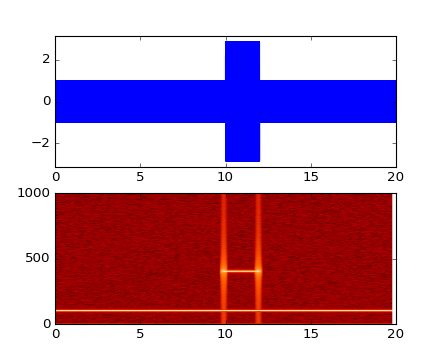
See also
psd()psd() differs in the default overlap; in returning
the mean of the segment periodograms; in not returning
times; and in generating a line plot instead of colormap.magnitude_spectrum()angle_spectrum()phase_spectrum()Notes
In addition to the above described arguments, this function can take a data keyword argument. If such a data argument is given, the following arguments are replaced by data[<arg>]:
spy(Z, precision=0, marker=None, markersize=None, aspect='equal', origin='upper', **kwargs)¶Plot the sparsity pattern on a 2-D array.
spy(Z) plots the sparsity pattern of the 2-D array Z.
| Parameters: | Z : sparse array (n, m)
precision : float, optional, default: 0
origin : [“upper”, “lower”], optional, default: “upper”
aspect : [‘auto’ | ‘equal’ | scalar], optional, default: “equal”
Two plotting styles are available: image or marker. Both are available for full arrays, but only the marker style works for :class:`scipy.sparse.spmatrix` instances. If *marker* and *markersize* are *None*, an image will be returned and any remaining kwargs are passed to :func:`~matplotlib.pyplot.imshow`; else, a :class:`~matplotlib.lines.Line2D` object will be returned with the value of marker determining the marker type, and any remaining kwargs passed to the :meth:`~matplotlib.axes.Axes.plot` method. If *marker* and *markersize* are *None*, useful kwargs include: * *cmap* * *alpha* |
|---|
See also
imshowplotstackplot(x, *args, **kwargs)¶Draws a stacked area plot.
x : 1d array of dimension N
1xN. The data is assumed to be unstacked. Each of the following calls is legal:
stackplot(x, y) # where y is MxN
stackplot(x, y1, y2, y3, y4) # where y1, y2, y3, y4, are all 1xNm
Keyword arguments:
ThemeRiver. ‘wiggle’ minimizes the
sum of the squared slopes. ‘weighted_wiggle’ does the
same but weights to account for size of each layer.
It is also called Streamgraph-layout. More details
can be found at http://www.leebyron.com/else/streamgraph/.labels : A list or tuple of labels to assign to each data series.
fill_between()Returns r : A list of
PolyCollection, one for each
element in the stacked area plot.
stale¶If the artist is ‘stale’ and needs to be re-drawn for the output to match the internal state of the artist.
start_pan(x, y, button)¶Called when a pan operation has started.
x, y are the mouse coordinates in display coords. button is the mouse button number:
Note
Intended to be overridden by new projection types.
stem(*args, **kwargs)¶Create a stem plot.
Call signatures:
stem(y, linefmt='b-', markerfmt='bo', basefmt='r-')
stem(x, y, linefmt='b-', markerfmt='bo', basefmt='r-')
A stem plot plots vertical lines (using linefmt) at each x location from the baseline to y, and places a marker there using markerfmt. A horizontal line at 0 is is plotted using basefmt.
If no x values are provided, the default is (0, 1, ..., len(y) - 1)
Return value is a tuple (markerline, stemlines, baseline).
See also
This document for details.
Example:
(Source code, png)
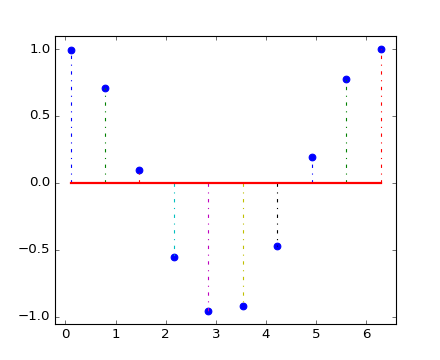
Notes
In addition to the above described arguments, this function can take a data keyword argument. If such a data argument is given, the following arguments are replaced by data[<arg>]:
step(x, y, *args, **kwargs)¶Make a step plot.
Call signature:
step(x, y, *args, **kwargs)
Additional keyword args to step() are the same as those
for plot().
x and y must be 1-D sequences, and it is assumed, but not checked, that x is uniformly increasing.
Keyword arguments:
If ‘pre’ (the default), the interval from x[i] to x[i+1] has level y[i+1].
If ‘post’, that interval has level y[i].
If ‘mid’, the jumps in y occur half-way between the x-values.
Return value is a list of lines that were added.
Notes
In addition to the above described arguments, this function can take a data keyword argument. If such a data argument is given, the following arguments are replaced by data[<arg>]:
streamplot(x, y, u, v, density=1, linewidth=None, color=None, cmap=None, norm=None, arrowsize=1, arrowstyle='-|>', minlength=0.1, transform=None, zorder=2, start_points=None)¶Draws streamlines of a vector flow.
density = 1, the domain
is divided into a 30x30 grid—density linearly scales this grid.
Each cell in the grid can have, at most, one traversing streamline.
For different densities in each direction, use [density_x, density_y].ColormapNormalizeFancyArrowPatch.x and y arrays.Returns:
- stream_container : StreamplotSet
Container object with attributes
- lines:
matplotlib.collections.LineCollectionof streamlines- arrows: collection of
matplotlib.patches.FancyArrowPatchobjects representing arrows half-way along stream lines.This container will probably change in the future to allow changes to the colormap, alpha, etc. for both lines and arrows, but these changes should be backward compatible.
table(**kwargs)¶Add a table to the current axes.
Call signature:
table(cellText=None, cellColours=None,
cellLoc='right', colWidths=None,
rowLabels=None, rowColours=None, rowLoc='left',
colLabels=None, colColours=None, colLoc='center',
loc='bottom', bbox=None):
Returns a matplotlib.table.Table instance. For finer
grained control over tables, use the
Table class and add it to the axes
with add_table().
Thanks to John Gill for providing the class and table.
kwargs control the Table
properties:
Property Description agg_filterunknown alphafloat (0.0 transparent through 1.0 opaque) animated[True | False] axesan Axesinstancebottom_marginunknown clip_boxa matplotlib.transforms.Bboxinstanceclip_on[True | False] clip_path[ ( Path,Transform) |Patch| None ]containsa callable function figurea matplotlib.figure.Figureinstancefontsizea float in points gidan id string labelstring or anything printable with ‘%s’ conversion. left_marginunknown marginsunknown path_effectsunknown picker[None|float|boolean|callable] rasterized[True | False | None] right_marginunknown sketch_paramsunknown snapunknown top_marginunknown transformTransforminstanceurla url string visible[True | False] zorderany number
text(x, y, s, fontdict=None, withdash=False, **kwargs)¶Add text to the axes.
Add text in string s to axis at location x, y, data
coordinates.
| Parameters: | x, y : scalars
s : string
fontdict : dictionary, optional, default: None
withdash : boolean, optional, default: False
|
|---|---|
| Other Parameters: | |
kwargs :
|
|
Examples
Individual keyword arguments can be used to override any given parameter:
>>> text(x, y, s, fontsize=12)
The default transform specifies that text is in data coords, alternatively, you can specify text in axis coords (0,0 is lower-left and 1,1 is upper-right). The example below places text in the center of the axes:
>>> text(0.5, 0.5,'matplotlib', horizontalalignment='center',
... verticalalignment='center',
... transform=ax.transAxes)
You can put a rectangular box around the text instance (e.g., to
set a background color) by using the keyword bbox. bbox is
a dictionary of Rectangle
properties. For example:
>>> text(x, y, s, bbox=dict(facecolor='red', alpha=0.5))
tick_params(axis='both', **kwargs)¶Change the appearance of ticks and tick labels.
Keyword arguments:
Example:
ax.tick_params(direction='out', length=6, width=2, colors='r')
This will make all major ticks be red, pointing out of the box, and with dimensions 6 points by 2 points. Tick labels will also be red.
ticklabel_format(**kwargs)¶Change the ScalarFormatter used by
default for linear axes.
Optional keyword arguments:
Keyword Description style [ ‘sci’ (or ‘scientific’) | ‘plain’ ] plain turns off scientific notation scilimits (m, n), pair of integers; if style is ‘sci’, scientific notation will be used for numbers outside the range 10`m`:sup: to 10`n`:sup:. Use (0,0) to include all numbers. useOffset [True | False | offset]; if True, the offset will be calculated as needed; if False, no offset will be used; if a numeric offset is specified, it will be used. axis [ ‘x’ | ‘y’ | ‘both’ ] useLocale If True, format the number according to the current locale. This affects things such as the character used for the decimal separator. If False, use C-style (English) formatting. The default setting is controlled by the axes.formatter.use_locale rcparam.
Only the major ticks are affected.
If the method is called when the
ScalarFormatter is not the
Formatter being used, an
AttributeError will be raised.
top_margin¶Get whether a margin should be applied to the top of the Artist.
tricontour(*args, **kwargs)¶Draw contours on an unstructured triangular grid.
tricontour() and
tricontourf() draw contour lines and
filled contours, respectively. Except as noted, function
signatures and return values are the same for both versions.
The triangulation can be specified in one of two ways; either:
tricontour(triangulation, ...)
where triangulation is a matplotlib.tri.Triangulation
object, or
tricontour(x, y, ...)
tricontour(x, y, triangles, ...)
tricontour(x, y, triangles=triangles, ...)
tricontour(x, y, mask=mask, ...)
tricontour(x, y, triangles, mask=mask, ...)
in which case a Triangulation object will be created. See
Triangulation for a explanation of
these possibilities.
The remaining arguments may be:
tricontour(..., Z)
where Z is the array of values to contour, one per point in the triangulation. The level values are chosen automatically.
tricontour(..., Z, N)
contour N automatically-chosen levels.
tricontour(..., Z, V)
draw contour lines at the values specified in sequence V, which must be in increasing order.
tricontourf(..., Z, V)
fill the (len(V)-1) regions between the values in V, which must be in increasing order.
tricontour(Z, **kwargs)
Use keyword args to control colors, linewidth, origin, cmap ... see below for more details.
C = tricontour(...) returns a
TriContourSet object.
Optional keyword arguments:
- colors: [ None | string | (mpl_colors) ]
If None, the colormap specified by cmap will be used.
If a string, like ‘r’ or ‘red’, all levels will be plotted in this color.
If a tuple of matplotlib color args (string, float, rgb, etc), different levels will be plotted in different colors in the order specified.
- alpha: float
- The alpha blending value
- cmap: [ None | Colormap ]
- A cm
Colormapinstance or None. If cmap is None and colors is None, a default Colormap is used.- norm: [ None | Normalize ]
- A
matplotlib.colors.Normalizeinstance for scaling data values to colors. If norm is None and colors is None, the default linear scaling is used.- levels [level0, level1, ..., leveln]
- A list of floating point numbers indicating the level curves to draw, in increasing order; e.g., to draw just the zero contour pass
levels=[0]- origin: [ None | ‘upper’ | ‘lower’ | ‘image’ ]
If None, the first value of Z will correspond to the lower left corner, location (0,0). If ‘image’, the rc value for
image.originwill be used.This keyword is not active if X and Y are specified in the call to contour.
extent: [ None | (x0,x1,y0,y1) ]
If origin is not None, then extent is interpreted as in
matplotlib.pyplot.imshow(): it gives the outer pixel boundaries. In this case, the position of Z[0,0] is the center of the pixel, not a corner. If origin is None, then (x0, y0) is the position of Z[0,0], and (x1, y1) is the position of Z[-1,-1].This keyword is not active if X and Y are specified in the call to contour.
- locator: [ None | ticker.Locator subclass ]
- If locator is None, the default
MaxNLocatoris used. The locator is used to determine the contour levels if they are not given explicitly via the V argument.- extend: [ ‘neither’ | ‘both’ | ‘min’ | ‘max’ ]
- Unless this is ‘neither’, contour levels are automatically added to one or both ends of the range so that all data are included. These added ranges are then mapped to the special colormap values which default to the ends of the colormap range, but can be set via
matplotlib.colors.Colormap.set_under()andmatplotlib.colors.Colormap.set_over()methods.- xunits, yunits: [ None | registered units ]
- Override axis units by specifying an instance of a
matplotlib.units.ConversionInterface.
tricontour-only keyword arguments:
- linewidths: [ None | number | tuple of numbers ]
If linewidths is None, the default width in
lines.linewidthinmatplotlibrcis used.If a number, all levels will be plotted with this linewidth.
If a tuple, different levels will be plotted with different linewidths in the order specified
- linestyles: [ None | ‘solid’ | ‘dashed’ | ‘dashdot’ | ‘dotted’ ]
If linestyles is None, the ‘solid’ is used.
linestyles can also be an iterable of the above strings specifying a set of linestyles to be used. If this iterable is shorter than the number of contour levels it will be repeated as necessary.
If contour is using a monochrome colormap and the contour level is less than 0, then the linestyle specified in
contour.negative_linestyleinmatplotlibrcwill be used.
tricontourf-only keyword arguments:
- antialiased: [ True | False ]
- enable antialiasing
Note: tricontourf fills intervals that are closed at the top; that is, for boundaries z1 and z2, the filled region is:
z1 < z <= z2
There is one exception: if the lowest boundary coincides with the minimum value of the z array, then that minimum value will be included in the lowest interval.
Examples:
(png)
(png)
tricontourf(*args, **kwargs)¶Draw contours on an unstructured triangular grid.
tricontour() and
tricontourf() draw contour lines and
filled contours, respectively. Except as noted, function
signatures and return values are the same for both versions.
The triangulation can be specified in one of two ways; either:
tricontour(triangulation, ...)
where triangulation is a matplotlib.tri.Triangulation
object, or
tricontour(x, y, ...)
tricontour(x, y, triangles, ...)
tricontour(x, y, triangles=triangles, ...)
tricontour(x, y, mask=mask, ...)
tricontour(x, y, triangles, mask=mask, ...)
in which case a Triangulation object will be created. See
Triangulation for a explanation of
these possibilities.
The remaining arguments may be:
tricontour(..., Z)
where Z is the array of values to contour, one per point in the triangulation. The level values are chosen automatically.
tricontour(..., Z, N)
contour N automatically-chosen levels.
tricontour(..., Z, V)
draw contour lines at the values specified in sequence V, which must be in increasing order.
tricontourf(..., Z, V)
fill the (len(V)-1) regions between the values in V, which must be in increasing order.
tricontour(Z, **kwargs)
Use keyword args to control colors, linewidth, origin, cmap ... see below for more details.
C = tricontour(...) returns a
TriContourSet object.
Optional keyword arguments:
- colors: [ None | string | (mpl_colors) ]
If None, the colormap specified by cmap will be used.
If a string, like ‘r’ or ‘red’, all levels will be plotted in this color.
If a tuple of matplotlib color args (string, float, rgb, etc), different levels will be plotted in different colors in the order specified.
- alpha: float
- The alpha blending value
- cmap: [ None | Colormap ]
- A cm
Colormapinstance or None. If cmap is None and colors is None, a default Colormap is used.- norm: [ None | Normalize ]
- A
matplotlib.colors.Normalizeinstance for scaling data values to colors. If norm is None and colors is None, the default linear scaling is used.- levels [level0, level1, ..., leveln]
- A list of floating point numbers indicating the level curves to draw, in increasing order; e.g., to draw just the zero contour pass
levels=[0]- origin: [ None | ‘upper’ | ‘lower’ | ‘image’ ]
If None, the first value of Z will correspond to the lower left corner, location (0,0). If ‘image’, the rc value for
image.originwill be used.This keyword is not active if X and Y are specified in the call to contour.
extent: [ None | (x0,x1,y0,y1) ]
If origin is not None, then extent is interpreted as in
matplotlib.pyplot.imshow(): it gives the outer pixel boundaries. In this case, the position of Z[0,0] is the center of the pixel, not a corner. If origin is None, then (x0, y0) is the position of Z[0,0], and (x1, y1) is the position of Z[-1,-1].This keyword is not active if X and Y are specified in the call to contour.
- locator: [ None | ticker.Locator subclass ]
- If locator is None, the default
MaxNLocatoris used. The locator is used to determine the contour levels if they are not given explicitly via the V argument.- extend: [ ‘neither’ | ‘both’ | ‘min’ | ‘max’ ]
- Unless this is ‘neither’, contour levels are automatically added to one or both ends of the range so that all data are included. These added ranges are then mapped to the special colormap values which default to the ends of the colormap range, but can be set via
matplotlib.colors.Colormap.set_under()andmatplotlib.colors.Colormap.set_over()methods.- xunits, yunits: [ None | registered units ]
- Override axis units by specifying an instance of a
matplotlib.units.ConversionInterface.
tricontour-only keyword arguments:
- linewidths: [ None | number | tuple of numbers ]
If linewidths is None, the default width in
lines.linewidthinmatplotlibrcis used.If a number, all levels will be plotted with this linewidth.
If a tuple, different levels will be plotted with different linewidths in the order specified
- linestyles: [ None | ‘solid’ | ‘dashed’ | ‘dashdot’ | ‘dotted’ ]
If linestyles is None, the ‘solid’ is used.
linestyles can also be an iterable of the above strings specifying a set of linestyles to be used. If this iterable is shorter than the number of contour levels it will be repeated as necessary.
If contour is using a monochrome colormap and the contour level is less than 0, then the linestyle specified in
contour.negative_linestyleinmatplotlibrcwill be used.
tricontourf-only keyword arguments:
- antialiased: [ True | False ]
- enable antialiasing
Note: tricontourf fills intervals that are closed at the top; that is, for boundaries z1 and z2, the filled region is:
z1 < z <= z2
There is one exception: if the lowest boundary coincides with the minimum value of the z array, then that minimum value will be included in the lowest interval.
Examples:
(png)
(png)
tripcolor(*args, **kwargs)¶Create a pseudocolor plot of an unstructured triangular grid.
The triangulation can be specified in one of two ways; either:
tripcolor(triangulation, ...)
where triangulation is a matplotlib.tri.Triangulation
object, or
tripcolor(x, y, ...)
tripcolor(x, y, triangles, ...)
tripcolor(x, y, triangles=triangles, ...)
tripcolor(x, y, mask=mask, ...)
tripcolor(x, y, triangles, mask=mask, ...)
in which case a Triangulation object will be created. See
Triangulation for a explanation of these
possibilities.
The next argument must be C, the array of color values, either one per point in the triangulation if color values are defined at points, or one per triangle in the triangulation if color values are defined at triangles. If there are the same number of points and triangles in the triangulation it is assumed that color values are defined at points; to force the use of color values at triangles use the kwarg facecolors*=C instead of just *C.
shading may be ‘flat’ (the default) or ‘gouraud’. If shading is ‘flat’ and C values are defined at points, the color values used for each triangle are from the mean C of the triangle’s three points. If shading is ‘gouraud’ then color values must be defined at points.
The remaining kwargs are the same as for
pcolor().
Example:
triplot(*args, **kwargs)¶Draw a unstructured triangular grid as lines and/or markers.
The triangulation to plot can be specified in one of two ways; either:
triplot(triangulation, ...)
where triangulation is a matplotlib.tri.Triangulation
object, or
triplot(x, y, ...)
triplot(x, y, triangles, ...)
triplot(x, y, triangles=triangles, ...)
triplot(x, y, mask=mask, ...)
triplot(x, y, triangles, mask=mask, ...)
in which case a Triangulation object will be created. See
Triangulation for a explanation of these
possibilities.
The remaining args and kwargs are the same as for
plot().
Return a list of 2 Line2D containing
respectively:
- the lines plotted for triangles edges
- the markers plotted for triangles nodes
Example:
twinx()¶Call signature:
ax = twinx()
create a twin of Axes for generating a plot with a sharex x-axis but independent y axis. The y-axis of self will have ticks on left and the returned axes will have ticks on the right.
Note
For those who are ‘picking’ artists while using twinx, pick events are only called for the artists in the top-most axes.
twiny()¶Call signature:
ax = twiny()
create a twin of Axes for generating a plot with a shared y-axis but independent x axis. The x-axis of self will have ticks on bottom and the returned axes will have ticks on the top.
Note
For those who are ‘picking’ artists while using twiny, pick events are only called for the artists in the top-most axes.
update(props)¶Update the properties of this Artist from the
dictionary prop.
update_datalim(xys, updatex=True, updatey=True)¶Update the data lim bbox with seq of xy tups or equiv. 2-D array
update_datalim_numerix(x, y)¶Update the data lim bbox with seq of xy tups
update_from(other)¶Copy properties from other to self.
violin(vpstats, positions=None, vert=True, widths=0.5, showmeans=False, showextrema=True, showmedians=False)¶Drawing function for violin plots.
Call signature:
violin(vpstats, positions=None, vert=True, widths=0.5,
showmeans=False, showextrema=True, showmedians=False):
Draw a violin plot for each column of vpstats. Each filled area
extends to represent the entire data range, with optional lines at the
mean, the median, the minimum, and the maximum.
| Parameters: | vpstats : list of dicts
positions : array-like, default = [1, 2, ..., n]
vert : bool, default = True.
widths : array-like, default = 0.5
showmeans : bool, default = False
showextrema : bool, default = True
showmedians : bool, default = False
|
|---|---|
| Returns: | result : dict
|
violinplot(dataset, positions=None, vert=True, widths=0.5, showmeans=False, showextrema=True, showmedians=False, points=100, bw_method=None)¶Make a violin plot.
Call signature:
violinplot(dataset, positions=None, vert=True, widths=0.5, showmeans=False, showextrema=True, showmedians=False, points=100, bw_method=None):Make a violin plot for each column of dataset or each vector in sequence dataset. Each filled area extends to represent the entire data range, with optional lines at the mean, the median, the minimum, and the maximum.
| Parameters: | dataset : Array or a sequence of vectors.
|
|---|---|
| Returns: | result : dict
|
Notes
In addition to the above described arguments, this function can take a data keyword argument. If such a data argument is given, the following arguments are replaced by data[<arg>]:
vlines(x, ymin, ymax, colors='k', linestyles='solid', label='', **kwargs)¶Plot vertical lines.
Plot vertical lines at each x from ymin to ymax.
| Parameters: | x : scalar or 1D array_like
ymin, ymax : scalar or 1D array_like
colors : array_like of colors, optional, default: ‘k’ linestyles : [‘solid’ | ‘dashed’ | ‘dashdot’ | ‘dotted’], optional label : string, optional, default: ‘’ |
|---|---|
| Returns: | lines : |
| Other Parameters: | |
kwargs : |
|
See also
hlinesNotes
In addition to the above described arguments, this function can take a data keyword argument. If such a data argument is given, the following arguments are replaced by data[<arg>]:
Examples
(Source code, png)

xaxis_date(tz=None)¶Sets up x-axis ticks and labels that treat the x data as dates.
tz is a timezone string or tzinfo instance.
Defaults to rc value.
xaxis_inverted()¶Returns True if the x-axis is inverted.
xcorr(x, y, normed=True, detrend=<function detrend_none>, usevlines=True, maxlags=10, **kwargs)¶Plot the cross correlation between x and y.
| Parameters: | x : sequence of scalars of length n y : sequence of scalars of length n hold : boolean, optional, default: True detrend : callable, optional, default:
normed : boolean, optional, default: True
usevlines : boolean, optional, default: True
maxlags : integer, optional, default: 10
|
|---|---|
| Returns: | (lags, c, line, b) : where:
|
| Other Parameters: | |
linestyle :
marker : string, optional, default: ‘o’ |
|
Notes
In addition to the above described arguments, this function can take a data keyword argument. If such a data argument is given, the following arguments are replaced by data[<arg>]:
yaxis_date(tz=None)¶Sets up y-axis ticks and labels that treat the y data as dates.
tz is a timezone string or tzinfo instance.
Defaults to rc value.
yaxis_inverted()¶Returns True if the y-axis is inverted.
zorder = 0¶